In this issue:
WHEAT MILLING INNOVATION:
Well-established systems and technologies in pasta production
- Wheat, bread, gluten and health: Where do we stand in 2024?
- Efficient dough testing with the Brabender FarinoGraph
- Endotoxins and heat stress - not your cows’ best friends
- Moving Beyond Break/Fix to Prevent Downtime of Critical Animal Feed Conveyors




Milling and Grain . Volume 135 . Issue 6 . June 2024 millingandgrain.com June 2024 Proud supporter of Download the Milling and Grain app to your smart phone
GLOBAL
Volume 135 Issue 6
YOUR
PARTNER


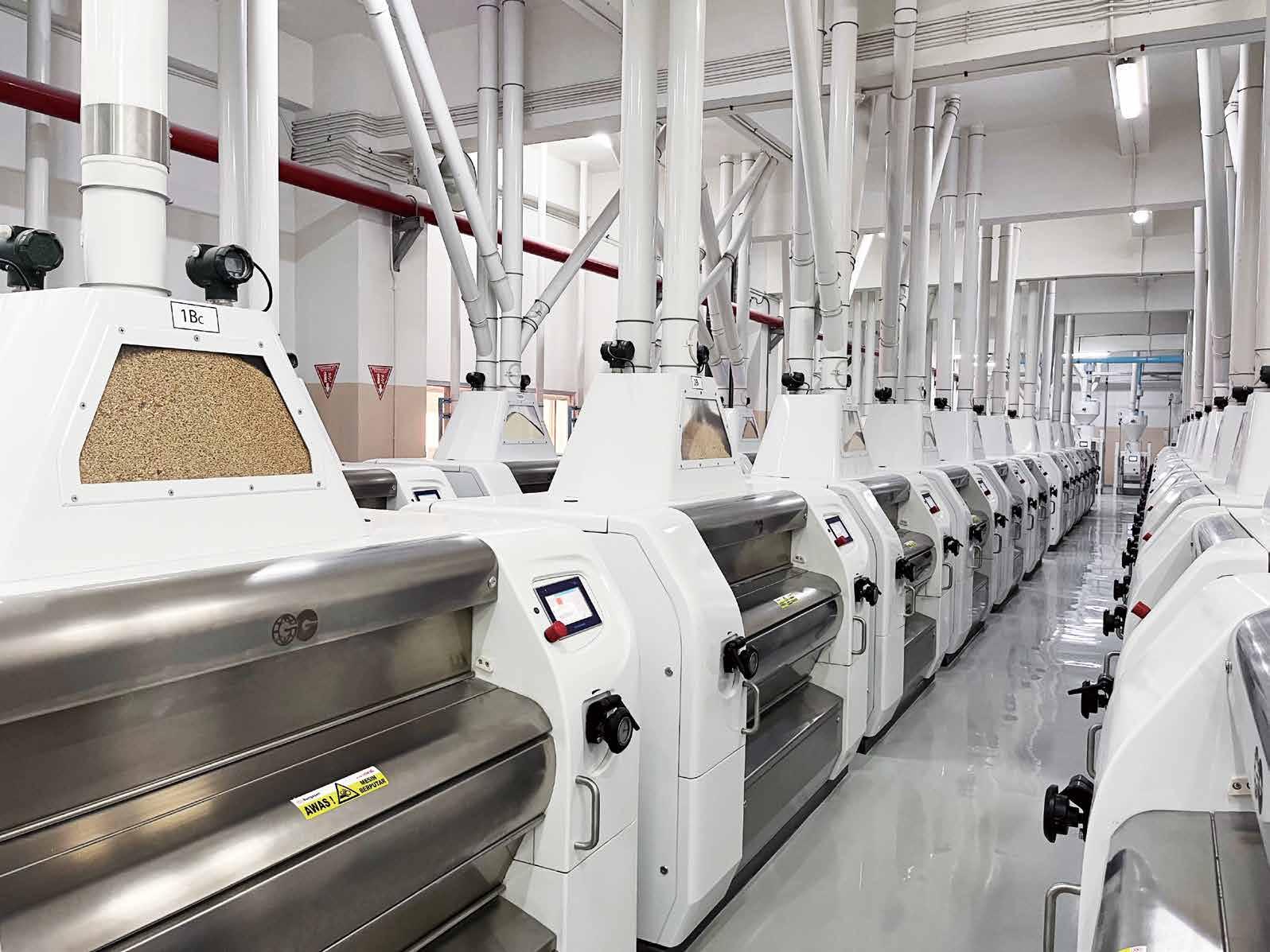

WHAT WE DO Designing FLOUR MILLING Manufacturing Turnkey project Service +86 371 68631308 info@g-grain.com www.g-grain.com SCAN ME FOR BROCHURE


Handle bulk with efficiency and reliability
Pneumatic and mechanical ship (un)loaders
Up to 2500 tph for loaders and up to 1200 tph for unloaders.
Low noise & no dust emission
Turnkey solutions for cereals, soy flour, fertilizer, pellets and more...



Perendale Publishers Ltd
7 St George’s Terrace
St James’ Square, Cheltenham, Glos, GL50 3PT, United Kingdom
Tel: +44 1242 267700
Publisher Roger Gilbert rogerg@perendale.co.uk
International Marketing Team
Darren Parris
Tel: +44 1242303792 darrenp@perendale.co.uk
Asia Marketing Team
Dante Feng
Tel: +886 227930286
dantef@perendale.com
Latin America Marketing Team
Cristina María Roldán Otero
Tel: +44 1242 267700
cristinaot@perendale.co.uk

44 Wheat, bread, gluten and health: Where do we stand in 2024? 52 Wheat milling innovation 58 Efficient dough testing with the Brabender FarinoGraph 62 Endotoxins and heat stressnot your cows’ best friends
Moving Beyond Break/Fix to Prevent Downtime of Critical Animal Feed Conveyors
Nigeria Marketing Team
Nathan Nwosu Tel: +234 8132 478092 nathann@perendale.com
Egyptian Marketing Team
Mohamed Baromh Tel: +20 100 358 3839 mohamedb@perendale.com
Turkey, Eurasia and Middle East Marketing Team
Mehmet Ugur Gürkaynak Tel: +90 537 3646457 mehmetg@perendale.com
Editorial Manager Joy (Jyothsna) Nelloolichalil joyn@perendale.co.uk
Editorial Assistant
Shannon Parsons shannonp@perendale.co.uk
Niamh Cassidy niamhc@perendale.co.uk
Social Media Journalist’
David Harvey davidh@perendale.com
International Editors
Dr Roberto Luis Bernardi robertob@perendale.com
Professor Wenbin Wu wenbinw@perendale.com
Mehmet Ugur Gürkaynak mehmetg@perendale.com


Design Manager James Taylor jamest@perendale.co.uk
Circulation & Events Tuti Tan tutit@perendale.co.uk
Development Manager Antoine Tanguy antoinet@perendale.co.uk
millingandgrain.com ISSN No: 2058-5101
©Copyright 2024 Perendale Publishers Ltd. All rights reserved. No part of this publication may be reproduced in any form or by any means without prior permission of the copyright owner. More information can be found at www.perendale.com
Perendale Publishers Ltd also publish ‘The
and ‘The Global



8 10 24 37 38 41 76 78 84 102 108 111 112 114
International Milling
Miller’ news service Grain & Feed Milling Technology magazine was rebranded to Milling and Grain in 2015 MAXIMISED FLOUR MILLING
Directory’
STORAGE
MAXIMISED
THE PUBLISHER Milling News Gems from the Mills Archive Mill TRAINING FOCUS Product FOCUS Special CASE STUDY Commodities INDUSTRY EVENTS PEOPLE 20 Mildred Cookson, Mills Archive Trust, UK 27 Dr Mahmoud Riyad 10 www.millingandgrain.com Find out more at: YOUR GLOBAL PARTNER VOLUME 135 ISSUE 6 June 2024 Industry Profile CHARITIES DIRECTORY the interview Regular items Feature content
& HANDLING
70
THE PUBLISHER
Sometimes you have to go that extra mile to find something really special.
So far this year I’ve spend time, effort and of course resources to report on milling sector events and expositions across the world in order to bring readers the latest information on developments and innovations that they need to be aware of in addition to simply reporting on those events themselves.

Roger Gilbert
Rallying both myself and our team to organise themselves to fly to Istanbul to attend the Turkish premier milling event IDMA 2024 which is that country’s first combined expo under new management aimed to get back it back on course following the pandemic years, and to deliver what it was building in the year’s prior to the emergence of Covid-19 was a challenge - or as we say in English, it was likely to be ‘A bridge too far.’ Just for background, that saying comes from the title of a 1977 film directed by Richard Attenborough which depicts an Allied operation in Nazi-occupied Netherlands during World War II, which failed.
Was this ‘A bridge too far’ in terms of milling events? Not at all.
If we are talking of man and machines, then this was event was a huge success.
While numbers of visitors might not have reached expectations nor representative of earlier years, the magnitude of what was on offer, nevertheless was a triumph for the Turkish milling industry
Exhibitors showed off their amazing innovations and their overall commitment to the milling industry globally. This was a showcase of what one nation can do for an industry and this was clearly reflected in the huge range of roller mills, pellet presses, optical sorters and laboratory equipment along with almost every other aspect of the milling process that you are likely to see in one place – or rather over three halls under one roof.
What show was this? It was the IDMA expo of course and it was celebrating its tenth outing.
The roll call of roller mills was second to none. I took photographs of everyone and there were over 25 separate company roller mills on display - and they were almost exclusively Turkish.
Of course there were numerous non-Turkish companies exhibiting, but this year’s event was dominantly a domestic affair and the competition among roller mill manufacturers was clear to see.
Every company was able to point to aspects of their mill that made them unique and advantageous to the visitor
In this issue we report on the show itself with our highly respected Turkish representative, Mehmet Ugur Gürkaynak, providing the basics of the show along with a range of photos of exhibitors and others that we were fortunate to meet with.
However, for our summer edition next month – that is our July edition - I plan to present a photo round up of what must shortly be a unique gathering of roller mills. There must be a collective word for this - how about: ‘An amassment of mills?’
In walking the corridors, I was invited by the Turkish company
MILLING AND GRAIN | JuNe 2024
Tanis to be interviewed and was asked what I thought of this year’s event - you can see that interview and that of my colleague Darren Parris, who was also interviewed by Tanis, in our MAGTv which has links on the next page.
In brief I took the opportunity to congratulate the Turkish manufacturers of milling equipment for their dedication and commitment and added that all millers should be aware of the quality and range of milling machinery this country has to offer.

Handing over the sculpture
It was a great pleasure to be able to visit New York in mid-May (on my way to Mexico for yet another event) to be joint host in a luncheon to present the 2023 Milling Hall of Fame sculpture to John Coumantaros of the Flour Mills of Nigeria.
We were fortunate to find a stunning venue for this occasion, which was the New York Yacht Club in Manhattan.
This was a private lunch with members of Mr Coumantaros family present and both myself and Torsten Wuywiol of Mühlenchemie, who supports the FlourWorld Museum in Wittenburg, Germany.
This was a special day and one I’d like to revisit as Mr Coumantaros and his family’s development of the milling sector within Nigeria has done much for food security in that country. He tells me more is to come as Nigeria’s population growth and the subsequent demand for foodstuffs, such as bread from wheat flour, is unrelenting.
I hope you enjoy this edition and I look forward to providing the July edition in due course!
VIDEO: Our Publisher Roger Gilbert and Group President Darren Parris were interviewed by Tanis Milling Technologies at IDMA. Please check out the videos here:
Roger Gilbert talks to Mr Robert Cau mymag.info/xWmP
Darren Parris talks to Mr Robert Cau mymag.info/rFOv


Annual Subscription Rates Inside UK: UK£100 Outside: US$150/€133 More Information www.millingandgrain.com http://gfmt.blogspot.co.uk
Milling and Grain has a cooperative partnership with COFCOET
8 | June 2024 - Milling and Grain


Flour Milling Maximised
The Presentations from our Flour Milling Maximised Conference, Co organised by VICTAM, which took place at VICTAM Asia and Health and Nutrition Asia 2024 in Bangkok, Thailand, are out now!
The theme of the conference was how equipment and technology can be used in modern day flour milling to improve efficiencies whilst maximising output.
Hear from leaders and key players in the flour Milling Sectors here:
mymag.info/QNhh

Raymond Ma – Wudeli
Raymond Ma, General Manager of Handan Company of WuDeLi Flour Mill Group, introduces Wudeli and their revolution of equipment and tech. Established in 1989, WuDeLi is the biggest flour mill group in the world, and also China, with a capacity of 80000t/d. Raymond Ma discussed the companies past and present, and their most important evolutionary innovations.

Adi Witono – Bogasari
Adi Witono, from Bogasari, speaks on ‘The Sustainability Journey
Within Our Bogasari Group’. Currently the Operation Vice President for Bogasari Division of PT. Indofood Sukses Makmur Tbk, Adi Witono talks about Bogasari’s (the biggest flour mills in Indonesia) is commitment to sustainability, by taking preventive measures against covering water, air and soil pollution through continuous assessment and improvement of environmental practices.

Welcome! It is the June edition of Global Miller and the sixth edition of Milling and Grain this year. We have made it through half of the year and Summer has officially begun now, or will do on June 20, so that officially means it’s time to stock up on suncream and buy yourself a hat to protect yourself from the sun, especially with all the outdoor farming that you’ll be doing. Protecting the skin is important.
Summer is the perfect season to begin growing those crops that need hotter vegetation and longer days such as corn, okra, tomatoes and more. If you haven’t done so already, now is also the time to be either transporting your pumpkin plants outside if you’ve been growing them indoors or sow them as early as you can this month outdoors. Those pumpkins will be popular later this year and if you want to carve them in time for Halloween then you better get sowing. For a handy tip for a successful pumpkin this autumn, line the floor beneath the pumpkin with a protective sheet. It’ll keep those pumpkins better than if they were directly on the ground.
For some local news in the UK, Parliament have announced that the general elections have been scheduled for July 4, 2024. For those who aren’t aware, this is the once in a five-year election that decides which political party will end up in charge of Parliament and will decide who will be the new Prime Minister. This next month is going to be a busy one with everyone in the UK needing to brush up on their political manifestos and deciding who they want to become the next Prime Minister. Enough of future events though, as for a recent event in the UK that is currently happening, the Farming Union have been urging major retailers to support their local farmers. The US Department of Agriculture plan to offer millions of dollars to support their local farmers through a new program. This is an incredible help to the farming community.
Rogers Foods Ltd, a Japanese owned company, have commissioned an expansion of its hard wheat milling plant in Fraser Valley. This was a lovely, large expansion for the plant that was assigned to Ocrim to perform reconfirmed their partnership. Definitely some interesting bits of information to look into with this news piece.
As for our adventures around the world, you’ll be receiving the Build My Feedmill conference report that we held back in March at Health and Nutrition Asia. We will also be providing all the latest news from our trip to IDMA in Instanbul, Turkiye. It was an amazing trip that we’re so grateful to have gone to.
10 | June 2024 - Milling and Grain Milling News



NFU secures win for seasonal worker’s scheme
Following several years of campaigning by the NFU, the UK Government has announced a five-year extension to the Seasonal Workers Scheme which will help give many farming and growing businesses the vital certainty needed to boost our national food security.
The announcement was made as part of a package of measures in response to the Shropshire Independent Review into Labour Shortages. It provides much needed confidence for businesses and applicants, while also addressing concerns about the recruitment and upskilling of domestic staff.
NFU President Tom Bradshaw said: “This will be a huge relief for the horticulture and poultry sectors that rely on seasonal workers and is a brilliant win for the NFU, which has been campaigning for a long-term plan for seasonal workers for some time.
“We have seen in the past how damaging shortages of workers has been, with approximately £60 million worth of crops lost in 2022 due to a shortfall of workers. We know that with the correct trading conditions there are significant opportunities for growth and the commitment to a five-year scheme is very positive. Moving forward, it is vital to have assurance that the number of visas and the costs associated with accessing them will continue to meet the needs of our food producers.
“Funding announced for further automation of packhouses is also welcome, along with the commitment to accelerate the development of robotic crop harvesters. It is important that these positive announcements are reinforced by the Government at its forthcoming Farm to Fork Summit, and that the industry and government can work together to drive growth for UK food and farming.”

12 | June 2024 - Milling and Grain Milling News


Farming Unions urge major retailers to back British farming
UK farming Unions are calling on major retailers’ commitment to support the industry during this difficult time in response to extremely challenging and disruptive weather this spring.
Exceptional rainfall and a succession of damaging storms have impacted livestock, arable and horticultural sectors and disrupted individual farm businesses the length and breadth of the country. No area of the UK has escaped with lambing, calving, planting and field work all proving very difficult and bringing additional cost to the business.
In a joint letter on behalf of the NFU, NFU Scotland, NFU Cymru and Ulster Farmers’ Union, it seeks major retailer commitment to support the industry during this difficult time. The letter states “These challenges come at a time when many of our members are already struggling to remain viable due to the perfect storm of sustained and spiralling production costs, low market returns and increasing levels of regulation. This latest challenge, whilst not new, is more acute than ever, and is compounding the pressure on our members.
“Farmers and growers continue to bear the lion’s share of the risk within their supply chains, and this is unsustainable. We are in discussions with our respective Governments on further support to assist the industry in navigating these short-term challenges, but we also recognise the important role which retailers have to play in helping the industry to withstand this latest crisis.”
Rogers Foods set for expansion
Rogers Foods Ltd, owned by the Japanese company Nisshin Flour Milling, has recently commissioned the expansion of its 300 T/24h “B-unit” hard wheat milling plant in Fraser Valley. This is a facility built in 2017 in a new building adjacent and communicating with the existing one, which is at the forefront of technology. It presents, in fact, a futuristic vision in terms of food safety, with the use of stainless steel as the predominant material for the entire grinding section, including the roller mills with automatic gap adjustment.
The project, which was completed in June 2023, consisted of the inclusion of the SHE high-efficiency peeler in the cleaning section to increase efficiency and food safety by lowering contamination, reducing bacteria and ash content through gentle dehulling of hard wheat. In the grinding section, on the other hand, the automatic roller mills. In addition, the existing pneumatic plant was upgraded, increasing its capacity to ensure more efficient and continuous production.
The expansion, assigned to Ocrim, reconfirms the partnership between the two groups that dated back in 2004 with the construction of the first 250 T/24h “A-unit” milling plant, later expanded to 300 T/24h. “We were pleased with the first project, and since then, we have been relying on the Italian company’s expertise to continue to achieve new goals and consolidate the success of our initiatives,” said Kelly O’Brien, Vice President Operations at Rogers Foods Limited.
Get insights in the quality of the steam process
With the IVS Smart Steam Dosing Unit

Anticipating data facilitates predictive maintenance
Recommendations for optimisation
Increases user expertise of steam dosing
Insight into the quality of the steam network
www.ivsdosingtechnology.com info@ivs.nl +31(0)413 29 19 76 Milling and Grain - June 2024 | 15 Milling News

USDA announces millions to support farmers
The US Department of Agriculture (USDA) announced approximately US$22.3 million available to community-based and non-profit organisations, institutions of higher education and tribal entities that help underserved and veteran farmers and ranchers own and operate successful farms. Funding is made through USDA’s 2501 Program.
“2501 Program partners are based in local communities and rural areas where they serve a critical role in maximising USDA’s outreach efforts to underserve communities,” said OPPE Director Lisa Ramírez. “They provide training and technical assistance to help these agricultural producers succeed and also connect them to USDA programs and services.”
For more than 30 years, and in partnership with organisations nationwide, the 2501 Program has helped reach underserved farmers and ranchers. The 2014 Farm Bill expanded the program to include assistance to veteran farmers and ranchers. The 2018 Farm Bill increased mandatory fund-
ing for the program through fiscal year 2024. With 2501 funding, organisations conduct education, training, farming demonstrations and conferences on farming and agribusiness.
Since 2010, the 2501 Program has continued to increase access to USDA’s programs and services and awarded 615 grants totalling more than $194 million. For example, FY 2023 grantee Farm to Table Guam is helping farmers in Guam with business training, financial planning and technical assistance in crop production and distribution. Quivira Coalition is reaching rural producers in New Mexico with radio spots in English, Spanish and Diné Bizaad (Navajo) about arid land stewardship practices and conservation.
Eligible applicants include not-for-profit organisations, community-based organisations and a range of higher education institutions.
Applications must be submitted through grants.gov and received by Friday, July 5, 2024.


At PCE, precision engineering meets custom design to produce dies that fit all pellet press models. Our dedication to quality ensures your operations are seamless, efficient, and high-quality. Our dies are essential for top-notch performance in feed, biomass, or any material pelleting.

Reduce costs and prevent risks Optimize your entire production chain Guarantee higher quality products BESTMIX® Feed Formulation, Quality Control, Ration Calculation and ERP solution. Scan to learn more: www.bestmix.com The most advanced software solutions for feed production: MAXIMIZE YOUR PELLET PRESS’S POTENTIAL WITH TAILOR-MADE DIES.
Elevate your pellet production now. Visit www.pce.eu
16 | June 2024 - Milling and Grain Milling News
www.pce.eu




Cesco launches new project in Saudi Arabia
Cesco EPC, a leading German company specialising in grain storage and processing plants, is pleased to announce its new project in collaboration with United Feed Company (UFC) in Saudi Arabia. This project exemplifies Cesco’s commitment to innovation and adaptability to meet the unique challenges of the region.
The project includes 15 corrugated steel flat-bottom storage silos with a total capacity of over 20,512 tonnes. Additionally, Cesco will provide conveying equipment for a flat storage warehouse for soy meal, covering a total surface area of 3800m². This substantial storage capacity allows UFC to maintain a strategic reserve of essential feedstock materials, mitigating the impact of potential supply chain disruptions.
The plant is designed to receive, transport and store free-flowing materials like grains, cereals and oilseeds. With dedicated high capacity 2x400t/h receiving lines for grains and 2x125t/h for soy meal, the facility can handle a significant daily intake, ensuring a consistent supply of raw
Grains undergo a thorough pre-cleaning process using advanced rotary cleaners and magnet pipes to remove impurities. Flow scales integrated into the system ensure accurate weighing of incoming materials, optimising production efficiency and cost control.
The plant features a versatile reclaiming and recycling system that allows for efficient distribution of stored materials. Grain can be directed to bulk truck out-loading silos, bagging lines, or back to storage based on production requirements.
Cesco’s innovative chain conveyors, belt bucket elevators and roller belt conveyors are incorporated throughout the facility. These conveyors offer several advantages, including improved cleanability, reduced maintenance needs, and a modular design for easier transport and installation.
The design of the plant enables simultaneous operation of various processes. For example, grain and soy meal receiving/loading can occur concurrently, maximising overall efficiency and throughput.
The design accommodates future expansion with an additional nine corrugated steel flat-bottom storage silos, increasing the total capacity by over 123,091 tonnes to reach a combined capacity of 328, 243 tonnes. Additionally, the sot meal storage capacity will be doubled to a total of


Milling and Grain - June 2024 | 19 Milling News


MA Complete New Mill at Bishop’s Stortford
Milling journals of the past at The Mills Archive
by Mildred Cookson, Mills Archive Trust, UK
ILLING, the earlier title for Milling and Grain, in its issue for June 19th, 1937, told the story of the fall and rise of this Hertfordshire mill. It began in 1882 when Sylvester Edwards ran a windmill at Great Wilbraham in Cambridgeshire. This was followed by a one sack water mill at Little Hallingbury in Essex, and then in 1901 he built the original flour mills at Bishop’s Stortford, installing a roller plant of his own design. When Sylvester died in 1933 the control of the firm passed to his son, Charles, who was joined by

his brother John. They used nothing but English wheat, and a large proportion of their output was used for biscuit making.
In 1935 a disastrous fire destroyed the two top floors along with the roof, and with the exception of some of the roller mills and wheat cleaning plant, the machinery was so badly damaged that it was beyond repair. It was decided to install an entirely new up to date five sack plant, together with a new silo, screen room, and provender plant. All of this was designed, built and equipped by Henry Simon Ltd.
 The purifier floor
The purifier floor
20 | June 2024 - Milling and
Simon roller mills Centrifugals on the top floor
Grain
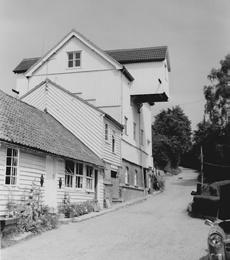

The walls of the old mill had been left standing after the fire, but reconstruction of the building to its original height would not provide enough space to accommodate the proposed new plant. Mr Edwards decided to erect a completely new building on the ample space available adjacent to the old mill. Constructed by Joseph Parks & Son of Northwich in Cheshire, it was a steel framed structure, filled with brick and surmounted by a flat asphalted roof with a three-foot coping.
The local yellow brick was used to harmonise with the old mill and surrounding properties. The name of the firm and of the mill was prominently displayed on all sides of the building by large signs which were painted in bright red, and the silo carried an advertisement of the firm’s activities which could be seen from a considerable distance. The mill building comprised of eleven

bays, three occupied by the wheat cleaning plant, six by the mill and the remaining two by the flour packing and storage section.
The mill and screen room comprised four lofty floors, giving plenty of headroom and reducing the cross conveyers to a minimum. In the flour storage section an extra floor was added making it five floors at this end. A verandah provided at the flour warehouse end of the building protected vehicles from the weather while loading.
The old mill building was reconstructed and a new provender milling plant installed in it. It was also used for the storage of provender and wheat feed. The screen room was arranged on the latest Simon all-metal system, machines, conveyers, elevators and spouts. Wheat from the silo was passed through an Exact measurer to a fan-less type millerator, which extracted dust, sand

 Barron’s D type impact grinder
Mr Edward’s new mill
Barron’s D type impact grinder
Mr Edward’s new mill
Milling and Grain - June 2024 | 21
Little Hallingbury watermill in Essex

pubblicità italiana_MOD.pdf 1 27/01/22 10:59

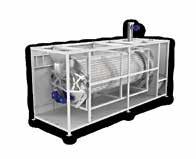
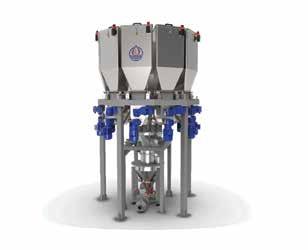

C M Y CM MY CY CMY K
22 | June 2024 - Milling and Grain
and larger impurities. Following this the wheat went through a Carter separator that removed barley and oats, the grain then passed to a washer and whizzer and finally a hot air dryer.
The mill had four breaks and a capacity of five sacks an hour. It had been designed so that by the addition of two or three roller mills the capacity could be increased to seven sacks per hour. The most outstanding feature of the mill was the generous roll and dressing surfaces provided, extremely desirable in a mill working continuously on native wheat, which for many years might be excessively damp.
The mill was arranged with reels and centrifugals for scaling and grading. The scalping of the first two breaks was carried out on reels; the remaining break and reduction stocks were dealt with on centrifugals. The purifier stocks were divided into six classes. Interestingly the third break semolina was dealt with separately and the middlings were re-purified. The purification of all stocks was done on Simon fan-less purifiers that were exhausted by high speed metal trunking to fan and cyclone.
The flours, after being treated on a double feed centrifugal, were collected in three worms and conveyed to a flour dividing board arranged in a convenient position on the purifier floor so that any desired variety of flours could be made. The flour then passed to a double feed centrifugal for re-dressing. There was a system for the grading of wheat feed, and a bran roll, with a bypass spout, so that either rolled or straight run bran could be made at will.
The provender mill had the latest types of machines for grinding barley, maize and oats, and for the production of rolled oats. Maize meal was done on a Barron No. 2 type D impact grinder and after being ground was collected by means of a fan and cyclone system. Barley meal was also dealt with on the impact grinder. However, when a softer meal is required, the barley was

treated on a Barron 36-inch Dreadnought grinder. Corn cutting was done on a Barron No.1 size Diamond corn cutter capable of producing three grades simultaneously, combined with an aspirator. Rolled oats were produced on a Barron oat crushing roll.
Power from a Ruston & Hornsby four-cylinder horizontal, crude oil engine of approximately 200hp drove the main shaft by means of Dick Balata ropes whilst high test belting was used within the mill itself. The engine also drove a 30kw generator for lighting and power.
As might be expected after the destruction of the old mill, every precaution against fire had been taken. Fireproof doors at various points and a system of automatic sprinklers were installed throughout the mill, screen room and warehouse.


We train the workforce of tomorrow. Expand your knowledge, exchange ideas and gain experience in our academies around the world. Let’s shape the future together. Scan the QR code for more information. millingacademy@buhlergroup.com Innovations for a better world. Milling and Grain - June 2024 | 23
The Ruston and Hornsby oil engine
Gems from the Mills Archive
A photograph on iron
by Nathanael Hodge, Mills Archive, UK

Measuring approximately 6 x 9 cm, this photograph is not on paper or film but on an iron sheet. It is a tintype, a method of photography developed in the mid 19th century. Much cheaper than the earlier daguerreotype which used a sheet of silver-plated copper, tintypes were often used by itinerant and fairground photographers, as the photograph could be taken, developed and given to the customer within only a few minutes, similar to later polaroid film. Because the photograph is not a copy, like a print made from a negative, it retains a high level of detail, as can be seen from the much higher resolution version shown here.
This photo shows the Canterbury millwright T R Holman, with his staff. The two young men immediately to his right and left are his sons, Harry Branford and William John Holman. The Holman firm was founded by T R Holman’s father John in 1816 and built smock windmills in Kent as well as repairing other wind and water mills. The wooden smock mills were often constructed of Baltic pine, imported through the ports of Dover and Folkestone – it was slow growing and had a high resin content which helped it withstand the elements. Much of the work in building a mill would be carried out in the works by a number of men, before the mill was finally erected with poles, shear legs and blocks and tackle – cranes did not yet exist. The carriage of tackle to the site would have been done with wagons drawn by horses.
Hours were long, 6 am to 5.30 pm with half an hour for breakfast and an hour for lunch. When working on complex repairs to mills which took several days or weeks, it was usual for the millwrights to lodge with the miller. Harry Branford was doing this on 18 January 1881 when there was a snowstorm which left him snowbound and isolated for more than a week. The Holmans’ records show work done to more than 120 mills within 20 miles of Canterbury.
In 1857 T R Holman was hired by the banker and philanthropist Sir Moses Montefiore to construct a windmill in Jerusalem. The Holmans were later commissioned to provide machinery for a mill


in Haifa, Syria (now in Israel). Unfortunately, on this occasion an important part of the machinery was lost in the sea while being unloaded at Jaffa.
After their father’s death in 1897, the brothers Harry and William took on the business which became ‘Holman Bros, engineers and millwrights’. The character of the firm was gradually changing as wind power fell out of use, and they began placing more emphasis on their agricultural machinery business, as well as hiring steam ploughs and threshing machines to local farmers.
The firm finally closed down in 1975 due to the compulsory purchase of the Old Dover Road yard by the City Council. The final auction sale of fixtures, fittings and stock took place on the 3 April 1975, marking the end of over 150 years of continuous trading.


www.millsarchive.org 24 | June 2024 - Milling and Grain

If you can think it, we can pack it!

With over 150 years of combined experience, we help you find your individual packaging solution. Over the years, we have developed machines that cover a range of weights from 50 grams to 25 kg for flour based products. In addition, we help you meet global environmental challenges without compromising on performance.












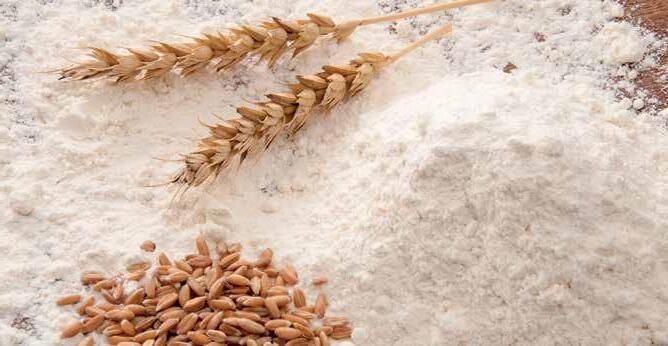



Let’s create your perfect flour packaging solution!


The Packaging Group GmbH · Germany · www.tpg-packaging.com





Visit us online at www.perryofoakley.co.uk sales@perryofoakley.co.uk +44 (0)1404 890300 Perry of Oakley Ltd. The UK’s Most Experienced Manufacturer of Bulk Drying, Handling & Storage Equipment Twin Trace Conveyors | Belt Conveyors | Screw Conveyors Flat Bottom & Hopper Bottom Silos | Square Bins A SQUARE APPROACH FOR A WORLD WITHOUT FOOD WASTE. DISCOVER OUR TAILORED SOLUTIONS ON OUR WEBSITE SCE.BE 26 | June 2024 - Milling and Grain Milling News

 by Dr Mahmoud Riyad, Secretary-General, Egyptian Milling Association, Egypt
by Dr Mahmoud Riyad, Secretary-General, Egyptian Milling Association, Egypt
USDA: Egypt’s Wheat Imports Expected to Rise
Egypt’s wheat imports are forecast to climb in the 2024/25 marketing year as the country’s economy stabilizes and access to foreign currency improves, according to a report by the Foreign Agricultural Service of the US Department of Agriculture (USDA) released on Tuesday, April 23.
The report cites several factors contributing to the anticipated increase, including a recent influx of foreign currency from deals with the International Monetary Fund (IMF) and the United Arab Emirates, and the Egyptian government’s decision to float the Egyptian pound. These measures are expected to alleviate the severe foreign currency shortages that have hampered Egypt’s ability to import essential commodities in recent years.
“Due to the recent changes within the Egyptian economy, [FAS/ Cairo] forecasts Egyptian imports for grains (such as wheat, corn, and rice) to increase in MY 2023/24, on account of more access to U.S. dollars and the stabilization of the market,” the USDA report states.
Despite the positive outlook, the report acknowledges that full market normalization may take time, with some industry experts predicting it could extend into 2025 or even 2026.
Egypt, with a population exceeding 106 million and heavily reliant on subsidized bread, is one of the world’s largest wheat importers. The country’s domestic wheat production, while increasing slightly, remains insufficient to meet the population’s needs.
Since 2022, Egypt has suffered from severe shortages in foreign currency, which inadvertently interrupted commodity supply chains and produced high inflation rates. As a result, many traders began using the parallel market exchange rate which stifled economic growth as many importers did not have enough U.S. dollars (USD) for imports. Coinciding with this, the lingering impacts on the economy from COVID-19, the Russian invasion in Ukraine, the war in Sudan, the Israel-Hamas conflict, and the Houthi attacks on shipments in the Red Sea have also affected grain trade. However, in March 2024, Egyptian banks received a large influx of foreign currency from a deal with the International Monetary Fund (IMF) for $5 billion and a $35 billion investment deal with the United Arab Emirates for projects in Ras El-Hikma. As a result of the increased availability of foreign currency, some traders have reported Egyptian banks resolving outstanding
payments for grains stuck at the port. As the GOE announced the floating of the Egyptian pound, it hopes that Egypt’s domestic economy will better adjust to external shocks and support the ability of Egyptian businesses and industries to import the necessary raw materials needed for their industries. The GOE also hopes that the changes in the economy will encourage greater investment and enhance Egyptian exports. Due to the recent changes within the Egyptian economy, Post forecasts Egyptian imports for grains (such as wheat, corn, and rice) to increase in MY 2023/24, on account of more access to U.S. dollars and the stabilization of the market. However, many traders report that the market may not normalize until 2025, with some from industry reporting as late as 2026.
The USDA report forecasts Egypt’s wheat imports to reach 11.2 million metric tons in the 2024/25 marketing year, a two percent increase from the previous year. Russia, Romania, and Ukraine remain the primary wheat suppliers to Egypt, with the report noting that Egypt is a “price-sensitive market” that relies heavily on these countries due to competitive prices and lower freight costs.
With its wheat reserves continuing to decline, Egypt’s wheat imports in the marketing year 2024-25 are forecast to increase by two percent over the previous year due to population growth and the availability of more foreign currency in Egyptian banks, according to a report from the Foreign Agricultural Service (FAS) of the US Department of Agriculture.
The report, released April 23, noted that Egyptian banks in March received a large influx of foreign currency from a deal with the International Monetary Fund for $5 billion and a US$35 billion investment deal with the United Arab Emirates for projects in Ras El-Hikma.
“As a result of the increased availability of foreign currency, some traders have reported Egyptian banks resolving outstanding payments for grain stuck in ports,” the FAS said.
The FAS forecasts wheat imports in 2024-25 reaching 11.2 million tonnes in Egypt, which always has relied heavily on imports to help supply its considerable subsidy program that provides low-cost bread to consumers.
The country’s wheat ending stocks for 2024-25 are expected to slide to 2.48 million tonnes, about half the amount that was in reserve in 2022-23 and the lowest level since 1.85 million tonnes in 2002-03.
With Egypt’s population surging higher — it now stands at 106 million but is expected to reach 124 million by 2030 — increasing production and imports is a top priority of the Egyptian government. Perennially among the world’s top consumers of wheat products per capita, Egypt’s total consumption in 2024-25 is forecast at an eightyear high of 20.65 million tonnes, the FAS said.
The FAS projects 2024-25 wheat production at 9 million tonnes, up slightly from the previous year.
“Wheat production in Egypt has improved through the development of new breeding and cultivation practices which have led to the spread of new high-yielding varieties,” the FAS said.
“Moreover, the use of the raised bed planting method, instead of the old method of planting in basins, has made the largest contribution to an increase in yield.”

Milling and Grain - June 2024 | 27


APPROX 40 MILLION TONS OF GRAIN IS SAFELY STORED IN MYSiLO SILOS.
CONTINENTS more COUNTRIES than 5 80’






more more CUSTOMERS PROJECTS than than 2000’ 2500’ HAPPY WITH MYSiLO GRAINS MYSiLO GRAIN STORAGE SYSTEMS INC.CO. Erenler OSB Mah. R. T. Erdoğan Blv. No: 30 Aksaray / TURKEY info@mysilo.com | www.mysilo.com | +90 382 266 22 45

John G. Coumantaros inducted into the Milling Hall of Fame
The FlourWorld Museum of Wittenburg, Germany, has passed the sculpture recognising the induction of John G. Coumantaros, chairman of The FMN Group, into the Milling Hall of Fame.
This prestigious accolade, awarded by the museum on behalf of the Milling Hall of Fame, celebrates individuals whose lifetime contributions have significantly shaped the milling industry.
Torsten Wywiol, CEO of the Stern-Wywiol Gruppe and Roger D Gilbert, publisher of Milling and Grain magazine, which founded the Milling Hall of Fame, personally honoured John G. Coumantaros for his outstanding achievements at the award ceremony on May 22nd in New York.
Together they presented him with a bronze millstone sculpture by renowned artist Sibylle Waldhausen. John G. Coumantaros is the 2023 inductee.
At the award ceremony Mr Wywiol said, “It is a great privilege for me to pay tribute today to a man who has had a lasting impact on the milling and food industry in Nigeria as a true pioneer. John G. Coumantaros perfectly embodies the values we uphold in the Milling Hall of Fame: Dedication, passion and innovation. He is a shining example of how the visionary actions of one person can change the world for the better.”
Volkmar Wywiol, founder of the FlourWorld Museum, added, “Flour.Power.Life, our museum’s motto, underscores flour’s essential role in human nutrition, health and societal development. John G. Coumantaros embodies these principles through his transformative work in Nigeria’s food supply.”
The FlourWorld Museum is dedicated to the rich history of flour and its essential role in human civilisation.
Being inducted into the Milling Hall of Fame is the highest honour in the milling industry, recognising leaders who have made remarkable impacts through their visionary work.
The independent jury commends John G. Coumantaros for his successful implementation of a sustainable and innovative approach to food production. His leadership and dedication to advancing the industry have truly set him apart.
Our congratulations go to John G. Coumantaros on this welldeserved recognition -Roger Gilbert, publisher..

30 | June 2024 - Milling and Grain Milling News

Preparing for a more sustainable future demands a proactive partner with insights, innovative solutions, and precision services. One who can help you save costs and get the most value from locally sourced raw materials while reducing environmental emissions — all without ever compromising on performance. Our specialists on the ground work closely together with you to help shape a strong future for you and your business. Reduce waste, optimize pig performance, and step up to the circular economy — because sustainable farms are more efficient farms.
EMISS
RAWMATERIALS SUSTAI
COST SAVINGS
$ Learn
IONS CONTROL
NABLE
$
more at dsm-firmenich.com/anh
Is your herd
ready for tomorrow?

Starting signal for the expansion of the Bauck Oat Mill
Bauck GmbH is expanding the largest and most advanced organic oat mill in Europe commissioned in 2021. Thanks to successful cooperation with the internationally renowned machine and plant manufacturer F H Schule Mühlenbau GmbH, the output of all sections of the mill will be doubled in the future. This is the response of Bauck GmbH to the strongly increasing demand for gluten-free products and organic products from sustainable production.
There is hardly any other topic that concerns people as much as nutrition. There is a philosophy for literally every aspect of nutrition, including fitness trends, culinary health risks and food intolerances. For anyone who values the organic cultivation of cereals, Bauck GmbH is the ideal choice. The family and employee run medium-sized company based in Rosche, Lower Saxony, is renowned for the high quality of its Demeter and organic products. Under the brand name ‘Bauck Mühle’, it produces a range of products including flours, mueslis and baking mixes. Three years ago, Bauck launched the largest production facility for gluten-free cereal products in Europe in Rosche – with high-performance machines and plants from Schule. And Bauck relies on the experienced specialist for oat processing from Reinbek also for the expansion of the mill. Currently, up to 20,000 tonnes of grain a year can be converted into flour or flakes in the eight-storey building in the district of Uelzen, which has a total height of 48 metres. This expansion of the mill will double the capacity in all sections, from fine cleaning, hulling and sorting to flaking and pelleting. For the market leader in gluten-free organic products, this is not just a response to the rising demand. By providing additional capacity for organic and Demeter raw materials, Bauck is also pursuing the goal of further expanding organic farming in the region. The expansion of the mill will take place while the mill is in operation and is expected to be completed by the beginning of 2025.
“The quality of the plants and the sound technical advice we receive from Schule have won us over,” explains

Jan-Peter Bauck, Managing Director of Bauck. “Above all, the enormous commitment of the Schule team, starting from the first meeting, through the entire construction phase and commissioning of the mill, including the subsequent customer service, was the decisive factor in our decision to implement also the expansion of our mill with Schule. When working with Schule, we always get the feeling that it is not just about providing a service, but about working together on a joint project.” Friedemann Wecker, who has also been a member of the Bauck GmbH Management since 2023, adds: “The plant’s performance speaks for itself – from the first commissioning until today. We also appreciate the fact that the plant technology is constantly being advanced due to Schule’s outstanding expertise. That is reason enough to continue our joint success story with the project ‘Good Flake 2.0’.”
Especially in the currently difficult market situation, it cannot be expected that consumers spend money on premium products, explains Marius Hermes, Managing Director of Schule Mühlenbau. “Of course, we are also very pleased about the success of Bauck GmbH. The significant increase in our plant output after just four years of operation is testimony to the high quality of the products and their popularity with consumers. The fact that Bauck has once again chosen Schule for the mill expansion is of course the greatest compliment for us as a plant manufacturer and a confirmation of our long-standing and good partnership.”


Use the Promo Code ATLANTA24 Would you like a complimentary digital subscription to Milling and Grain magazine? YOUR GLOBAL PARTNER Simply visit: https://store.magstand.com/millingandgrain Milling and Grain - June 2024 | 33 Milling News

New agri-tech initiative enhances farm resilience with
seaweed innovation
In a significant boost to sustainable agriculture, the UK Agri-Tech Centre, in collaboration with Rothamsted Research, Algapelago Ltd, and Harper Adams University, backed by Innovate UK, has announced the launch of the groundbreaking ‘low energy kelp’ project.
The 24-month project ‘optimising low energy extraction of kelp for soil and livestock nutrition’ is set to receive a research grant to develop a novel two-stage extraction process that will produce consistent, high-quality liquid bio stimulant and an animal feed supplement from cultivated kelp.
These products are intended to enhance soil and animal health while reducing reliance on chemical inputs.
Ross Robertson, UK Agri-Tech Centre farming technol-

ogy specialist explains: “Cultivated kelp is a sustainable and rich source of nutrients and bioactive compounds that benefit microbial communities, leading to healthier soil and livestock systems.”
He explains that the project will conduct kilo-scale laboratory trials, prototype systems development, and controlled field trials to test the efficacy of the products under environmental stresses.
In-vitro livestock trials conducted by Harper Adams University will focus on the impact of seaweed supplements on rumen function and performance.
Rothamsted Research will lead plant trials focusing on how Algapelago’s seaweed biostimulant influences plantsoil interactions, under abiotic stresses of heat and drought.
Luke Ansell, head of operations at Algapelago, says: “This project is a pivotal step towards unlocking the potential of seaweed in agriculture.
“We’re eager to lead the way in demonstrating how low-energy, sustainable practices can significantly benefit agriculture while adhering to environmental standards.”
Dr Martin Blackwell, soil scientist at Rothamsted Research, adds: “We’re excited to work with Algapelago Ltd and the UK Agri-Tech Centre on this initiative.
“Algapelago’s novel approach to seaweed processing now only supports sustainable farming but also addresses the pressing challenges of modern agricultural practices in our changing climate.”
The ‘low energy kelp’ project is ambitious in its long-term goal and promises to be a cornerstone for future agricultural practices, driving forward the integration of sustainable resources like seaweed into mainstream farming.
This initiative not only supports the health of the environment but also ensures the resilience and productivity of the agriculture sector in the UK and beyond.
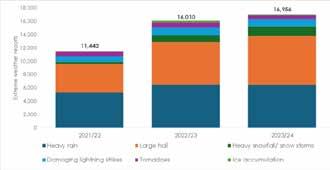
34 | June 2024 - Milling and Grain Milling News
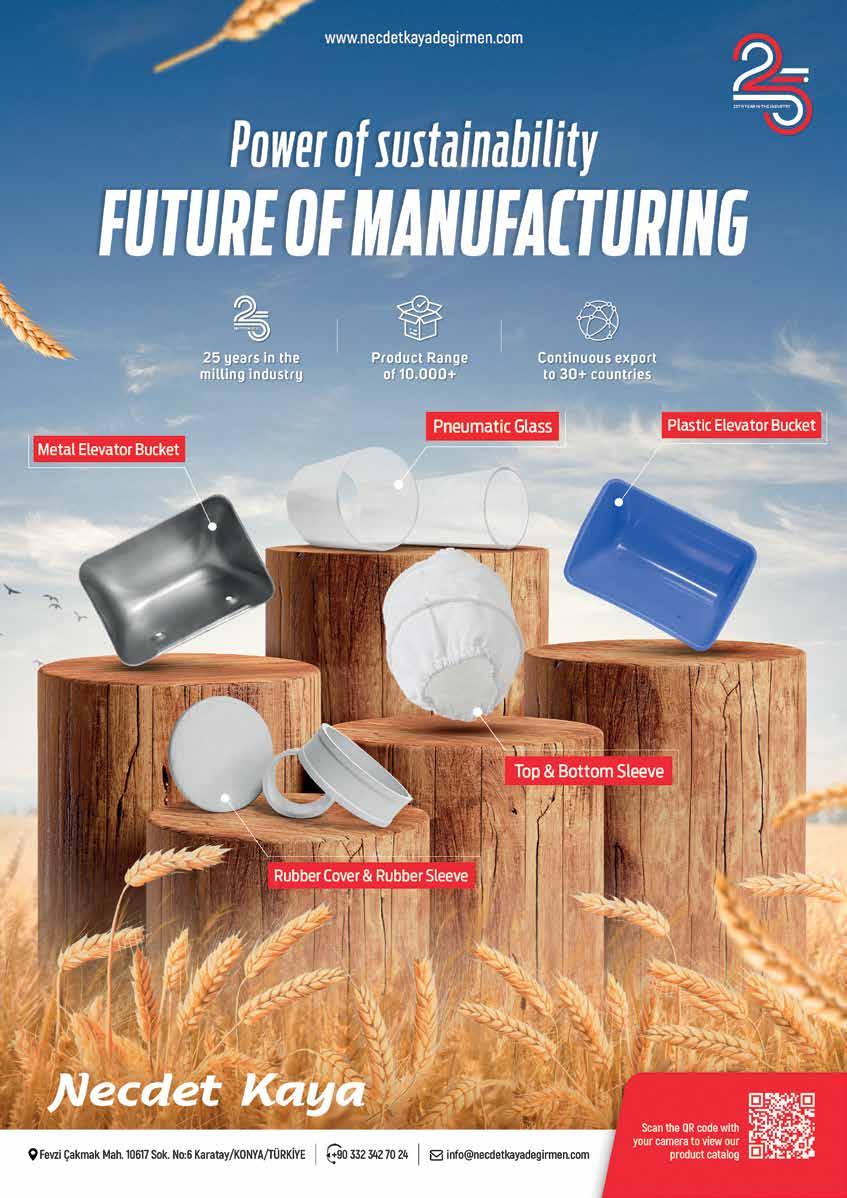


Introduction to Manual Turning and Milling
The Introduction to manual turning and milling course, from Seta, is a combination of elements from their popular manual turning and manual milling courses. It’s an excellent introduction to practical turning and milling, providing instruction in safety, use of drawings and measuring equipment, feeds and speeds, work-holding, tool setting and a range of turning and milling operations.
Instruction takes place both in the classroom and in Seta’s state-of-the-art workshop facilities. This course is ideally suited to those with little or no previous turning or milling experience.
Content
Among the topics in this course includes:
• Safety relevant to turning and milling
• Interpretation of engineering drawings and symbols
• Measuring instruments relevant to turning and milling: - types, care and use
• The centre lathe and its controls
• The milling machine and its controls
• Cutting tools: terminology, selection and mounting
• Feeds and speeds: guidance on calculations; setting feeds and speeds
• Coolants: types and uses
• Turning operations: A selection from: facing; turning diameters; centre drilling; taper turning (using compound slide method); producing threads. Use of 3 and 4-jaw chucks
• Milling operations: A selection from: milling faces; milling step faces; open and closed slots; vees and angles
• Faults recognition: guidance on turning and milling faults and means of avoiding them
The Dates for this four-day course begin on July 15 – July 18 and takes place from 8:30am to 4:00pm. Seta provides accredited, industry-recognised training to an advanced level, delivered by highly experienced staff with vast industry knowledge.
https://seta.co.uk

Milling and Grain - June 2024 | 37 Mill TRAINING
FOCUS Product June 2024
In every edition of Milling and Grain magazine, we dedicate this page to taking a look at the products that will save you both time and money in the food and feed milling process.
Should you have a new product or service that you would like to feature on this page in a future edition of our magazine, be sure to contact us at editorial@ perendale.co.uk
Batch Mixer by
Avlan Blanch
The Alvan Blanch Mixer is ideal for blending a wide range of dry products of varying densities, including meal, rolled grain, cake, pellets, dried beet pulp, vitamin/mineral premix and proportions of moist product like brewer’s grain. Liquid molasses can be evenly applied in ratios of up to 10 percent. The Mixer is also suitable for industrial applications, able to handle granular or powdered plastics. Mixers can be fully adapted to suit a range of needs.
The Mixer has a gentle, but rapid action. The conveyor draws the material up the inclined base, towards a segmented agitator. Having passed through the agitator, the material tumbles backwards. Additives are introduced via the low-level intake hopper. The mixed product is discharged from the slide operated spouts.
www.alvanblanchgroup.com mymag.info/mqcR

Sortex H SpectraVision by Bühler
Sortex H SpectraVision has been developed using the best of Swiss and British engineering know-how. As the culmination of our 75 years of extensive experience in optical sorting, SpectraVision offers three key benefits for our customers. SpectraVision has been designed to supply maximum yields. The newly designed in-house full-color cameras provide the best color differentiation for the sublest of color defects, while new InGaAs cameras take foreign matter (FM) detection to new levels. Innovative ejection algorithms significantly minimise false rejects and new calibration, and tracking algorithms improve machine consistency, reducing false rejects. With machine setup changes logged and saved on Bühler Insights and real-time tracking of sorting performance and emergency warnings with SORTEX Monitoring System. Default modes and recipes for each product are pre-set and tested by SORTEX experts for optimum machine set up right out of the box. A simple user interface design and individual sensitivity control over each defect makes it easy for operators to maintain the optimum machine performance.
www.buhlergroup.com
mymag.info/dIpw

NHP200 by TekPro
The full Holmen range of Pellet Durability Testers are exclusively Made in Britain by Tekpro, and offer a fast and reliable method of testing PDI or Mechanical Durability. From feed pellets to wood pellets, either manual or automatic testing, TEKPRO provides the solution whatever the size of your mill!
The NHP200 is preferred by quality focused feed mills due to its ease of use and repeatable accuracy of the test process, its other benefits include:
• Suitable for Animal Feed & Wood Pellets between 3mm and 12mm
• Semi-Automatic – less need for human input
• Quicker than alternative methods
• Ideal for laboratories in busy testing environments
• Reproducible accuracy of ± 0.1%
• PDI results are stored and displayed on Colour LCD touch-screen, and can be printed or sent to other software by Ethernet socket
• Daily test results can be sent by email to staff, even if working remotely
• Digital Self Calibration built in
• Now includes dedicated Fines Calculation feature
• 1PH 110V-115V or 1PH 220V-240V
www.tekpro.com
mymag.info/pZkv

Platinum Series PT1200 Gear Driven Pellet Mill by Yemmak Yemmak Platinum Series PT1200 Gear Driven Pellet Mill has a high production capacity and impressive pelleting performance of up to 45 metric tonnes/hour. With three rollers with a diameter of 454 mm, the capacity increases proportionately to the higher active pelleting area. The engine is paired with a specially designed two-stage gear set that helps transmit its power to the machine efficiently.The most important advantage of the new Platinum Series Gear-Driven Pellet Mills is the 12–15 percent (up to 20 percent in some cases) capacity increase for higher energy efficiency and the same amount of consumption. The gearbox technology allows the Platinum series pellet mills to increase their power transmission efficiency to 97–98 percent. They enjoy enhanced capacities compared to their equivalents with belt-pulley power transmission systems. The two-stage precision gear set guarantees the highest efficiency and capacity.
www.yemmak.com mymag.info/lLLU
Maize Grinder by Pingle

The maize grinder is developed on the basis of a hammer mill. For the integral maize kernels that have been moisture conditioned, this machine is able to finish dehulling, degerming and grinding operations in one step, and the processing efficiency is improved. Technically speaking, the power consumption for producing one tonnage of maize grit is reduced by 20-30 percent when compared with traditional machines, thereby significantly enhancing the economic returns. With the help of this machine, a complete granule of maize is shattered into 4-6 fragments with a tidy appearance. The embryo breakage rate is less than 10 percent, and the hull is kept whole. This brings great convenience for the following separation of embryo, hull and grit. So, this maize grinder is highly recommended.
www.plflourmill.com mymag.info/eoKS

38 | June 2024 - Milling and Grain


Arrakis by Bühler Reinventing an icon
Have you ever met someone for the first time, but felt as if you’ve known them forever? Meet Arrakis.
Viewed from the front, Arrakis tells the story of the past, but at the same time, also offers a glimpse of the future. It offers features centered around performance, robustness and simplicity, all brought together in a timeless and contemporary design.
The latest addition to Bühler’s state-of-the-art grinding portfolio
- Arrakis is the successor of the Airtronic, considered an icon in the history of milling for its durability and straightforwardness in operation. The new solution, Arrakis, takes these qualities to the next level: increases efficiency, reliability, and simplicity of operation.
At the heart of Arrakis is the grinding unit – a true pillar that millers can rely on thanks to its stable grinding performance. The patented grinding gap adjustment ensures rigidity and stability over time to maximise grinding performance. Sturdy casted frame with load-carrying structure provides high vibration absorption, ensuring robustness for long periods of continuous operation. Load cell sensors control the feeding gap to provide a stable product flow across the grinding rolls for maximum efficiency. In addition,
FOCUS Special
the foreign object protection prevents damage, increasing security and longevity of the roller mill.
Another highlight of Arrakis is its ease of operation. Its intuitive interface makes controlling and monitoring simple and straightforward. Thanks to its secure remote access function, the grinding can be operated through various devices and from anywhere.
The need to retrofit existing plants has been thoughtfully addressed, aiming to minimise potential risks associated with transitioning while enhancing productivity, effectiveness, reliability, and lowering maintenance costs. As Arrakis is built on the same footprint as its predecessor, Airtronic, one-to-one replacements can be made, simplifying the installation process. Connecting the fixed speed feeding roll to the main roll’s drive guarantees a more streamlined system that is easy to install and maintain.
The feeding unit is equipped with a cleaning flap, which ensures the complete discharge of the remaining product and easy cleaning of the feed module. Brushless synthetic scrapers eliminate productaccumulating dead spots, increasing food safety, while selfadjusting knife scrapers align to the surface of rolls, eliminating the need for manual adjustments, and ensuring clean rolls at all times.
For more information, go to mymag.info/EaSD


Milling and Grain - June 2024 | 41


ai-lati.com
simaimpianti.net



BEYOND MAKES US SEE KNOWLEDGE THE HORIZON paglierani.com ocrim.com

Where do we stand in 2024? Wheat, bread, gluten and health:
by Em Prof Fred Brouns, Maastricht University, Netherlands; Prof Peter Shewry, Rothamsted Research, Harpenden, UK & Prof Daisy Jonkers, Maastricht
University Medical Center, Netherlands
During the past decade an increasing number of consumers have reduced their consumption of wheat products, due to concerns about adverse effects of wheat, bread and gluten on health. This has been driven by social media posts, articles in the press and popular books claiming that consumption of wheat causes gastrointestinal complaints, obesity, diabetes, cardiovascular and immune diseases. As a result, the number of people reporting health complaints after consumption of bread and other foods that contain wheat and gluten has increased sharply in a relatively short period of time.
Interestingly, many consumers who report adverse reactions after eating modern factory-produced bread but not after eating pasta or after eating bread made using traditional processes or from modern spelt bread, although all these products contain gluten. An important point here is that the symptoms perceived are real but that there is in most cases no clear organic explanation.
The lack of plausible explanations (and mechanisms) for these reactions led to the establishment of the international research consortium ‘Well on Wheat?’ in 2016. The aim of the research program was to determine whether differences in types of wheat and bread-making processes, and the naturally occurring compounds present in the grains and breads, could play a causal role in the gastrointestinal complaints experienced.
All steps in the grain processing chain that influence the composition of the bread, and thereby may impact on health and / or the perception of gastrointestinal complaints, were evaluated, namely: grain cultivation, milling, mixing, baking and consuming bread.
In the “WellonWheat?” research program Maastricht University, Wageningen University Research, Rothamsted Research (UK) and the Dutch Bakery Center, worked together with other Universities and crop research centres. “Well on Wheat?” was financed by a grant of the Dutch Government “TKI- Top Knowledge Institute” and by a wide range of additional partners* from the AgriFood chain who donated unrestricted research grants. *These
partners are: AB-Mauri bakery Ingredients, , Made, Netherlands; Borgesius Holding BV-Albert Heijn, Stadskanaal Netherlands; CSM innovation Bakery Center, Bingen, Germany; CYMMIT, Texcoco, Mexico; DSM Food Specialties, Delft, Netherlands; Fazer Bakeries Oy, Helsinki, Finland; Health Grain Forum, Vienna, Austria; ICC- Intl. Vienna, Austria; IWGA, Kansas 66210, USA; Lantm¨annen EK , Stockholm, Sweden; Mondelez , Saclay, France; Nederlands Bakkerij Centrum, Wageningen, Netherlands; Baking Industry Research Trust, Wellington, New Zealand; Nutrition et Sante, Revel, France; Puratos BV, Groot Bijgaarden, Belgium; Rademaker BV-Bakery equipments, Culemborg, Netherlands; Sonneveld Group BV, Papendrecht, Netherlands; Zeelandia- HJ Doeleman BV, Zierikzee, Netherlands.
Causes and prevention of health problems related to grain consumption
Gastrointestinal complaints due to eating grains that contain gluten can be divided into three types: celiac disease, gluten sensitivity in the absence of celiac disease and wheat allergy.
What is gluten?
Gluten is a protein fraction that is present in all types of wheat: bread wheat, spelt, emmer, durum, einkorn, triticale (a man-made cross between wheat and rye) and tritordeum (cross between durum and wild barley). These include types of wheat are marketed under trade names, such as Kamut™ and Khorasan™ wheat. Semolina, farro, farina, bulgur and couscous are all products made from wheat and all contain gluten.
Gluten is a mixture of related proteins that are stored in the grain to support germination. They constitute 70 to 75 percent of the total proteins in wheat grain and are classified into two types, gliadins and glutenin’s. The amount and composition of the glutenin fraction is an important factor determining dough strength, and hence breadmaking quality, with the gliadins contributing to dough viscosity and extensibility.
Barley and rye grains contain related proteins, called hordeins and secalins, and are also considered as ‘gluten sources’ in ‘gluten-free recommendations’.
In addition to gluten, wheat also contains other components
44 | June 2024 - Milling and Grain F MAXIMISED FLOUR MILLING


















































World Leaders in Microwave Moisture Measurement Oil Animal Feed Coffee Rice Grain Hydro-Probe XT Hoppers, chutes, belt conveyors Hydro-Mix XT-FS Mixers, conveyors, Ducting System Hydro-Mix XT-EX Certified for use in ATEX, IECEx and NEC/CSA Hazardous Locations (Dust) Hydro-Mix HT-EX Mixers, conveyors, Ducting System, High Temperature Non Food-Safe available Non EX available Non EX available enquiries@hydronix.com Contact us for more details hydronix.com Hydronix-Milling and Grain-Advert Mar 2023 215x140mm.indd 1 28/02/2023 13:55 Milling and Grain - June 2024 | 45 F
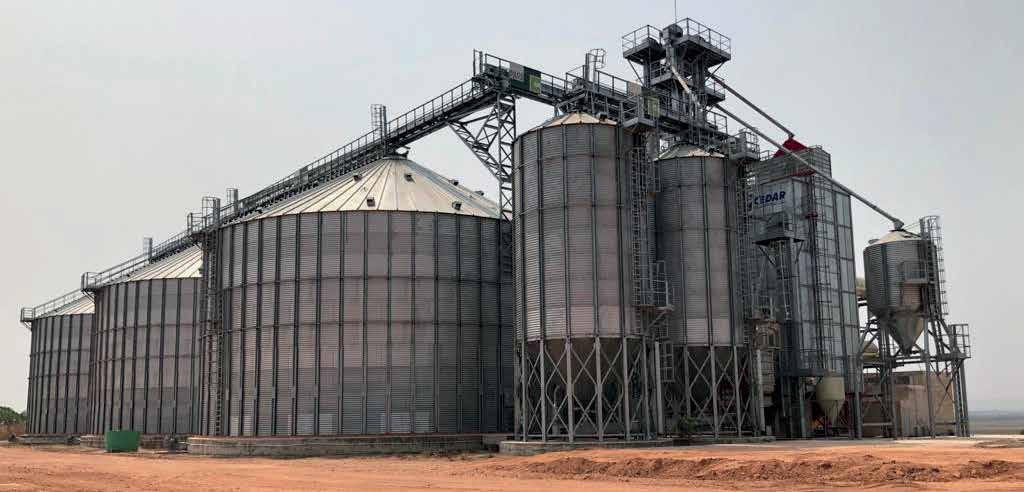



Agribusiness facilities
Silos Córdoba provides engineering services for product quality control, storage and handling equipment, ensuring convenience, reliability, efficiency and profitability in plant management.


Silos Cordoba mainly operates in the post-harvest sector where it offers comprehensive solutions for your grain storage, handling and conditioning needs.
FROM CONCEPTION OF THE PROJECT TO MANAGEMENT
Turn-key projects
SCG Silos Grupo S.L. Glorieta de las Tres Culturas Nr. 1, 4º A 14011 Córdoba. Spain T +34 857 835 623 info@siloscordoba.com www.siloscordoba.com
• GRAIN STORAGE INSTALLATIONS • GRAIN PORT TERMINALS • GRAIN DRYING FACILITIES • INDUSTRIAL PROCESSES • DESIGN
that may lead to intestinal complaints in some people, including amylase-trypsin inhibitors (ATIs) and rapidly fermentable oligosaccharides, disaccharides, monosaccharides and polyols (FODMAPs), the most important being fructo-oligosaccharides (fructans). The fermentation of FODMAPs may result in rapid gas formation causing sensations of bloating in the large intestine and an urge to defecate (figure 1).
Gluten and Celiac Disease (CD)
Celiac disease is caused by exposure of the intestinal epithelium to peptides released by the partial digestion of gluten.
Gluten, like most other plant proteins, is easily digestible (>94 percent). However, this digestion may release fragments (peptides containing the amino acids proline and glutamine) that cannot be further broken down into individual amino acids by our digestive enzymes. In certain circumstances, these peptides can pass through the intestinal wall, after which in a series of steps, they are detected by our immune system as a foreign, unwanted protein. This can then lead to inflammatory reactions and cause damage to the intestinal wall, which reduces the absorption surface of the intestine and can lead to nutritional deficiencies.
Many celiac-active peptides (often called epitopes) have been identified which are particularly abundant in (but not restricted to) gliadins. Research has shown that CD can only develop in individuals who have a specific hereditary predisposition to it. Depending on the region of the world, this genetic predisposition is present in approximately 25-40 percent of the total population. However, only approximately 4 percent of these individuals develop the disease, which results in an overall CD-prevalence of about 1 percent of the global population.
Complexity of the complaint pattern
The abdominal and health complaints frequently reported to be associated with wheat and gluten consumption overlap with the patterns of symptoms of other diseases, such as intestinal inflammatory diseases and irritable bowel syndrome (IBS). As a result, CD may fail to be diagnosed and the CD may be higher than the commonly quoted 1 percent of the population. CD is more common in women than in men (ratio 60-40 percent), the reason for this is unclear. CD-related intestinal damage and other symptoms are greatly reduced or almost completely disappear after following a strict (lifelong) gluten-free diet.
Wheat allergy
Food allergy usually results from reactions to specific proteins in consumed foods (e.g. nuts, fish, crustaceans and shellfish, milk protein, soy) and occurs in approximately six percent of children

Hammer mills
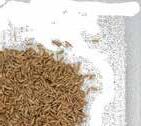
Feeding devices
Grinding systems ` Dust explosion protection

*The protein content of wheat may vary significantly due to environmental, and fertilizer use circumstances.
and three percent of adults. Figures for wheat allergy in children vary depending on age and country between <0.1% and 1 percent but then 80 percent of these children ‘outgrow’ the allergy before reaching the age of eight and 96 percent before the age of 16. The percentage of adults suffering from wheat allergy is therefore low, approximately 0.25 percent.
Based on protein analysis wheat grains contains over 1000 different proteins, several of which are classified as potential allergenic. Wheat allergy occurs as respiratory allergy (bakers’ asthma), contact urticaria (hives), and as food allergy.
The incidence of asthma (1-10 percent) and hay fever (18-29 percent) is high in professional bakers due to exposure to flour dust, which can enter the lungs during breathing. The allergic symptoms are usually reduced or disappear completely after avoiding exposure to wheat and other grains that contain gluten.
Gluten or wheat sensitivity?
There have been numerous suggestions in the media and popular press, including the popular books ‘Wheat Belly’ and ‘The Food Hourglass’, that gluten/bread consumption leads to health problems in many people due to ‘being sensitive to gluten. This has greatly stimulated consumer demand for ‘gluten-free’. However, important questions remain, on the true nature of the condition, how it can be diagnosed, the true prevalence in the population and how (and by what) the reaction is triggered.
Originally, the term ‘non-celiac gluten sensitivity’ (NCGS) was used because gluten was considered to be the causative agent. However, because other components from wheat may also play a role, the term

 Figure 1: Schematic overview of bread wheat composition and components that may be involved in health complaints.
Figure 1: Schematic overview of bread wheat composition and components that may be involved in health complaints.
Solutions
tietjen-original.com/en Tietjen Verfahrenstechnik GmbH | Germany
`
Milling and Grain - June 2024 | 47 F
It All Depends on the Grinding
for Feed Mills and Milling Companies
`
`
‘non-celiac wheat sensitivity’ (NCWS) is increasingly used. Table 1 provides a brief overview of the main characteristics of the wheatrelated diseases.
Do non-gluten components trigger adverse reactions?
Amylase-trypsin inhibitors (ATIs) are natural plant proteins that inhibit the digestion of the starch (by amylase) and protein (by trypsin) in the wheat grain by harmful insects and thereby contribute to protection of the plant. In this respect they may be considered as ‘natural plant pesticides’. However, ATIs, particularly in bakers’ asthma, may play a role in the development of CD.
Gluten and ATIs occur together in the grain and flour and are therefore both present in wheat products. They are also difficult to separate which makes it difficult to separate their effects in glutenrelated disorders.
In many studies, vital gluten (which is prepared by industrial separation from starch) has been added to a gluten-free meal (which itself serves as a control), assuming that it is 100 percent pure. However, this gluten-isolate also contains a significant quantity of ATIs, as well as other proteins. Consequently, differences in responses to consumption of ‘gluten-free’ and ‘with gluten’ foods could be caused by gluten, ATIs or both components. In addition, ATIs exist in multiple forms (at least 19 ATI isoforms in wheat) which may differ in their biological activity. Because ATIs are very difficult to purify, the effects of individual isoforms have not been determined. As a result, it is not known which isoforms and in what amounts may cause adverse health reactions in humans.
Furthermore, wheat products also contain indigestible dietary fibres, which pass into to the colon, where they are subject to fermentation by the microbiota. Some of the non-digested/non-
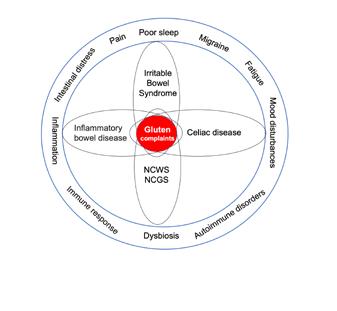
Figure 2: The strong similarities between symptoms that patients report when self-diagnosing and symptoms of other gastrointestinal disorders makes it difficult to make a rapid and correct diagnosis. Dysbiosis = abnormal intestinal flora (microbiota). NCWS: Sensitivity to wheat in the absence of CD, NCGS: Sensitivity to gluten in the absence of CD
absorbed carbohydrates are called FODMAPs (Fermentable Oligo-, Di- and Monosaccharides and Polyols). These can lead to osmosis-induced water retention in the intestine while fermentation may result in gas formation, which may result in unpleasant bloating, flatulence, abdominal pain and loose stools/ diarrhoea. There is increasing evidence that FODMAP (not gluten) are the cause of many of the complaints reported as gluten sensitivity.
When does non-celiac wheat/gluten sensitivity occur?
There is uncertainty about the occurrence of NCWS/NCGS. The available figures are self-reported and differ worldwide, with a
SETS THE STANDARD IN SQUARE SILOS
Bauck Mühle, Germany
“The biggest challenge during installation was working simultaneously with the concrete builder. This required good cooperation and planning. The installation went smoothly, with a great result. And so we contributed to one of the most modern bio-mills in Europe.”
Dennis Haman, Project leader
Location: Application: Rosche, Germany Bio grainhandling and flour

www.tsc-silos.com Scan for references!
Capacity 5.700 m³ Project details Bins 51 Width 11 m Length 35 m
48 | June 2024 - Milling and Grain F



Fane Valley, Ireland
Looking for a total feed mill solution? We’re listening
As industry experts, we understand the unique challenges you face in the animal feed industry. That’s why we are committed to assist you throughout the entire journey, from concept to complete installation. We are fully equipped to bring your vision to life!

Let’s talk partnership »
range reported for European countries of 6.2 percent to 13 percent. It is striking that the reported gastrointestinal complaints are usually present within a very short time after consumption (minutes to hours). The precise cause of the complaints is often unknown and this makes it difficult to provide specific advice to patients. Because the experience of symptoms can be strongly influenced by ‘expectations created by hearsay’, the possible role of psychological effects is very relevant. A reliable diagnosis of NCWS is at present problematic because no reliable biomarkers are available and many of the symptoms reported during ‘self-diagnosis’ overlap with other conditions such as IBS and chronic intestinal inflammation (IBD)
To better understand NCWS/NCGS, a study was carried out in Italy on patients who were referred to a university gastrointestinal clinic for a period of two years because of their complaints. 292 patients who reported that they were certain that their symptoms occurred immediately after eating gluten, were selected for further study. These individuals were required to follow a gluten-free diet
Table 1: overview of the most important
for six months and the occurrence of symptoms was recorded. After this gluten-free period, gluten was added to the diet for 1 month and symptoms were recorded.
This showed that that 86 percent of people with self-reported wheat/gluten sensitivity did not experience any effects when gluten was reintroduced into the diet. In addition, 6 percent of those selected were shown to suffer from celiac disease. It is therefore important to rule out celiac disease in case of persistent gastrointestinal complaints (which can be done by a blood test).
A small group of patients (6.88 percent) experienced symptoms after ingesting gluten (which would also contain ATIs) without celiac disease. The observation of immune reactions, changes in intestinal permeability (which allows unwanted substances and bacteria to enter the body) and increased numbers of white blood cells in the intestines in some of these patients shows that further research into the possible causes is urgently needed.
(References available upon request)
gluten-free eating followed by a gluten challenge test, the true figure is estimated to be lower (5-7 percent).
Celiac disease (CD)
Wheat allergy (WA)
NCWS/NCGS
Prevalence 0.6-2%, mean~1%, more in women than in men (ratio 2:1 - 3:1). Ca. 0.25% 6.2% to 13%*.
Time to complaints
Gut surface damage
Weeks to years
Almost always
Minutes to hours
Not observed
Symptoms Complaints pattern not different between CD, WA en NCWS.
Hours to 2 days
Not observed
Intestinal bloating, pain, diarrhea, nausea, irregular defecation/ consistency, gut microflora disturbances, inflammation. Other complaits: general malaise, tiredness, headache, anxiety, foggy mind, impaired quality of life.


 characteristics of the wheat-related disorders. CD-celiac disease, WA-wheat allergy, NCWS/NCGS-self-reported wheat/ gluten sensitivity in the absence of celiac disease. In a Dutch study this figure was 6.2 percent. *Based on testing after a period of
characteristics of the wheat-related disorders. CD-celiac disease, WA-wheat allergy, NCWS/NCGS-self-reported wheat/ gluten sensitivity in the absence of celiac disease. In a Dutch study this figure was 6.2 percent. *Based on testing after a period of
Are you ready for substantial reduction in batch time ? alfraequipment.com/en/Intro-ADA
in dosing & weighing systems and smart automation software for the nutrition and solids industry. Milling and Grain - June 2024 | 51 F
KSE Group specializes

WHEAT MILLING INNOVATION
Well-established systems and technologies in pasta production
by Luigi De Lisio, Quality manager, Colavita S.P.A, Italy
The operations involved in milling wheat are the same, whether it is durum or soft wheat. Basically, they include the following steps: grain reception, precleaning in silos, cleaning, conditioning at appropriate humidity, milling, storing, mixing, transfer to means of transportation or packaging. The flow chart of a durum wheat mill differs from a soft wheat mill in that the goal is to obtain a final product with a sharp edge, i.e. semolina (passing through a sieve with a mesh size of 0.180 mm, maximum 25 percent; presidential decree no. 187 of 09/02/2001), while in the soft wheat mill the aim is to obtain a finished product with a reduced grain size, i.e. flour. Consequently, in the durum wheat mill there is a greater number of crushing mills than in the soft wheat mill where regrind mills are preferred. As it is well known, the characteristic machine of the durum wheat mill is the purifier.
Debranning
Over the past two decades, an innovation in the milling process flow chart, applicable to both durum and soft wheat mills, has been introduced, which consists of a pre-processing stage of the caryopsis. One of the first to take an interest in this technique was the Canadian company TkacandTimm Enterprises (Port Colborne, Ont.), which had developed a “pre-processing” method in a pilot
plant, obtaining several advantages over traditional systems, such as more refined semolina and higher extraction yields, as well as a better appearance for pasta in terms of colour, without negatively affecting its cooking quality. Moreover, this method reduces the amylase activity of semolina, which is responsible for the production of reducing sugars. The latter are involved, along with amino acids, in the Maillard reaction during pasta drying, especially at high temperature. Those proposing the Tkac system (US patent) point out several advantages, such as higher profits from the special characteristics of by-products, higher plant production capacity and lower energy consumption due to a simplified milling scheme (Dexter, Martin et al., 1994; De Lisio, 1999). Barilla G. e R. F.lli Spa had also developed a method for debranning the durum wheat caryopsis, with a three-step abrasion system, to produce whole-wheat semolina and whole-wheat pasta. This method was granted two international patents. A pretreatment phase of the caryopsis also improves the quality of flour products in terms of product safety, as it results in greater removal of microbial contaminants, mycotoxins, pesticide residues and heavy metals, if any.
In this regard, few studies can be found in scientific literature. In an experiment conducted by Barroso Lopes et al. 2002, aimed at improving flour quality, soft wheat cultivars were debranned by means of laboratory and industrial equipment. Different levels of the removal process were applied to the caryopsis outer part ranging from zero tosix percent. The results showed improvements
52 | June 2024 - Milling and Grain F
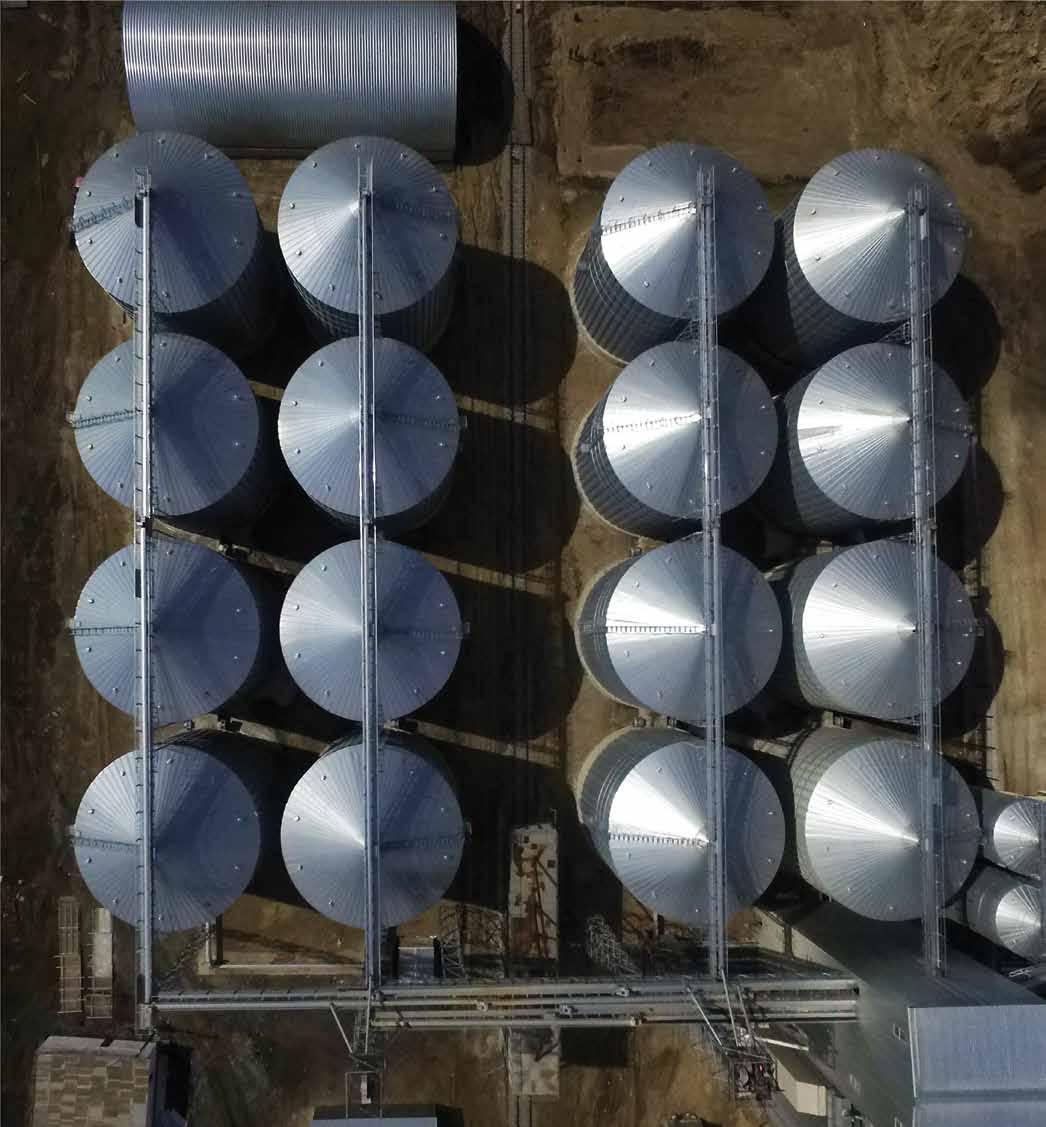

in the flour colour, an increase in ash content, a reduction in amylasic activity as well as a drop in deoxynivalenol mycotoxin (DON) content up to 70.6 percent.
In another study carried out by Tibola et al. to evaluate the DON content, phenolic compounds and antioxidant activity in soft wheat flour subject to prior debranning treatment, samples of soft wheat from three cultivars were pre-treated by a laboratory mill for rice and subsequently milled, with the corresponding comparison without debranning, by Lab Mill 3100 from Perten Instruments. In case of wholemeal flour production, the debranning treatment was performed at 2 levels, i.e. for 20 and 40 seconds. These treatment times corresponded to a caryopsis weight reduction of 1 and 2 percent, respectively. As to the reduction in mycotoxin deoxynivalenol (DON) content, reductions by 22 percent were observed for the first level of pretreatment and by 28 percent for the second level compared to the non-pretreated reference. In an article published by Forder (1997), among other things, some results and advantages with caryopsis debranning using the Peritec system developed by Satake Uk Ltd. are reported. Regarding chemical residues, the author indicates that with the Peritec system it is possible to produce flour with residue levels of certain substances of about 50 percent compared to those usually present in flour obtained by the traditional milling system (malathion 0.08 ppm vs 0.14 ppm; chloropyrifos-methyl 0.05 ppm vs 0.08 ppm; bromine 2.0 ppm vs 4.0 ppm). At that time, various research institutes including the Parco Scientifico e Tecnologico del Molise (Pst) in collaboration with the University of Molise (Cubadda, Marconi et al.), the University of Milan (Pagani et al.), the Grain Research Laboratory of the Canadian Grain Commission (Winnipeg, MB) (Dexter, Marchylo et al.) were carrying out research and testing activities concerning debranning processes and abrasion of the caryopsis.
Debranning - the Pst method: testing
Joint experimentation with various partners was carried
Table 2: Nutritional composition (% s.s.) of the starting wheat and industrial semolina obtained from 6.4% and 10.3% pearled wheat and unpearled wheat Samples
Semolina from 6.4% pearled
Semolina from 10.3% pearled
Table 3: Nutritional composition of traditional semolina (70.6% yield) and whole durum wheat semolina obtained from 6.4% debranned caryopsis (83.1% yield), (semolina was obtained from the same wheat)
Durum wheat
Cleaning
Conditioning 16.5% humidity for 15 hours
Pearling-abrasion (with 9-10% by-product)
Conditioning 16.5% humidity for 45-60 minutes
Milling
Sieving (for whole durum semolina)

Table 4: Nutritional and vitamin composition of middlings obtained from 6.4% (F1) and 10.3% (F2) pearled wheat compared to corresponding industrial semolina (S1 and S2) and unpearled wheat semolina (S3)
Samples Middling Middling Semolina Semolina Semolina
yields and ash content in flour products from domestic durum wheat (unpearled, pearled at 6.4%, 10.3% (industrial milling) Products Unpearled Pearled at 6,4% Pearled at 10,3% Yield* Ash Yield* Ash Yield* Ash (%) (% s.s.) (%) (% s.s.) (%) (% s.s.) Semolina 70.6 0.84 74.6 0.86 75.7 0.78 Fine-grain semolina 4.8 1.33 8.5 2.03 8.8 1.89 (ash > 0,90%) Middling 10.5 3.56 5.5 4.16 3.4 4.58 Bran 14.1 5.02 5.0 4.77 1.8 4.51 By-product 6.4 5.9 10.3 5.85 *
Table 1: Milling
The actual yield is per 100 kg of cleaned wheat, less the pearling waste
Available carbohydrates Lipids Ash Dietary fibre (% s.s.) (% s.s.) (% s.s.) (% s.s.) (% s.s.) (% s.s.) Starting wheat 9.6 13.4 76.9 2.1 1.8 9.8 Semolina from starting wheat 14.9 12.1 82.7 1.0 0.84 3.2
wheat 14.1 12.7 81.7 1.2 0.86 3.73
wheat 13.9 12.4 82.0 1.2 0.78 3.87
Humidity Proteins
F1 F2 S1 S2 S3 Humidity (%) 13.2 12.9 13.3 13.2 14.9 Proteins (% ) 12 12.1 11.0 10.9 10.3 Lipids (%) 2.4 2.3 1.1 1.2 0.9 Avail. carbohydrates (%) 64.5 64.8 70.7 70.7 70.5 Ash (%) 1.59 1.50 0.74 0.71 0.71 Dietary fiber (%) 6.3 6.4 3.2 3.3 2.7 Riboflavin (mg/ kg) 0.91 0.94 0.47 0.50 0.31 Thiamine (mg/ kg) 3.02 3.35 1.61 1.22 1.20 Tocopherols tot. (mg/ 100 g) 1.38 1.37 0.59 0.44 0.44 Carotenoids tot. (µg/ 100 g) 210.6 212.1 234.4 233.3 231.1
Components Traditional semolina Whole durum wheat semolina Proteins (% s.s.) 12.1 12.8 Avail.carbohydrates (% s. s.) 82.7 81.2 Lipids (% s. s.) 1.0 1.4 Ash (% s. s.) 0.84 0.96 Dietary fiber (% s. s.) 3.2 4.8 Lysine % g of protein 2.1 2.6 Thiamine (mg % g) 0.3 0.42 Tocopherols (mg % g) 0.4 0.9 Iron (mg % g) 1.3 2.2 Yellow index 23.1 20.6
54 | June 2024 - Milling and Grain F
Figure 1: Milling flow chart with prior abrasion of caryopsis

out at the Pst to investigate various aspects and results that can be achieved with the caryopsis pre-treatment process including the levels of caryopsis abrasion considered as most appropriate, milling yields, the quality features of flour products and by-products, as well as pasta production. Specifically, the experimentation was carried out using the Pst laboratory and pilot plants, and as third party contractors , , the laboratories of Università del Molise , the laboratory and plants of Bühler spa (Uzwil-Switzerland) and a Bühler industrial milling plant (former durum wheat mill for La Molisana Spa, Campobasso). At the Pst, a preliminary pearling of the caryopsis at 5 different levels (3, 6, 9, 12 and 15 % waste) was carried out by means of a Namade abrasion debranning machine followed by milling by a Bühler Mlu 202 experimental mill using domestic and Australian durum wheat. Tests were conducted by carrying out simultaneous microscopic tests on caryopsis sections to follow the removal steps of the outer pericarp layers and aleurone layer.
The results of the experimentation
Chemical and rheological analyses were carried out on the flour and intermediate products; no significant variations in the parameters tested were found, except for dietary fibre and ash content, which decreased as the level of pearling treatment in the caryopses increased. Based on the preliminary results, industrial pearling tests were carried out at two levels (6.4 and 10.3%) at Bühler using an industrial debranning machine followed by milling by means of an industrial-type compact plant with a working capacity of 200 kg/h. The same domestic durum wheat used in the studies carried out at Pst was also used for the test. Along with debranning tests, microscopic tests were conducted on the caryopsis sections to monitor the process and avoid
Advanced grain chilling – keeps crop at target moisture
The CROP-PROTECTOR Chiller offers a unique way to preserve stored grain, and a unique feedback sensor lance enables energy savings and improved chilling efficiency.
It is the only chiller in the world that uses a feed-back moisture sensor lance to control the chiller and protect the grain.
The CROP-PROTECTOR Chiller ensures that the crop is chilled gently, with no risk of condensation issues, and it is designed to cool the crop with a minimum moisture loss.
The CROP-PROTECTOR Chiller is equipped with a very strong fan, allowing the chilled air to pass through the grain mass at a high speed, cooling the grain uniformly and minimising large temperature differences between layers in the storage silo.
Advantages:

• Keeps the crop safe in many difficult circumstances (climate, infestation, etc.)
• Stalls emerging infestation of insects and fungi at an early stage
• Avoids use of toxic fumigation
• It adapts to any climate zone



Table 5: Characteristics of pasta made from traditional semolina, from 6.4 % and 10.3 % debranned semolina, from whole durum wheat semolina with 6.4% debranned caryopsis Parameters Traditional semolina pasta 6.4% debranned caryopsis semolina pasta 10.3% debranned caryopsis semolina pasta whole durum wheat semolina pasta Appearance Good Good Good Good Colour (yellow index) 36.9 33.8 32.4 31.2 Cooking quality Score 68 74 76 70 Organic substance 1.4 1.2 1.3 1.4 (g starch/ 100 g pasta)
6: Nutritional composition (% s.s.) of traditional semolina pasta and whole durum wheat semolina pasta Samples Humidity Proteins Avail. Carbohydrates Lipids Ash Dietary Fiber (% s.s.) (% s.s.) (% s.s.) (% s.s.) (% s.s.) (% s.s.) Traditional pasta 11.2 12.1 82.7 1.6 0.86 3.1 Whole durum wheat semolina pasta 11.2 12.8 81.2 2.5 0.96 4.8
Table
CROP-PROTECTOR - info@toxi-scrub.com - www.crop-protector.com
sensor lance MAG Half Page 06-2024 Chiller.indd 1 06/05/2024 15.29.19 Milling and Grain - June 2024 | 55 F
Moisture
excessive removal of the aleurone layer which is rich in nutrients. The industrial tests largely confirmed what had been highlighted with the Pst pilot plants. Domestic durum wheat, without prior debranning, was ground in the former Bühler industrial durum mill of La Molisana spa with a working capacity of 300 t/24h and equipped with a traditional milling flow chart consisting of six breaking mills, six detatching mills and two regrinding mills.
Table 1 outlines the industrial milling yields from which it is seen that it’s possible to increase semolina yield by 4-5 units with the pearling of the caryopsis compared to the traditional system without pearling and, consequently, it is possible to reduce the quantity of by-products, i.e. bran and middling that derive from it.
Composition and nutritional aspects
Table 2 shows the nutritional composition of semolina obtained by pearling the caryopsis, which has a slightly higher fibre and protein content than conventional semolina.
Putting the pearling-abrasion treatment before the milling process allows the mill to differentiate the flour products according to the market demand. For example, it is possible to obtain a whole durum wheat flour product with an ash content higher than the national legal limit of 0.90 percent s.s., but with a better composition in macro and micronutrients than refined semolina and with yields that are impossible to reach with traditional milling (83.1% vs. 70.6%) (Table 3).
With this new milling technique, fine semolina (middlings) can be obtained and have interesting nutritional properties, compared to the corresponding semolina obtained from pearled and un pearled wheat, in that they contain significantly higher amounts of dietary fibre and macro- and micronutrients, in particular B vitamins and tocopherols (constituents of vitamin E), (Table 4). Middlings may represent an opportunity for processing companies to differentiate their products as these ingredients can be used to produce functional pasta.
New milling flow chart
Experimentation had led to the identification of a new caryopsis milling flow chart as shown in Figure 1. If one intends to producewhole durum wheat semolina, some variations to the flow chart shown in Figure 1 are necessary since the initial conditioning time is reduced to about 3 hours, the degree of pearling from 9-10 percent drops to 6 percent and, finally, a sieving phase should be integrated so as to remove coarse bran particles.
Quality characteristics of pasta
With semolina obtained through prior abrasion of the caryopsis, pasta was produced using the Pst pilot plants whose cooking characteristics (Table 5), assessed by sensory analysis and chemical methods, turned out to be similar to those obtained with traditional semolina. On the other hand, the colour, as defined by measuring the yellow index, was slightly lower for pasta produced from whole durum wheat semolina.
Table 6 shows the nutritional composition of pasta made from traditional semolina and from whole durum wheat semolina; it can be seen that the latter, obtained through caryopsis debranning, allows for an increase in the protein level and, above all, in the dietary fibre of the processed product compared to traditional semolina pasta.
The research concluded that the inclusion of a caryopsis pretreatment step makes it possible to simplify industrial milling flow charts, increase the production capacity of a traditional mill within the same available space, and reduce the investment required in certain machines (rolling mills, planifters, purifiers, etc.) for new plants.


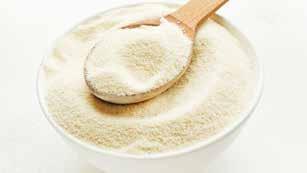



56 | June 2024 - Milling and Grain F
Other industrial proposals
At an industrial level, some plant construction companies had developed debranning systems, Satake Corporation had developed the “Peritec’” method; Berga-Sangati had developed a wet vertical debranning machine with a more complex inserted unit called the Kombi Unit (De Lisio, 1999). Bühler Spa and Ocrim Spa had also introduced their wheat debranning equipment onto the market.
Stone milling
Information campaigns by national and international organisations and institutions aimed at guiding consumption towards a healthier diet that favours, among other things, foods with a higher fibre and vitamin content, research activities in the nutrition sector, the enactment of EU regulations allowing the use of nutritional and health claims for foods, etc., these are some of the reasons that have led to an increased consumer demand for health foods in recent years, with a preference for foods based on whole grains. To meet consumer’s demands, plant manufactures, cereal users and processors have organised themselves upon rediscovering another ancient technique, i.e. stone milling, which makes it possible to produce flour products containing all the nutritional constituents that can be found the caryopsis. Stone milling makes it possible to produce whole durum wheat semolina that meets the requirements of current regulations and can be used for pasta production (Presidential Decree of 09/02/2001, no. 187; Presidential Decree of 05/03/2013 no. 41).
Considerations
The current rules governing the production and marketing of flour and pasta should be updated in some respects. Specifically, considering the recognised physiological and health effects of
dietary fibre and for the sake of greater transparency for consumers, the product classification of durum wheat flour products and pasta should include the fibre parameter for whole durum wheat semolina and whole durum wheat semolina pasta. Something similar should be extended to the product classification of wholemeal soft wheat flour products and the most widely consumed processed product such as bread. Recently, the “Whole Grain Initiative”, a partnership between organisations and experts carrying out various initiatives in the whole grain sector, drew up a definition of “whole grain” and “whole food”, with the agreement of the parties concerned. Both definitions are shown below:
“Whole grains consist of undamaged, ground, crushed, flaked or otherwise processed caryopses/seeds after removal of non-edible parts such as glumes and seed-coats; all anatomical components, including endosperm, germ and bran, must be present in the same corresponding ratios as the caryopsis/whole seed”;
“A whole food must contain at least 50 percent whole ingredients on a dry weight basis. Foods that contain 25-50 percent whole grains on a dry weight basis may indicate the presence of whole ingredients on the front of the package, although they cannot be defined as “whole-grain”.
In addition, it is recommended that “the percentage of wholegrain ingredients in the food is indicated on the front-ofpackage labelling to ensure fair practices in the food trade and facilitate comparison of products for customers”. In my opinion, as a complement to the proposals promoted by the “Whole Grain Initiative”, it would be appropriate to recommend that the amount of dietary fibre, expressed in grams and contained in 100 grams of the product (or with similar wording), should also be stated on the front of the package of a whole-grain food.
References available on request

Automatic Aeration Control in Grain Silos
The iGRAIN Aeration Control Module is an indispensable tool to reach the target moisture and temperature and in the fastest possible way.
The iGRAIN Aeration Control Module applies true Equilibrium Moisture Concentration (EMC) aeration control. It supports safe storage of crops and it is 100% automatic
Advantages:
• Reaches target moisture and temperature automatically
• Adapts to any climatic zone
• True EMC aeration control
• Prevents grain moisture loss
• Saves power - fans only run when it makes sense
• Fully automatic or semi-automatic options
Aeration control is the single most important issue in grain storage. In fact, it is the only operational parameter after storing the grain in the silo. The iGRAIN aeration manager systems automate the task of maintaining optimal storage of your grain at the target moisture.

iGRAIN - Denmark - info@i-grain.net - www.i-grain.net Power relais Control room PLC/SCADA system iGRAIN Dashboard Manager MAG Half Page 06-2024 Automatic Aeration Control new.indd 1 06/05/2024 16.13.05 Milling and Grain - June 2024 | 57 F
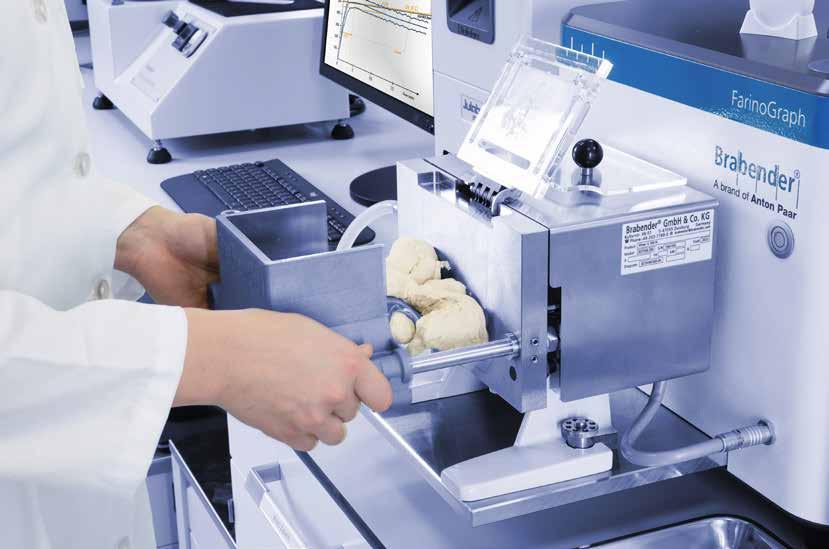
Dough testing
Efficient dough testing with the Brabender FarinoGraph
by Nicole Kuska, Content Manager, Brabender, Germany
The new Brabender FarinoGraph is even more versatile with different measuring mixer attachments for various sample types, carrying out measurements quicker than ever before.
When processing dough in the bakery industry, be that gluten-free dough, sponge dough, rye flour or hard biscuit dough, the rheological properties of the dough and the water absorption capacity of the flour to be processed are particularly important. The right amount of water is crucial for the consistency of the dough and, ultimately, for the quality of the end product.
For almost a century, the Brabender FarinoGraph wheat and wheat flour tester has proven itself as the standard for analysing doughs and flours.
The FarinoGraph has established itself as a global standard and ensures that baked goods can always be offered in the same quality.
Originally developed in 1928 by Carl Wilhelm Brabender, founder of the company of the same name, the FarinoGraph, Brabender Unit (BE) and Farinogram Unit (FE) are standard in school books and practice. In August 2023, Anton Paar acquired Brabender, meaning that both companies are now under one roof. Since then, customers have benefited from an expanded product range of extruders, rheometers and viscometers and also have access to Anton Paar’s global service and sales network.
Wide range of mixing and kneading attachments for quality control
The FarinoGraph makes it possible to improve quality control processes in the bakery industry and optimise recipe development. This is made possible by state-of-the-art technology and various mixing and kneading attachments for a wide range of applications for comprehensive control of the end product at different stages of the value chain.
Depending on the sample quantities and sample type, a different measuring attachment is recommended to achieve optimum measurement results.
For example, the S10 measuring mixer is particularly suitable for small sample quantities of up to 10 grams, such as when developing recipes for breakfast cereals. The S50 measuring mixer is ideal for developing bread or pasta and the S 300 measuring mixer is the perfect choice for standard Farinograph tests with larger sample quantities of up to 300 grams.
The S300 measuring mixer is also ideal for kneading dough for extensograph tests. It is used in bakeries. All measuring kneaders have removable blades for easier cleaning. The 50 gram and 300 gram measuring mixers both work according to the current ICC, AACCI, ISO standards and others, so that wheat samples can be characterised according to international and national standards.
The P600 Planetary Mixer can be used in a variety of ways for customised recipe creations, from rye doughs to foamy masses. It has various mixing tools, such as a dough hook, flat beater and balloon whisk for different types of dough. The container volume of 2500 ml and the temperature control from approximately -5 °C
58 | June 2024 - Milling and Grain F

55 million m3 built
New pendular and rotative sensors
ATEX 20 certified, the zone with the highest risk
· SY-DP1 Pendular . Robust and simple. It does not require power and maintenance.
· SY-DR1 Rotative . Sensitive. It has 2 operating modes depending on the density of storage material.


symaga.com • +34 91 726 43 04 • symaga@symaga.com
A reliable team for a reliable project YOUR RELIABLE PARTNER
Projects in 150 countries Top Project worldwide Flexibility and adaptability






Your Team for Great Flour
























The desire for more sustainability and a exible choice of raw materials is growing, as is interest in composite our – combinations of wheat and non-wheat grains like maize, manioc and millet – to stabilize worldwide food supplies. The pioneers in innovative, sustainable enzymes for composite our: The Flourists, a team of experts specializing in enzyme combinations for diverse our mixes. Their development focus: Compozym, the MC brand for custom- t enzyme systems that enable replacing up to 20 percent of the wheat without impairing the quality of the nished product. The result: High-quality individual ours with non-wheat components, whose quality wins over bakers and consumers alike.
First-Class Flour from Regional Grains –
#the ourists muehlenchemie.com For Diversity in Baking. The Flourists, Part 4: Composite Flour
to 150 °C make it flexible to use.
In order to be able to develop an optimal dough recipe, it is not only important to test the flour quality but also to analyse the whole grain. The Hardness and Structure Tester can be used to determine the grain hardness of the cereal and thus optimize the milling process. The device helps to perfect the grinding characteristics and thus increase the flour yield
It is connected to the Brabender FarinoGraph instead of a kneader. The measurement results are displayed in the form of a performance-time diagram. But the hardness tester can do even more: it determines the exact brittleness of the malt. If you combine the hardness determination with the grist mash test, you get a clear idea of the dissolution of the malt, which the brewer can use as a guide when grinding and mashing in the brewhouse.
Optimisation of product quality
By measuring the water absorption capacity of flour, the manufacturer can determine the optimum amount of water required for each flour. This helps avoid consistency problems and improve product quality. But the rheological properties of a dough, such as its stability, development time and degree of softening, also directly influence the processing properties and quality of the end product. By measuring these properties with the FarinoGraph, producers can precisely control the dough consistency and ensure that it meets the desired standards. These national and international quality standards in the food industry must be adhered to in order to ensure the safety and consistency of the products, and thus, the required quality.
Artificial intelligence predicts measurement curve progression

Saving time during measurement is also possible with the AutoStop function. With the help of intelligent stop criteria, such as torque drop, reaching all evaluation points and the energy level, the measurement can be stopped, saving 25 percent of the measurement time. Many customers also schedule buffer times for the measurements to ensure they are complete: With the AutoStop function, this time is now eliminated as soon as all evaluation points have been reached.
The Brabender FarinoGraph has been made even quicker, thanks to Brabender Prediction. This is a function that reduces test times by up to 50 percent by predicting the remaining measurement curve, thereby increasing the daily throughput of measurements to be carried out. The function for predicting the measurement curve is based on artificial intelligence, which makes predictions based on previous measurements.
The AquaInject has also been optimised specifically for timesaving purposes with the new FarinoGraph as a more precise alternative to the piston burette. The AquaInject is an automatic water dosing system for everyday laboratory use, but can also be used as a stand-alone dosing system with other devices. The automatic dosing system eliminates the need for the usual manual titration, including the tedious and time-consuming task of refilling the burette. With the AquaInject, automatic and precise titration curves can be created, eliminating the need for manual experiments.

Milling and Grain - June 2024 | 61 F
not your cows’ best friends Endotoxins and heat stress
 by Jade Wouters, Product Manager & Kurt Van de Mierop, Director, Nutrex, Belgium
by Jade Wouters, Product Manager & Kurt Van de Mierop, Director, Nutrex, Belgium
As many regions around the world experience hot and prolonged summers, heat stress poses a major challenge in dairy farming. Additionally, the high productivity of modern cows’ results in increased internal heat production, further contributing to this heat load.
Heat stress occurs when cows’ heat load exceeds their ability to dissipate heat efficiently, leading to physiological overload. This condition not only compromises the welfare of dairy cattle, but also significantly impairs their production performances. One of the most concerning consequences of heat stress is its negative impact on milk yield and quality. In addition, heat stress also causes animals to be more exposed to endotoxins. Endotoxins are bacterial components that can further amplify the direct negative effects of heat stress. The complicated relationship between heat stress and endotoxins poses a significant threat to both milk production and ruminant health and is further described below.
Regardless, there is no question that proactive measures are needed to mitigate these negative effects as global temperatures continue to rise and productivity is pushed to its limit.
Heat stress reduces milk yield and quality
During heat stress, cows try to regulate their body temperature by reducing their feed intake to minimise the heat released during digestion. However, this reduced feed intake means they do not meet the energy and protein requirements needed for optimal milk quality and production.
In addition, heat-stressed cows have difficulty mobilising fat tissue, leading to an increased reliance on glucose as an energy source. Consequently, there is reduced availability of glucose for milk production. During heat stress, amino acids, which are crucial for milk protein production, are mainly used for
maintenance processes and immune system strengthening instead of for milk protein synthesis.
Finally, heat stress also affects the integrity of cell-cell connections in mammary gland cells leading to poor mammary gland development during the dry period. This, in turn, significantly reduces milk production during the subsequent lactation period.
Apart from decreased milk production and quality, heightened somatic cell counts (SCC) are often observed during the summer months. In hot weather, cows undergo more physical stress, leading to decreased productivity as they seek cooler places to rest and spend less time feeding. This behavioural change, coupled with reduced activity, increases the risk of mastitis, as prolonged exposure to bacteria at the teat ends is more prevalent. Research also highlights the impact of increased stress hormone levels during heat stress on the effectiveness of the immune system in fighting bacterial infections and endotoxins.
The effect of endotoxins on dairy cattle during heat stress
Endotoxins, specifically lipopolysaccharides (LPS), are heatstable structural components of the outer membrane of bacterial cell walls. These potentially toxic compounds are produced by both beneficial and pathogenic gram-negative bacteria and are released when they multiply or undergo lysis. Endotoxins are ubiquitous, with the main sources being bacteria in the gastrointestinal tract, the rumen, animal feed, water and infections caused by gram-negative bacteria.
• Once released, endotoxins can trigger a powerful inflammatory response when they enter the bloodstream. This comes at a great cost because this immune response consumes energy and nutrients needed for milk production. In addition, endotoxins can contribute significantly to the development of various metabolic disorders such as fatty liver, milk fever and lameness.
62 | June 2024 - Milling and Grain F

Made in Britain, Trusted Worldwide.
Join the growing number of the worlds most successful feed companies already trusting Holmen equipment to check, monitor, and continually maintain their animal pellet durability...

















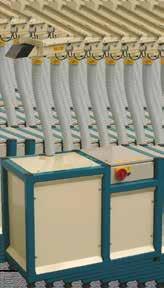

Figure 1: Damaged epithelial barrier with tight junction proteins (=) between the epithelial cells. Where tight junctions are no longer present, paracellular transport of endotoxins (LPS) into the blood circulation is possible, which can eventually lead to inflammation.
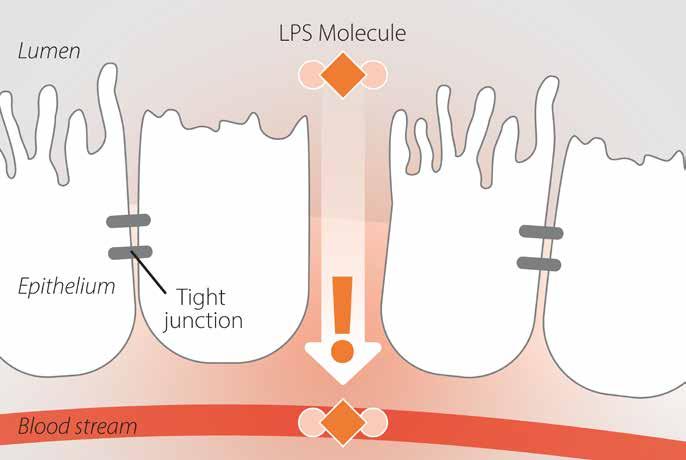
Heat stress increases intestinal permeability, facilitating endotoxin leakage
Under normal conditions in healthy animals, the integrity of the intestinal barrier is maintained by epithelial cells that are tightly interconnected and reinforced by tight junction proteins, which are cell-cell adhesion complexes that regulate the paracellular flow of solutes. This physical barrier acts as a crucial defence that keeps bacteria, endotoxins, enzymes, and food particles within the intestinal lumen and prevents them from entering the bloodstream. Besides this physical barrier, an additional biochemical barrier of detoxifying enzymes prevents the leakage of endotoxins from the lumen to the blood circulation.

Milling and Grain - June 2024 | 65 F
However, several factors, including heat stress, weaning, mycotoxins, feed transitions and the presence of pathogens in the gut, are known to increase epithelial permeability and thus endotoxin leakage. During periods of heat stress, the body attempts to dissipate as much heat as possible by decreasing blood flow to the organs and increasing that towards peripheral tissues, such as the skin. Lower blood flow to the intestine reduces the supply of oxygen and nutrients to the epithelial cells, compromising the integrity of the tight junction proteins and thus that of the intestinal barrier. This weakening facilitates the leakage of endotoxins into the bloodstream (Figure 1).
In ruminants, leakage of endotoxins can also occur through the epithelium of the rumen. This epithelium is multi-layered and cornified and forms a protective barrier against endotoxin leakage under normal conditions. However, disruptions occur in this rumen barrier when a cow experiences acidosis, for example as a result of feeding highly fermentable carbohydrates. These changes increase the risk of endotoxins entering the bloodstream from the rumen.
Elevated risk for endotoxemia
Once endotoxins are absorbed, they will be detected by specific receptors (e.g. TLR-4 receptors) that stimulate the production of pro-inflammatory cytokines. These cytokines initiate inflammation by acting as signalling molecules that trigger other immune cells to move to the inflamed area and release even more pro-inflammatory cytokines, setting off a chain reaction. This process modulates the functioning of various tissues and triggers the liver to produce acute-phase proteins.
The increased immune responses will consume energy and nutrients needed for growth and milk production.
In severe cases, elevated endotoxin levels in the blood (endotoxemia) can cause septic shock and even death. Thus, it is critical to minimise the transfer of endotoxins into the bloodstream and tissues. Endotoxemia can be prevented by minimising damage to the intestinal barrier or by reducing the number of endotoxins in the gastrointestinal tract and rumen, for example by detoxifying the endotoxins.
EndoBan
protects gut health and improves production performance
Nutrex developed an innovative feed additive called EndoBan, which integrates multiple strategies to reduce the translocation of harmful endotoxins into the bloodstream. First, EndoBan removes free endotoxins from the rumen and gut lumen by physically binding them and removing them via the faeces. Secondly, EndoBan reduces endotoxin toxicity by stimulating the production of LPS-detoxifying enzyme, intestinal alkaline phosphatase (IAP)(Figure 2).
This double protection shields the animal from the adverse effects of endotoxins. EndoBan supports dairy cows during heat stress by reducing leakage of endotoxins into the bloodstream, which prevents inflammatory responses that would otherwise
• Multiple trial results have shown that EndoBan improves milk production and quality (fat, protein and lactose content), and significantly reduces somatic cell counts in dairy cows, in normal conditions as well as in challenging situations. EndoBan is recommended for use in situations where gut barrier integrity is challenged by various environmental and nutritional factors (heat stress, mycotoxins in the feed, weaning stress, pathogens, etc.). Moreover, its use is particularly encouraged in conditions where endotoxins are more prevalent such as during heat stress, in case of high-carbohydrate diets, post-antibiotic treatment or feed transitions.


A comprehensive production enterprise of grain and food machinery with strong overall support. We attach great importance to the joint development of new products by industry, academia and research, and is a key project cooperation unit of related higher research institutions in the industry.


Flour Machines
We create Mobile: +86 15143746509 Tel: +86 437 3519196 Email: cherry@lyruiyi.com
& Turnkey Solutions
lyruiyi.com Liaoyuan Ruiyi Grain Machinery Manufacturing Co., Ltd. Established in 2005 Use our QR code to nd out more 66 | June 2024 - Milling and Grain F


drain energy from milk production. Consequently, EndoBan maintains or even increases milk production despite heat stress due to rising temperatures or high metabolism.
To conclude…
As temperatures rise, heat stress will increase potential
WHAT TO EXPECT FROM ENDOBAN:
• EndoBan limits the leakage of endotoxins through the rumen and gut barrier
• EndoBan prevents energy-consuming inflammatory responses
• EndoBan improves milk production and milk quality
• EndoBan reduces somatic cell counts
• EndoBan improves ruminant health
endotoxin-related problems in dairy cows by increasing intestinal permeability. This increased permeability facilitates the transfer of endotoxins to the bloodstream, leading to inflammatory reactions, endotoxemia and production losses. Addressing heat stress is therefore necessary, not only to mitigate its direct effects, but also to minimize the associated endotoxinrelated challenges to ensure the overall health and productivity of dairy cattle. EndoBan has proven its effectiveness in reducing the adverse effects of endotoxins, resulting in improved milk production and quality. In addition, EndoBan effectively reduces somatic cell counts, leading to healthier cows and improved performance.








2: Mode of action of EndoBan
Figure
68 | June 2024 - Milling and Grain F

Anton Paar Offers an Unbeatable Portfolio for Food Analysis Material characterization of food Determine viscosity and mouthfeel Measure oxidation stability to investigate shelf life Analyze the particle size of food powders Additional solutions for density determination, X-ray diffraction and much more www.anton-paar.com

DOWNTIME PREVENTING
Moving Beyond Break/Fix to Prevent Downtime of Critical Animal Feed Conveyors
by Del Williams, On behalf of Cablevey Conveyors, California, USA
To optimize production and extend the lifespan of tubular drag cable conveyors, it is ideal to involve an expert OEM for total preventative maintenance
Animal feed processors often rely on tubular drag cable conveyors to move sensitive materials and powders; therefore, it is important to properly design, install, and proactively maintain these systems to minimize production downtime and maximize longevity.
In today’s fast-paced animal feed processing environment, it is a standard practice to run conveyors until something breaks or needs to be repaired, which can lead to significant unnecessary downtime.
“Processors traditionally have relied on third parties such as local millwrights to install and maintain conveyors. These third parties may not have access to technical specifications or have not had the opportunity to read the manual and can therefore be unaware of system acceptable specifications and best practices. This can result in not only excessive downtime and maintenance, but also costly repairs and even premature system replacement,” says Fernando Mejia, Director of Product Life Cycle Management & Aftermarket for Automated Handling Solutions (AHS).
AHS combines the strengths of two market leaders, Cablevey Conveyors and Spiroflow, to provide customers with a specialized
handling and automation product portfolio for mission-critical applications.
For animal feed processors, instead of reacting to individual problems as they arise, a more effective approach is to implement total preventative maintenance (TPM) for conveyors. This involves ongoing service and engineering support, resulting in reduced downtime and lower Operations and Maintenance (O&M) costs.
“We are here to assist customers reducing their total O&M costs. We are looking forward to partnering with our customers to inspect their systems, review layouts, and formulate a total preventative maintenance plan based on their needs. Failing in this, customers may continue to replace parts prematurely with all the needless downtime this involves,” says Mejia.
According to Mejia, the goal of a TPM program is to work with our customers to maximize the output of their conveyors and extend the lifespan of their critical capital equipment.
The Value of Prevention
With the sophistication of state-of-the-art conveyors, proactive, preventative, and predictive maintenance is an effective strategy. This is the case with tubular drag cable conveyors, which gently move product through a sealed tube using a coated, flexible stainless-steel drag cable pulled through on a loop. Solid circular discs (flights) are attached to the cable, which propel the product through the tube without the use of air.
70 | June 2024 - Milling and Grain F STORAGE & HANDLING MAXIMISED
































SHIPLOADER SPECIALIST
NEUERO produces the most reliable and high-quality bulk ship loaders worldwide | neuero.de/en






















While it is possible to utilize third parties to install the systems and in-house maintenance teams to maintain them, there are considerable advantages to involving an OEM Supervisor, since they possess unparalleled training and expertise on the system.
OEM technicians typically have years of experience exclusively servicing and troubleshooting tubular drag style conveyors. Our technicians have conducted hundreds of inspections in plants worldwide that run any material imaginable, from powders and blends to animal feed, cereals, coffee beans, nuts, and more.
“Many recurring problems stem from incorrect installation, which can involve improperly positioning the conveyor’s hangers, excessive tension, misaligning tubing, leaving gaps, or insufficient supports. All these defects can generate friction, noise, and prematurely wear parts, requiring replacement,” says Mejia.
An OEM can also proactively recommend the appropriate spare parts kits or high wear parts such as cables, connectors, or sweeps that are known to have shorter lifecycles. This method encompasses assessing both the condition and usage of the conveyor, while also leveraging predictive data to efficiently resolve numerous issues before any downtime occurs.
“As the OEM, we can analyse system usage as well as component wear and lifecycle data to accurately predict when vital parts will likely need to be replaced and have them replaced before something breaks,” says Mejia.
“The more a processor adheres to this type of total preventative maintenance schedule, the more likely the conveyors will provide optimal service throughout their anticipated lifespan,” adds Mejia.
A comprehensive annual inspection of the conveyor system by the OEM is highly recommended. With the shortage of skilled mechanics combined with high employee turnover, we are here to perform in-depth inspections and recommended maintenance. This solution is mainly targeted to processors that have one or multiple tubular drag conveyors running constantly throughout the year.
According to Mejia, detecting problems such as gaps or misalignments requires camera inspection. The annual inspection also assesses the conveyor’s tubes, walls, sweeps, connectors, input, and output. In addition, cables should be checked for integrity and tension, discs and sprockets for wear, and joints should be validated.
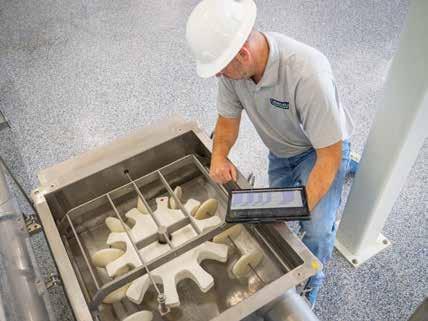

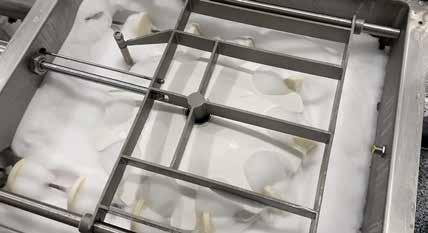
During the inspection process, the OEM can recalibrate or replace any components outside of system specifications. In the case of AHS, service technicians also advise on the use of any available update or retrofit kits that can further facilitate increased output.
While the frequency of the annual service visits depends on the system application and environment conditions, several factors can help determine the optimal frequency. As a partial list, this can
include the type of conveyor systems in the facility, system length and complexity, average daily use, environment conditions and the type of material conveyed. When these factors are analysed, a service visit might be scheduled once or twice per year, as the situation warrants.
Many animal feed processors can benefit greatly from collaborating with a knowledgeable conveyor OEM to establish
Milling and Grain - June 2024 | 73 F

a comprehensive preventative maintenance plan. For instance, Mejia highlights the case of a processor that aimed to revamp their maintenance strategy.
This customer had expanded operations and was about to double their capacity. Although their conveyors were running well, they didn’t want to risk unnecessary downtime. “So, they told us, ‘We would like to avoid the ‘break/fix’ approach and move forward to a total preventative maintenance culture,’” says Mejia. “I was thrilled to hear that our goal and vision were aligned.”
To meet the demands of the animal feed industry and address
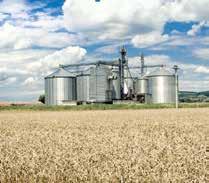

the requested services, AHS is increasing their service capacity to assist processors in proactively mitigating issues and minimizing downtime. The OEM will be establishing a service hub and parts depot on the West Coast, enabling localization, onsite inspections, and comprehensive preventive maintenance by qualified technicians with a local presence.
The OEM is now offering long term service agreements that will comprehensively cover all aspects of maintenance, so the animal feed processor can focus on their core business with confidence in the performance of their conveyors.

• Protection against insects & fungi
• Without chemical treatment
• Short amortisation period
• Independent of ambient wheather
• Low energy demand
• No respiratory losses
The natural way of grain preservation frigortec.com Made in Germany GRANIFRIGOR™ Grain cooling 74 | June 2024 - Milling and Grain F
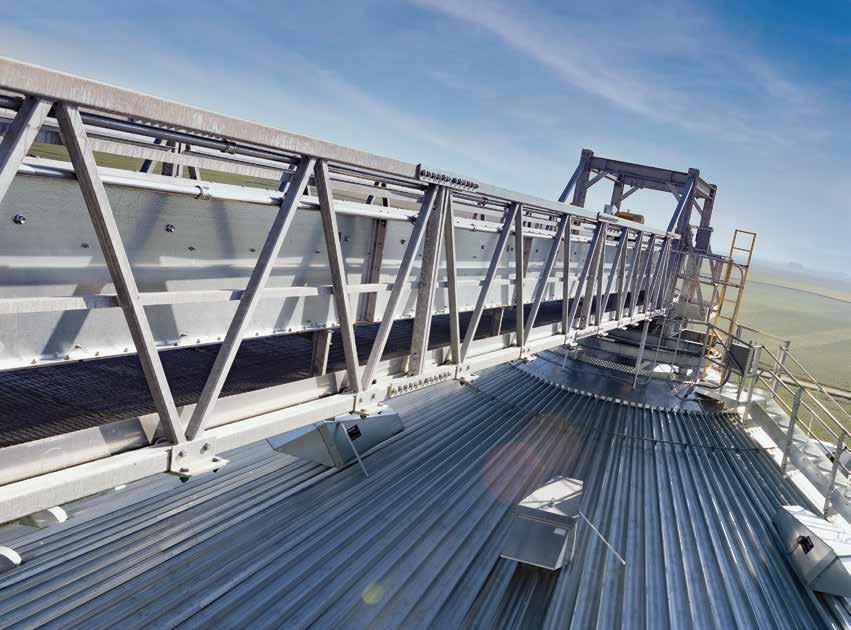
We know all the angles. Keep your drags clean and prevent moisture buildup with 10° angled flights on Brock Horizontal and Curved Incline Drag Conveyors. Brock® Enclosed Roller-Belt Conveyor Systems offer high capacities and gentle grain handling for commercial and mill operations. Either way, learn how you can move grain more efficiently with Brock. brockgrain.com/handling-commercial CONVEYORS Storage | Handling | Drying & Conditioning | Structures 812.886.5500 sales@brockgrain.com

Grain frоm Ukraine initiative
Sudan receives the
second batch of Ukrainian Grain
Grain from Ukraine is a humanitarian food programme launched by President of Ukraine Volodymyr on 26 November 2022 and presented during the first inaugural International Food Security Summit in Kyiv
The MV Future ID vessel has arrived in Sudan with 14.6 thousand tonnes of flour milled from Ukrainian wheat. This is the second consignment of humanitarian aid under President Zelenskyy’s Grain from Ukraine initiative, which was sent to Sudan by the World Food Programme (WFP).
The first batch of humanitarian aid was delivered to the port of Khartoum (Sudan) on 22 February 2024. The MV Ocean Dream brought 7.665 tonnes of flour made from Ukrainian wheat.
The donors of the two shipments were Germany, which provided US$ 15 million, as well as Belgium, Canada, the Czech Republic, Hungary, Ireland, the Netherlands, the Republic of Korea, Slovenia and Spain, which financed the second shipment of flour in the amount of US$ 23.8 million.
The flour made from Ukrainian wheat will be distributed by WFP as part of food packages for 2 million people in Sudan affected by the war.
Almost 18 million people in Sudan are currently facing acute food shortages. According to the UN, about five
million of them are in a state of extreme hunger (IPC4).
The harvest of staple crops (sorghum, millet and wheat) is 41 percent below the average over the past five years.
Therefore, food aid through the Grain from Ukraine initiative is extremely important to save lives and prevent an even worse situation.
Grain from Ukraine is a humanitarian food programme launched by President of Ukraine Volodymyr on 26 November 2022 and presented during the first inaugural International Food Security Summit in Kyiv. As a result of the Summit, the Grain from Ukraine programme has accumulated support in the amount of about USD 220 million. The amount of the contribution and the number of donor countries are not final. It is planned to increase the contributions of individual countries, as well as to attract new countries and enterprises to participate in the initiative. In cooperation with the UN World Food Programme, Ukraine and the programme’s partner countries identify recipient countries for Ukrainian grain from among those countries facing acute food shortages. More than 30 countries and international organisations have joined the Grain from Ukraine programme.
76 | June 2024 - Milling and Grain CASE STUDY




SEFAR NYTAL ® . The name you can trust. Since 1830, Sefar is the single-source supplier to millers for all products for sieving, grading, and dust filtration as well as connector sleeves, sieve cleaners and tensioning equipment. FOOD SAFETY FDA COMPLIANT Headquarters Sefar AG Hinterbissaustrasse 12 9410 Heiden – Switzerland Phone +41 898 57 00 filtration@sefar.com www.sefar.com As your trusted supplier of precision woven fabrics, Sefar is proud to introduce our newest complimentary innovation: SEFAR NYTAL® Sieve Cleaners
Grain Market Report Australia World Markets
A tale of two is emerging for wheat and barley growers in Australia. Those in the eastern states have entered the Market year (MY) 2024/25 planting season with good soil moisture and a particularly good fall break with widespread rains in the first week of April. Growers in Western Australia and South Australia have low soil moisture and are yet to receive any meaningful fall rains, with little expectation of rain in the coming weeks. FAS/ Canberra forecasts a decline in wheat planted area and yield to dip below average with production at three percent below average. For barley, FAS/Canberra forecasts an increase in planted area but a fall in yield and a small decline in production from the prior year. Sorghum production is forecast to increase slightly in MY 2024/25, and exports are forecast to bounce back after the widespread rains at harvest adversely impacted the MY 2023/24 crop. MY 2024/25 is forecast for another strong year of rice production associated with an expectation of ample water availability.
FAS/Canberra forecasts a decline in wheat planted area and yields to dip below average, with production at 25.8 million metric tonnes (MMT), three percent below the previous 10-year average production. For barley, FAS/Canberra forecasts an increase in planted area but a fall in yield and production from the prior year Exports of wheat and barley are expected to decline in the forecast year, mainly due to strong export programs for the MY 2023/24 estimate year, taking advantage of higher beginning stocks, which will not be available for the forecast year.
Sorghum production is forecast to increase slightly in MY 2024/25 and achieve the fourth successive above-average production year. Exports are forecast to bounce back in MY 2024/25 after the MY 2023/24 crop, now being harvested, was adversely impacted by the widespread rains in the first week of April. The same rains greatly benefited the wheat and barley growers in the eastern states. Substantial quantities of sorghum are reported to be feed sorghum quality and expected to be consumed by the domestic livestock industries, greatly reducing the volume of sorghum suitable for export in MY 2023/24.

MY 2024/25 is forecast for another strong year of rice production. With high levels of irrigation water currently in storage, rice producers anticipate having ample water available when planting the forecast crop (starting October 2024). With four successive years of strong rice production, imports and exports are forecast to ease slightly while consumption is set to increase. Domestic consumption is being boosted by strong population growth. MY 2023/24 production, now in the middle of harvest, is set to exceed earlier expectations. After a slow start to the production season for MY 2023/24, rice crops experienced favourable growing conditions, and crops harvested so far have achieved above-average yields.
RICE
Production - Forecast for MY 2024/25
FAS/Canberra forecasts milled rice production at 425,000 metric tons (MT) for MY 2024/25. This represents a 4.5 percent decrease from the revised estimate for MY 2023/24 but remains almost 25 percent above the previous 10-year average. The forecast is based on anticipated normal seasonal conditions at planting and the strong likelihood of ample irrigation water availability for the rice crop to be planted from October 2024. If realized, this would mark the fourth consecutive year of production above the previous 10year average, reflecting the recovery from the multi-year drought between 2017 and 2019.
Despite the expected production increase, the forecast production is still far below the peak of 1.175 million MT achieved in MY 2000/01. The overall decline from this peak is attributed to several factors, including the encroachment of cotton production, the growth in horticulture, and competition for water resources. The increased competition has driven up traded water prices, impacting the competitiveness of rice production.
Medium-Grain Rice Dominance
The Australian rice industry predominantly produces mediumgrain rice. A notable development is the commercialization of a new variety, Reziq, which has been improved and is now known as V071. This variety, now over 80 percent of the rice grown in Australia, is cold tolerant, significantly reducing risks at critical growth stages. The reduced need for a water blanket at panicle initiation has led to more consistent and higher yields.
Future Production Expectations
Although the new cold-tolerant variety supports the industry’s competitiveness, it is unlikely that rice production will return to the levels seen in the past. The upper end of expected peak production in the coming years is around 500,000 MT, slightly higher than the forecast for MY 2024/25.


78 | June 2024 - Milling and Grain Commodities - June 2024









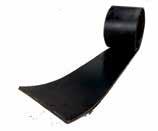
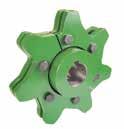










Improving the Safety & Efficiency of Your Plant www.go4b.com 4B DESIGNS AND MANUFACTURES COMPONENTS FOR BUCKET ELEVATORS AND CONVEYORS ELEVATOR BUCKETS ELEVATOR BOLTS BELTING & SPLICES PREVENTATIVE MAINTENANCE & HAZARD MONITORING SYSTEMS CONVEYOR CHAIN BEARING TEMPERATURE SENSORS SPEED SWITCHES BELT MISALIGNMENT SENSORS Engineering Solutions Since 1888 A Worldwide Manufacturer LEVEL & PLUG SWITCHES





Harvest Area and Yield - Forecast for MY 2024/25
The forecast harvest area for MY 2024/25 is 60,000 hectares, consistent with the MY 2023/24 estimate. The 4.5 percent lower forecast production is due to an expected lower yield, aligning with the past 10-year average, compared to the above-average yield estimate for MY 2023/24. The seasonal conditions at the start of MY 2023/24 were challenging, with cooler-than-usual temperatures impacting planting and early crop development. Despite this, favorable conditions later in the season allowed the crop to recover well.
Consumption - Forecast for MY 2024/25
Domestic rice consumption for MY 2024/25 is forecast at 410,000 MT, a slight increase from the estimated 400,000 MT for MY 2023/24. This increase is supported by continued strong migration, a primary driver of population growth. The Australian Bureau of Statistics reported a 2.5 percent annual population growth to September 30, 2023. Assuming constant per capita rice consumption, this population growth supports an increase in overall rice consumption.
Imports, Exports and Stocks
FAS/Canberra forecasts rice imports at 220,000 MT for MY 2024/25, a 2.3 percent decline from the MY 2023/24 estimate of 225,000 MT. This decline is attributed to the expected strong domestic rice production, which will reduce the demand for imports. Thailand and India are the two largest suppliers of rice to Australia, consistently accounting for almost two-thirds of total imports. Other significant suppliers include Vietnam, Pakistan, and Cambodia.

FAS/Canberra forecasts rice exports at 250,000 MT for MY
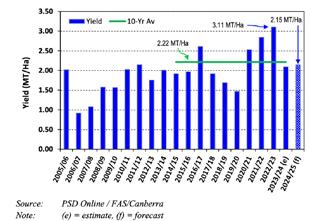

Feeding the world is a daily commitment in which technical and practical knowledge must be precise, synchronized, and balanced. It’s a microbiome that requires the right nutrients, information, advise, and high performing solution that are simple for you and your animals.
At Jefo, it’s more than a gut feeling; it’s science, it’s partnership.
We know you . You aim for the You follow the
jefo.com Milling and Grain - June 2024 | 81 Commodities
Commodities - June 2024
2024/25, a decrease of 10,000 MT (3.8 percent) from the MY 2023/24 estimate. This decrease corresponds to the forecast 4.5 percent decline in rice production. Historically, changes in rice exports have closely tracked production shifts. The forecasted high production in MY 2023/24 will likely support larger export volumes into MY 2024/25, allowing Australia to maintain its net exporter status.
Rice stocks are expected to remain relatively stable in MY 2024/25 due to strong forecast production. Overall stocks are not anticipated to vary significantly from the previous two years, which saw a recovery from the drought-induced lows.
WHEAT
Production
FAS/Canberra forecasts wheat production to remain relatively flat at 25.8 MMT in MY 2024/25, three percent below the previous 10-year average of 26.6 MMT. FAS/Canberra forecasts a 400,000-hectare decline in wheat planted area for MY 2024/25 and yield to be three percent below the 10-year average. This is due to vastly different conditions at the start of the planting period between Australia’s eastern and western production regions.
The eastern states of New South Wales, Victoria, and Queensland have generally received average to above-average rainfalls from the start of 2024, which has led to very good root zone soil moisture at the start of planting. Additionally, they received exceptionally good rains early in the planting period. Western Australia and South Australia have entered the start of the planting period with below-average root zone soil moisture and have yet to receive fall rains to get the winter planting going in earnest. This will influence decision-making regrading increased fallow area and changing the balance of the winter cropping program. The extent of the change will depend upon how much and when fall rains arrive.
Wheat in Australia is typically planted from April to June and harvested from October to December. The more northern production areas generally have earlier planting and harvest compared to the more temperate climate in the southern areas. For Western Australia and South Australia, being further north of the most southern producing areas, most of the planting is usually completed by the end of May.
Consumption
The FAS/Canberra forecast for Australian wheat consumption in MY 2023/24 is 8.0 MMT, marginally above the MY 2023/24 estimate of 7.75 MMT, but in line with MY 2022/23. The forecast 250,000 MT increase in livestock feed consumption is due to an estimated reduction in sorghum consumption for livestock in the forecast year. Wheat utilized for milling is relatively stable from year to year. The majority of the wheat demand by the livestock industry is for beef cattle feedlots and, to a lesser degree the dairy industry, as well as the swine and poultry industries. Weather conditions for pasture production, in areas where most of the livestock industries are located, have generally been very favourable over recent years which has continued into the current autumn period. With good conditions over recent years, pasture production and fodder reserves are good, which will carry well into the forecast year.
It’s important to note that significant changes in livestock feed demand occur during drought conditions. However, with the BOM rainfall forecast for the coming months being around average, at this point, there is no trigger for any change in feed demand. Despite expanding feedlot capacity in Australia, the number of cattle on feed has been relatively stable, and the feedlot numbers are not expected to change significantly in the forecast year. With


this, the overall feed demand for livestock is forecast to remain stable for MY 2024/25.
Domestic consumption of wheat for milling is expected to remain unchanged from recent years.
However, Australia’s current rapid population growth may impact milled flour demand and drive investment in milling capacity for future growth.
Exports
FAS/Canberra’s forecast for wheat exports for MY 2024/25 is 17.5 MMT, a 2.5-MMT decline from the MY 2023/24 estimate of 20 MMT. Both production and consumption are similar for the forecast and estimate years. The 12.5 percent fall in forecast exports is mainly due to higher exports for MY 2023/24 enabled via a drawdown of stocks, and further depletion of stocks is unlikely to occur for MY 2024/25. Australia has for many years had over 50 wheat export destinations, and of these, five consistently big customers have accounted for 55 to 70 percent of all exports over the last three years. The volume of wheat exports to these nations has risen and fallen with the volume available for exports, including MY 2022/23, a record export year.
Imports
FAS/Canberra’s wheat import forecast for MY 2024/25 remains low at 200,000 MT and aligned with prior year results. Imports primarily consist of wheat products and pasta, and volumes for this purpose have been relatively stable in Australia.
Stocks
Australia’s ending stocks of wheat in MY 2024/25 are anticipated to recover slightly after being depleted more than usual in MY 2023/24 due to strong world export demand. FAS/Canberra forecasts MY 2024/25 ending stocks to increase from 2.7 MMT to 3.2 MMT which is below past typical levels.

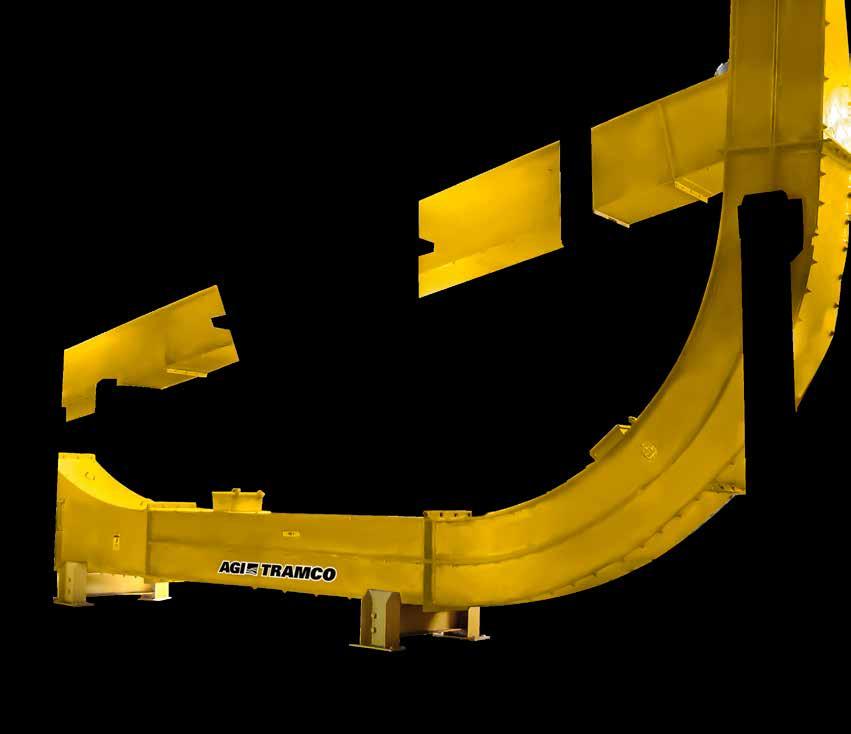
82 | June 2024 - Milling and Grain
With superior-grade European made parts, lifetime spare servicing and easy maintenance, AGI Tramco chain conveyors are designed and built to perform – 24/7/365.


EXPERIENCE LOWER TOTAL COST OF OWNERSHIP Contact us at emea@aggrowth.com aggrowth.com/emea @AgGrowthIntl @AGI EMEA MORE UPTIME. LOWER TOTAL COST OF OWNERSHIP.
INDUSTRY EVENTS
2024 June 5-6
Fenagra 2024 São Paulo, Brazil www.fenagra.com.br

11 - 12
Cereals 2024 Bygrave Woods, England www.cerealsevent.co.uk
11-12
IGC 2024 London, England www.igc.int 11-13
DLG-Feldtage Lipptstadt, Germany www.dlg-feldtage.de
19-21
Livestock Taiwan 2024 Taipei, Taiwan www.livestocktaiwan.com
2024 July 17-19

2024 August 28-30

IndoLivestock 2024 Jakarta, Indonesia https://indolivestock.com

ILDEX Philippines Manila, Philippines https://ildex-philippines.com

2024 September 11-13
9th Taiwan Smart Agriweek Taipei, Taiwan www.taiwanagriweek.com
17-19


SPACE Rennes, France https://uk.space.fr
SPACE is the must-attend event for all livestock professionals worldwide: beef (milk and meat), poultry, pork, sheep, goat, rabbit and aquaculture sectors.

The 38th SPACE will be held from Tuesday September 17 to Thursday September 19, 2024 at the Parc-Expo in Rennes, France. These 3 days will once again be an exceptional and unique opportunity for all livestock sectors to gather information, exchange views, share ideas and debate... You’ll also be able to discover all the latest innovations in the sector, thanks to the Innov’Space label.

23-25
IAOM Eurasia Conference & Expo Bakü, Azerbaijan www.iaom.org
2024 October 2-3



VIV Africa 2024 Kigali, Africa www.vivafrica.nl
16-18
FIGAP Mexico 2024 Guadalajara, Mexico https://figap.com 20-22
IAOM Southeast Asia Conference & Expo Surabaya, Indonesia www.iaom.org
Use the Promo Code ATLANTA24 Would you like a complimentary digital subscription to Milling and Grain magazine? YOUR GLOBAL PARTNER Simply visit: https://store.magstand.com/millingandgrain 84 | June 2024 - Milling and Grain















BOOK YOUR STAND BEFORE APRIL 1, 2025 AND TAKE ADVANTAGE OF THE EARLY BIRD SALES DISCOUNT . CONNECTING ALL AMERICAN CONTINENTS BRAZIL São Paulo JOIN US in 2025 FEED INGREDIENTS LATIN AMERICA 2025 FEED INGREDIENTS LATIN AMERICA 2025 SEPTEMBER 16-18, 2025 EXPO CENTER NORTE, WHITE PAVILION, SÃO PAULO, BRAZIL victamlatam.com 190 x 132 Perendale.indd 1 16-05-2024 14:54 Organized by MOST COMPLETE TRADE SHOW FOR LIVESTOCK PROFESSIONALS IN SUB SAHARAN AFRICA VIV AFRICA 2024 KIGALI, RWANDA 2-3 OCTOBER WWW.VIVAFRICA.NL
PAVILION
FEATURING Milling and Grain - June 2024 | 85
DAIRY PAVILION


















Ms.Haidee Wang
Tel: +86 138 1775 2961
E-mail: haidee.wang@globusevents.com
Mr.Philippe Verstuyft (based in Europe)
Tel: +31 6 1517 3564
E-mail: philippe@vnueurope.com
Ms.Chanitprapa Menasuta (based in Thailand)
Tel: +66 (0) 8 1801 7464
E-mail: chanitprapa@vnuasiapacific.com
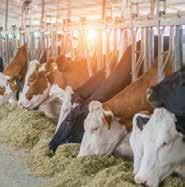



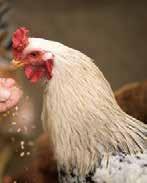
OFFICIAL WEBSITE AN EVENT OF MY EXHIBITION CO., Ltd. 9th TAIWAN SMART AGRIWEEK 11-13 SEPTEMBER 2024 | TaiNEX 1 - TAIPEI - TAIWAN Discover the Future of Agriculture: Unveiling Innovations at Asia-leading Industry Expo International Trade Show from Feed to Food NANJING, CHINA 5- 7 Septermber Hot Sale, Welcome to Join us ! For Booth Equiry www.VIVchina.nl Hatching & Breeding Slaughtering & Processing Feed & Equipment Waste Treatment Animal Health Smart Farming
50,000m2 Exhibition Area 500+ Exhibitors 30000+ Visitors
BUILD MY FEEDMILL CONFERENCE 2024
by Shannon Parsons and Niamh Cassidy, Milling and Grain, UK
The latest technology of a feedmill, broken down into each piece of equipment used to create the nutritious feed we give our livestock, pets, aquatic animals, discussed during the twohour conference of Build My Feedmill (BMFM) at Health and Nutrition Asia 2024. Held on March 13, 2024 at BITEC, Thailand, Bangkok, Perendale Publishers gathered some of the top people in the feed industry to share their knowledge on their most recent technically-advanced innovations regarding machinery and it was an incredibly informative conference.
Starting off the conference is a warm welcome for the Perendale Publisher’s CEO and Publisher, Roger Gilbert, who explains the process of BMFM. It is a two-hour conference structured on the flow chart of a feedmill where each speaker has ten minutes to discuss their topic/machine that correlates with a part of the flow chart.
Presenting first on the topic of dosing and weighing was Sebastiaan Van Dijk from KSE with his presentation ‘Fast dosing, precise weighing & increased production capacity’. Sebastiaan dove into the recent and innovative solutions that are transforming dosing and weighing in the milling process, giving valuable insights into achieving exceptional accuracy, optimizing ingredient tracking, eliminating industry challenges like product damage, and boosting productivity.
After we had grinding which was covered by Olaf Naehrig from Amandus Khal discussing ‘The role of the roller mill in the feedmill’. Olaf gave an in-depth introduction to KAHL’s roller mills, their applications, and benefits.
Continuing onto micro-dosing was Marco Prati from PLP Systems with his presentation ‘Handling minor ingredients and


additives used for feed production’. Marco covered how additives can be dosed, the role of the Premix Plant, and a way of handling micro ingredients in the mill.
Circling back to a previous speaker, Olaf Naehrig presented ‘Expander technology in the feedmill’ in relation to expander conditioning. He explained how KAHL’s expander plays a key role in the production of high-quality feed.
Jonathan Zheng from ZhengChang then covered high meat addition with his presentation ‘High meat addition in pet food processing’. Jonathan brought attention to potential problems in high meat production, such as moisture content in raw meat materials, and how Zhengchang Research & Development and testing overcame this issue, producing great results in high meat addition.
Bringing the conference to the half-way mark is Neal Cass from Hydronix discussing automation, ‘The importance of moisture control and measurement throughout the feed milling process’. Neal answered questions regarding why you need to measure
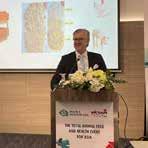


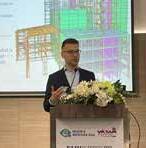
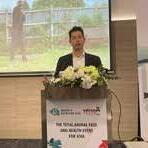
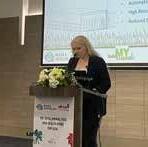
INDUSTRY EVENTS
INDUSTRY EVENTS 88 | June 2024 - Milling and Grain





















































YOUR PARTNER FOR BAGGING & PALLETIZING BAGGING CAROUSEL FOR OPEN-MOUTH BAGS HIGH-LEVEL PALLETIZER operating of various bag types possible available for various production requirements
maintenance-friendly Milling and Grain - June 2024 | 89
www.statec-binder.com



moisture, where, and how you control, as well as methods and benefits to moisture control.
Kicking off the second hour was Roger Ubags from Van Aarsen on heat treatment and pelleting, informing everyone on ‘Safe feed forms, the basis for safe food’. Roger briefed the audience on Van Aarsen’s innovations, and how they successfully work at improving the pelleting process.
After Ubags was Claus Braunbeck from FrigorTec on cooling with ‘Grain management for reliable feed milling’. Claus discussed the importance of maintain quality and quantity of stored commodities with grain cooling as a total solution.
BMFM then had two separate presentations on bulk handling, the first being from Justin van den Heuvel from Muller Beltex with his presentation ‘Improve your bucket elevators in view of the total cost of ownership’. This was followed by Nicoleta Axenti from Metalmont with her presentation ‘Automated and safe bunker storage of raw products and pellets’.
To continue with bulk territory, Sven Konings from TSC Silos

touches on storage and bulk outloading with his presentation ‘From process design to a building design: How structural thinking saves time, space and errors’. Sven talked about the importance of integrating constructive thinking early in the design process, and how it can yield significant benefits such as saving time and space, reducing errors, and enhancing efficiency.
To end the day was a fascinating joint presentation from Andritz by Marco Bauman and Dr Sohail Nazari covering future feed milling. They discussed Andritz’s innovative technology, and how to ‘Build your plant with operational readiness using digital twin technology’.
The conference was ended with a group Q&A and discussion, allowing the audience an opportunity to question and collectively discuss and debate the topics that were brought forward during the previous two hours. An educational and thought-provoking moment this was that encouraged everyone in the room to participate.

COMPLETE PLANT SOLUTIONS

UNDERSTANDING YOU. STANDING BY YOU. NEVER STANDING STILL. We provide complete plant solutions for the animal feed industry to your exact specifications and with industry-leading cost efficiency by leveraging our extensive processing expertise and experience.
By harnessing the power of automation and digitalization, we ensure continuous innovation to keep you at the forefront. AND with the industry’s most trusted services, we are always there for you.
ANDRITZ FEED & BIOFUEL andritz.com/feed-and-biofuel-en
For more information, visit our website.
FROM START TO FINISH, WE ENSURE YOUR PROJECTS DEVELOP SEAMLESSLY
Milling and Grain - June 2024 | 91

Worldwide grain processing industry met at IDMA IDMA Istanbul
by Mehmet Uğur Gürkaynak, Milling and Grain, Türkiye


The 10th IDMA Istanbul Fair, held at the Istanbul Expo Centre between 2-4 May 2024, brought together the important representatives of the world grain processing industry.
The domestic flour, grain, feed, pulses production equipment and milling machinery sector, which exports 90 percent of its production, met in Istanbul with more than 10,000 professionals visiting from 120 countries.
This exhibition is the first and only grain processing industry exhibition in Türkiye and the world’s largest grain processing industry exhibition and continues to support the exports of sector producers.
A global meeting point
IDMA Exhibition stands out as one of the biggest global events in the sector.
The fair, which has also been organised in Russia and Indonesia, was held in Istanbul again this year.
Ahmet Güldal, General Manager of Turkish Grain Board (TMO), Haluk Tezcan, President of Turkish Flour Industrialists Federation (TUSAF), Ülkü Karakuş, President of Turkish Feed Industrialists Association (TÜRKİYEM-BİR), Zeki Demirtaşoğlu, President of Association of Milling and Sector Machinery Manufacturers (DESMÜD), Aykut Göymen, President of Turkish Pasta Industrialists Association (TMSD), Prof Dr Mustafa Bayram, President of Association of Grain and Pulses Processing Technologies, Storage and Analysis Systems (TABADER) and Muhammet Ali Kalkan, Chairman of the Board of Directors of HAGE Group, the organiser of IDMA Fairs made speeches.
Ndong Kehl, Ahmet Eskiyapan, Cedric Anil Muller, Sefar, Switzerland
92 | June 2024 - Milling and Grain
Abdullah Çolak, Yemtar of Türkiye. Yemtar has undertaken many projects since it was founded in Bandırma in 1980

120.000 TONS



G R O U P ELECTRIC MOTORS & GENERATORS
International participation and training
Sectoral associations and unions from countries such as Egypt, Morocco, Russia, Ukraine, Bolivia, Indonesia and Serbia also participated in the fair. Various training and seminars, such as the 5th International TABADER Summit, certified milling awards and the BBM Kitchen were held during the event. These events offered important opportunities to share innovations and best practice.
Opening Ceremony
Ahmet Güldal, General Manager of the Turkish Grain Board, referred to Türkiye’s achievements in the agricultural sector at the opening ceremony.
Stating that Türkiye is the world leader in flour exports, the second in pasta exports and the first in feed exports, Mr Güldal emphasised that these sectors make significant contributions to the national economy.
“This fair provides an important platform by bringing together the representatives of the grain, feed and pulses sector,” he said.
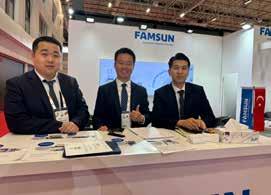


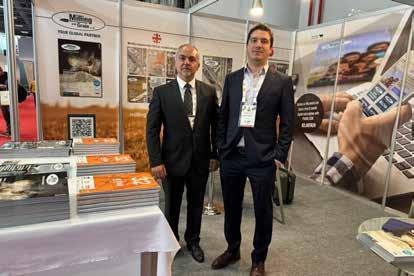
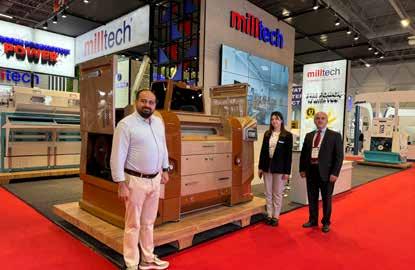
 Andy Wang, Michael Hao, Gordon Guo of Famsun, China
The Alapala team. Alapala Machine, of Türkiye, builds turnkey plants of any desired capacity and is one of the top 1000 exporters in Turkey, exporting 95 percent of its production. It has a considerable number of turnkey references in over 100 countries including developed countries such as Germany, France and the USA
Lee Deon, Agah Yegin, Ali Goktas, Muhammet Bozkurt, Zekai Kivrim, Gokcen Goktas, Mesut Yegin, Sani Kandemir, Sefa Yegin from Yenar of Türkiye. Yenar has been operating in the sector for more than 25 years, with its state-of-the-art modern production facilities built on a total area of 40,000 square metres
Emre Ereren of Imas, Türkiye
The Milltec team. Milltec manufacture and supplies a complete range of rice milling machines including cleaning, husking, whitening, polishing, grading, sorting and packaging machines to meet rice processing requirements
Andy Wang, Michael Hao, Gordon Guo of Famsun, China
The Alapala team. Alapala Machine, of Türkiye, builds turnkey plants of any desired capacity and is one of the top 1000 exporters in Turkey, exporting 95 percent of its production. It has a considerable number of turnkey references in over 100 countries including developed countries such as Germany, France and the USA
Lee Deon, Agah Yegin, Ali Goktas, Muhammet Bozkurt, Zekai Kivrim, Gokcen Goktas, Mesut Yegin, Sani Kandemir, Sefa Yegin from Yenar of Türkiye. Yenar has been operating in the sector for more than 25 years, with its state-of-the-art modern production facilities built on a total area of 40,000 square metres
Emre Ereren of Imas, Türkiye
The Milltec team. Milltec manufacture and supplies a complete range of rice milling machines including cleaning, husking, whitening, polishing, grading, sorting and packaging machines to meet rice processing requirements
Milling and Grain - June 2024 | 95
Mehmet Alapala o Alapros of Türkiye with Tuti Tan



- Steel Silos & Grain Handling Equipments.
- Grain Temperature Monitoring System
- Pellet Mill, Dies & Roller Shells
- Magnets & Magnetic Systems & Separators
- Recycling & Enviromental Technologies & Sorting Equipments

aker REPRESENTATION FOR: Azerbaijan Georgia Kazakhstan Turkey Turkmenistan Uzbekistan Crepe-tape Pull-off Device 29950F BAG CLOSING SYSTEMS & BAG MAKING SEAMING-CONVERSION MACHINES NEW 8C200 SERIES 56100 BAG SEAMING www.unionspecialturkey.com unionspecialbags@bakermagnetics.com.tr NEW 80800 SERIES 2200 HEAVY DUTY PORTABLE Protection Against Rust GENUINE SPARE PARTS & NEEDLES WORLDWIDE EXPRESS DELIVERY TURKEY Tiirkiye Temsilcisi & Distributor BM Baker Magnetik Willy Brandt Sok. No: 16/1 Cinnah 06690 Cankaya-Ankara, Turkey Tel: +90 312 441 68 01 - 441 6883 Fax: +90 312 441 61 65 www.bakermagnetics.com www.bakermagnetics.com.tr BM Online Supply Chain Platform: www.bmbaker.eu TURN-KEY PROJECTS The Member of Baker GROUP since 1964 REDlJ.)RVE � STATEC BINDER Our Representatives and Services
Sewing Heads
System.
- Union Special Industry
& Equipment, Bagging and Packaging
- 4B Electronic Components & Monitoring Systems Elevator & Conveyor Components and Electronic Safety Components & Elevator Buckets. - Grain Dryers & Cleaners, Grain Storage



Developments and exports
Muhammet Ali Kalkan, Chairman of the Board of Directors of the HAGE Group, which is an organiser of IDMA Fairs, stated that IDMA is the meeting point of the domestic grain processing industry with the world.
“IDMA fairs make a great contribution to the development of the sector, meeting new markets and exports. We hosted our sector at IDMA Istanbul, which we organised for the 10th time this year.
“We brought together many important institutions, opinion leaders and approximately 10,000 professional visitors from Türkiye and the world. We exhibited innovations in the sector with 300 participating brands. The expected trade volume from the fair is around US$500 million,” he added.



 The Çukurova Silo team. Çukurova Silo specialises in the production of silos and equipment in its facilities equipped with the most advanced technology. This Turkish company has established turnkey grain storage facilities in more than 90 countries
Sedat Demirbas, Ridha Kaaniche of Altinbilek of Türkiye
The Tanis team. Tanis has been leading organisations in Türkiye of the agriculture-based industry since 1956. It produces flour, semolina, corn flour, bulgur and lentil processing equipment. Its factory is established on an area of 25.000 square metres in Gaziantep, using the most advanced technologies in capacities, building and construction required on a turnkey basis
The Çukurova Silo team. Çukurova Silo specialises in the production of silos and equipment in its facilities equipped with the most advanced technology. This Turkish company has established turnkey grain storage facilities in more than 90 countries
Sedat Demirbas, Ridha Kaaniche of Altinbilek of Türkiye
The Tanis team. Tanis has been leading organisations in Türkiye of the agriculture-based industry since 1956. It produces flour, semolina, corn flour, bulgur and lentil processing equipment. Its factory is established on an area of 25.000 square metres in Gaziantep, using the most advanced technologies in capacities, building and construction required on a turnkey basis
BOURNE AES R C H & RECRUITMENT SELE C T I NO �
���� bournerecruitment.co.uk ���� +44 7764 465 897 THE EXPERT IN FEED, FLOUR MILLING AND FOOD PRODUCTION RECRUITMENT
RECRUITING GLOBALLY Milling and Grain - June 2024 | 97
Cengizhan Yeniçelik of BM Baker Magnetics of Türkiye
CHIEF COMMERCIAL OFFICER � GENERAL MANAGERS � MANAGING DIRECTORS � CHIEF MILLERS � FEED & POULTRY MANAGERS � MAINTENANCE MANAGERS � R&D NEWPRODUCT DEVELOPMENT � SALES & MARKETING � PLANT MANAGERS � CFO’S
POSITIONS RECRUITED:

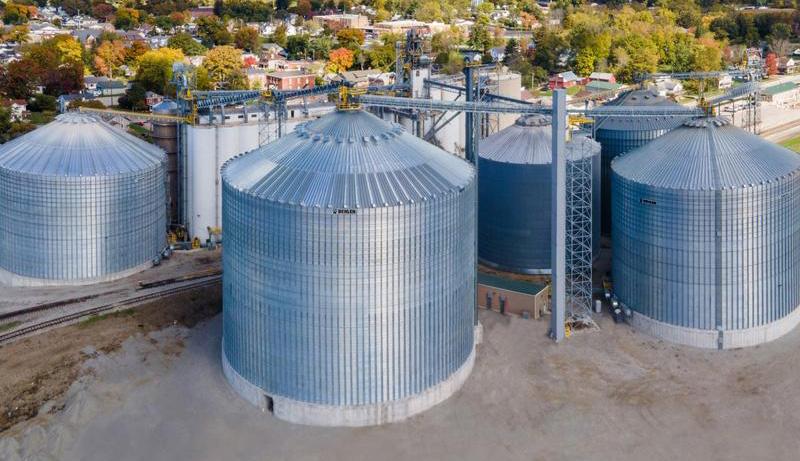




Behlen bins range in size from 85 to 66,000 cubic meters. These silos feature a unique trapezoidal wall panel design. COMMERCIAL GRAIN BINS Behlen hoppers are designed to ensure strength, ease of assembly, and trouble-free operation. COMMERCIAL HOPPER TANKS Behlen Steel BUILT TO LAST Behlen Grain Systems... Standing the test of time with competitive prices and Customer Service second to none. CONTACT US TODAY TO DISCUSS YOUR PROJECT! Call 1-402-564-3111 or Visit www.behlengrainsystems.com Bigger and Better than Ever!


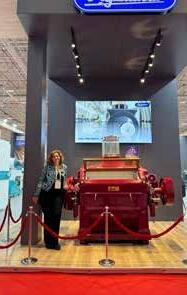



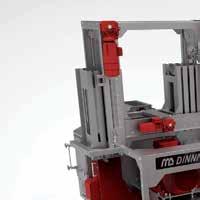
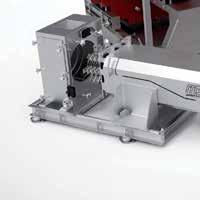
Future of IDMA and Innovations
IDMA Istanbul draws attention as a platform exhibiting the latest technologies and innovations in the milling sector.
The companies participating in the exhibition introduced their latest products and technologies. At the same time, seminars given by academics and industry experts contributed to the development of solutions and strategies for the industry.
Preparations have already started for the second IDMA Russia exhibition to be held in Moscow in April 2025.
The 10th IDMA Istanbul continues to be an important platform for sharing innovations and developments in milling, establishing collaborations and increasing trade.
Such events, shape the future of the industry and will continue to play an indispensable role for professionals who wish to share their knowledge and experience and create new business opportunities.






 Zeki Demirtaşoğlu, Bastak of Türkiye
Bora Mehmet Sağbili, General Manager, Sagbil Packaging Machines
Bahadir Arcan, Sales Coordinator, My Silo with Mehmet Uğur Gürkaynak, Milling and Grain
Ismail Kunduraci of Selis, Türkiye
Filiz Aybakar, Aybakar of Türkiye
Zeki Demirtaşoğlu, Bastak of Türkiye
Bora Mehmet Sağbili, General Manager, Sagbil Packaging Machines
Bahadir Arcan, Sales Coordinator, My Silo with Mehmet Uğur Gürkaynak, Milling and Grain
Ismail Kunduraci of Selis, Türkiye
Filiz Aybakar, Aybakar of Türkiye
Milling and Grain - June 2024 | 99 F
Samet Taşkın of Ortas

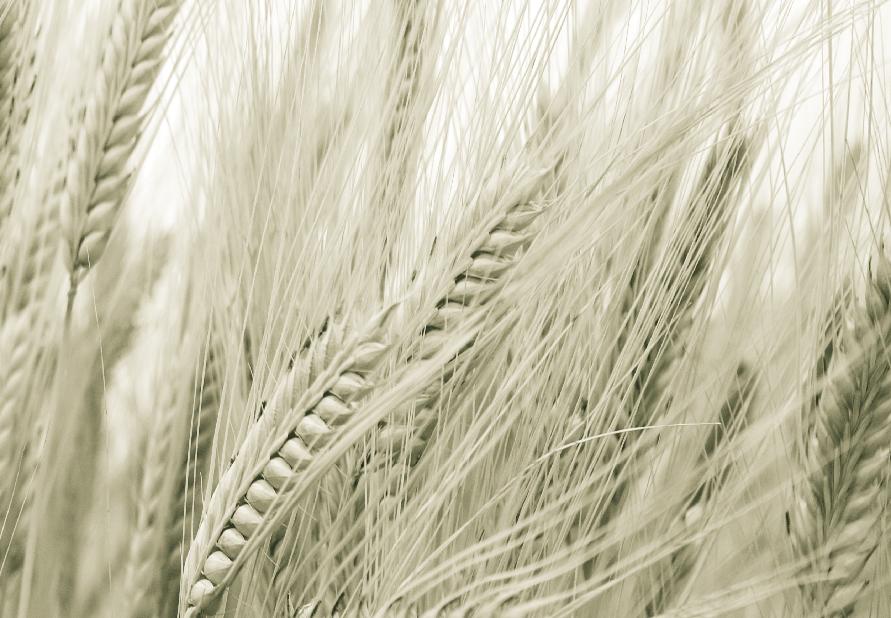

INDUSTRY EVENTS MORE INFORMATION nickmouthaan@victam.com +31 6 2126 4398 victaminternational.com PRE BOOKING RATE : until 31 May 2025 * EARLY BIRD RATE : until 30 September 2025 * SEE YOU IN 2026 * Sales starts in March 2024 and as the event takes place in different halls, the stand allocation is done on a first come first serve basis JUNE 2-4, 2026 JAARBEURS, UTRECHT, THE NETHERLANDS JOIN OUR 60TH ANNIVERSARY 11 - 12 JUNE 2024 IGC GRAINS CONFERENCE 2024 Milling and Grain - June 2024 | 101


Amino acids

Evonik Operations GmbH
+49 6181 59 12437
www.evonik.com/animal-nutrition
PROFILE: mymag.info/GJqQ
Bagging systems


Behn + Bates
+49 251 9796 252
www.behnbates.com
PROFILE: mymag.info/PaXw
BM Baker Magnetics
+90 312 4416801
www.bakermagnetics.com
PROFILE: mymag.info/PRBMBAKER
BM Baker Magnetics founded in 1964, is one of the world’s largest distributors of sewing machines. Since its founding, Baker Group has expanded from a limited line of sewing machines and spare parts to one of the most comprehensive lines of sewing machine parts, cutting machine parts and related supplies. We work closely with our factories to create and supply products to meet the demands of industry.
Using spare part as the core of our business, we draw upon our national and worldwide resources to manufacture, procure and contract the production of quality replacement parts and supplies for all types of equipment used in sewing maschines trades.


Bühler AG
+41 71 955 11 11
www.buhlergroup.com
PROFILE: mymag.info/dZxH
FAWEMA
+49 2263 716-0 www.fawema.com
PROFILE: mymag.info/bdRz
Statec Binder
+43 3112 38 5800 www.statec-binder.com
PROFILE: mymag.info/Tbyt

Golden Grain Group
+86 371 68631308 www.g-grain.com
PROFILE: mymag.info/eCyP
Bakery improvers
Bastak

+90 312 395 67 87
www.bastak.com.tr
PROFILE: mymag.info/VDLI
ERKAYA

Bulk storage
+90 312 395 2986
www.erkayagida.com.tr
PROFILE: mymag.info/Ojcm

AGI
www.aggrowth.com
PROFILE: mymag.info/clVX
Behlen +1 402 564 3111
www.behlengrainsystems.com
PROFILE: mymag.info/hncS


Brock +1 866 658 4191
www.brockgrain.com
PROFILE: mymag.info/GGYu
Bühler AG +41 71 955 11 11
www.buhlergroup.com
PROFILE: mymag.info/dZxH
CESCO
+49 7531 122860 https://cesco-group.com
PROFILE: mymag.info/VkQk




Silo Construction & Engineering +32 51723128
www.sce.be
PROFILE: mymag.info/UOay
Symaga +34 926640475
www.symaga.com
PROFILE: mymag.info/vxbf
The Essmueller +1 800 325 7175
www.essmueller.com
PROFILE: mymag.info/MdZl
TSC Silos +31 543 473979
www.tsc-silos.com
PROFILE: mymag.info/HTSY

Van Aarsen International +31 475 579 444
www.aarsen.com
PROFILE: mymag.info/JUgk
Cereal and pulse conditioning



Bühler AG +41 71 955 11 11
www.buhlergroup.com
PROFILE: mymag.info/dZxH
Friedrich Electronic +49 6406 923350
www.friedrich-electronic.de
PROFILE: mymag.info/gbBd
Omas +39 049 9330 297 https://omasindustries.com
PROFILE: mymag.info/promas
Vibrafloor +33 3 85 44 06 78
www.vibrafloor.com
PROFILE: mymag.info/cgrU

vibronet-Gräf GmbH & Co.KG +49 6441 62031 www.vibronet.com
PROFILE: mymag.info/icHn
Colour sorters



Bühler A G +41 71 955 11 11 www.buhlergroup.com
PROFILE: mymag.info/dZxH
Cimbria Srl +39 0542 361423 www.cimbria.com
PROFILE: mymag.info/XYRL


Satake
82 420 8560
Business Services Bourne Recruitment +44 161 262 1069 www.bournerecruitment.co.uk profile: mymag.info/SWzY Computer software BM Baker Magnetics +90 312 4416801 www.bakermagnetics.com PROFILE: mymag.info/PRBMBAKER MAG TV MAG TV is Milling and Grain magazine’s video channel. Featuring content about new products, interviews with industry professionals, industry event content and much more QR codes We use QR codes to take you directly to more information on the web myMAG links myMAG links are shortened hyperlinks that will take you directly to content when typed into a browser mymag.info/e/37 What
magazine
sister titles,
Miller. It aims to connect the print and the digital world, bringing more content that will be of interest, as well as direct links to the content that you want to see. millingandgrain.com/the-market-place 102 | June 2024 - Milling and Grain
+81
www.satake-group.com PROFILE: mymag.info/Lwtk
is The Market Place The Market Place is a collaboration between Milling and Grain
and our
The International Milling Directory and The Global



iGrain
+45 31633900
https://crop-protector.com
PROFILE: mymag.info/FxFP
Inteqnion
+31 543 49 44 66
www.inteqnion.com
PROFILE: mymag.info/ZyIm
KSE
+31 497 383818
www.ksegroup.com
PROFILE: https://mymag.info/fhSV
In 1973, Adriaan Smulders founded Kempen Service Elektrotechniek, originally a small company that focused on electrical installations in the agriculture branch. A few years later, KSE landed its first major customer in the Dutch feed industry: Coppens Diervoeding (nowadays De Heus), hereby setting its first steps toward becoming market leader in the Benelux for industrial automation in the animal nutrition industry. Our PROMAS Automation Software was first developed in 1988 and in 1997 ALFRA Doseer- en Weegsystemen (est. 1933) was acquired by and therefore becoming a brand of KSE. In the late 90’s Adriaan’s sons Erik and René joined the family business.
Over the years, KSE has specialized in dosing and weighing systems and smart automation software for the animal feed industry. We are clearly focused on continuous innovation, which is passed from generation to generation. The animal feed industry is our focus market. Personal contact, excellent service and a passion for the powder and granulate processing industry are key. This has helped us grow from a small company to an international business with activities worldwide. In 2023, KSE celebrates its 50th anniversary.

Van Aarsen International
+31 475 579 444 www.aarsen.com
PROFILE: mymag.info/JUgk
Conveyor Chains
CESCO
+49 7531 122860
https://cesco-group.com
PROFILE: mymag.info/VkQk

VAV Conveyor Components & Solutions
+31 7140 23701 www.vav-nl.com
PROFILE: mymag.info/aPKR
Coolers & driers



Bühler AG +41 71 955 11 11 www.buhlergroup.com
PROFILE: mymag.info/dZxH
Consergra s.l +34 938 772207 www.consergra.com
PROFILE: mymag.info/GPtm
FrigorTec GmbH
+49 7520 91482-0
www.frigortec.com
PROFILE: mymag.info/fRiz
FAMSUN

+86 85828888 www.famsungroup.com
PROFILE: mymag.info/opGO

iGrain
+45 31633900
https://crop-protector.com
PROFILE: mymag.info/FxFP


Van Aarsen International
+31 475 579 444
www.aarsen.com
PROFILE: mymag.info/JUgk
Yemmak
+90 266 7338363
www.yemmak.com
PROFILE: mymag.info/QBbm

Dosing



Yemtar Feed Mill Machines +90 266 733 8550
www.yemtar.com
PROFILE: mymag.info/aPXh
Bühler AG +41 71 955 11 11
www.buhlergroup.com
PROFILE: mymag.info/dZxH
Friedrich Electronic
+49 6406 923350
www.friedrich-electronic.de
PROFILE: mymag.info/gbBd
KSE
+31 497 383818
www.ksegroup.com
PROFILE: https://mymag.info/fhSV
PLP
+39 05 23 89 16 29
www.plp-systems.com
PROFILE: mymag.info/PGWg
Tietjen Verfahrenstechnik GmbH


+49 4106 6333 0
www.tietjen-original.com
PROFILE: mymag.info/uyGD
Van Aarsen International
+31 475 579 444
www.aarsen.com
PROFILE: mymag.info/JUgk
Elevator buckets

4B Braime
+44 113 246 1800
www.go4b.com
PROFILE: mymag.info/HiwC
CESCO +49 7531 122860
https://cesco-group.com
PROFILE: mymag.info/VkQk
Tapco Inc

+1 314 739 9191
www.tapcoinc.com
PROFILE: mymag.info/ogOz

VAV Conveyor Components & Solutions
+31 7140 23701
www.vav-nl.com
PROFILE: mymag.info/aPKR
Yemtar Feed Mill Machines

+90 266 733 8550
www.yemtar.com
PROFILE: mymag.info/aPXh
Elevator & conveyor components

Wenger Manufacturing
+1 785-284-2133 www.wenger.com
PROFILE: mymag.info/QiGw


Bühler AG +41 71 955 11 11
www.buhlergroup.com
PROFILE: mymag.info/dZxH
CESCO +49 7531 122860
https://cesco-group.com
PROFILE: mymag.info/VkQk





Enzymes


Henry Simon +44 161 804 2800
www.henrysimonmilling.com
PROFILE: mymag.info/tYpO
Tapco Inc +1 314 739 9191
www.tapcoinc.com
PROFILE: mymag.info/ogOz
Yemtar Feed Mill Machines +90 266 733 8550
www.yemtar.com
PROFILE: mymag.info/aPXh
Van Aarsen International +31 475 579 444 www.aarsen.com
PROFILE: mymag.info/JUgk
VAV Conveyor Components & Solutions +31 7140 23701
www.vav-nl.com
PROFILE: mymag.info/aPKR
Bastak +90 312 395 67 87
www.bastak.com.tr
PROFILE: mymag.info/qHkV
ERKAYA +90 312 395 2986 www.erkayagida.com.tr
PROFILE: mymag.info/Ojcm
PLP +39 05 23 89 16 29
www.plp-systems.com
PROFILE: mymag.info/PGWg
Extruders



Almex +31 575 572666 www.almex.nl
PROFILE: mymag.info/IMiV
Bühler AG +41 71 955 11 11
www.buhlergroup.com
PROFILE: mymag.info/dZxH
Wenger Manufacturing +1 785-284-2133 www.wenger.com
PROFILE: mymag.info/QiGw
Yemmak +90 266 7338363 www.yemmak.com
PROFILE: mymag.info/QBbm

Feed nutrition
Yemtar Feed Mill Machines +90 266 733 8550 www.yemtar.com
PROFILE: mymag.info/aPXh
4B Braime
+44 113 246 1800 www.go4b.com
PROFILE: mymag.info/HiwC
BM Baker Magnetics
+90 312 4416801
www.bakermagnetics.com
PROFILE: mymag.info/PRBMBAKER

Anpario +44 1909 537 380 www.anpario.com
PROFILE: mymag.info/wAMV
dsm-firmenich +44 1452 306129
www.dsm.com/anh
PROFILE: mymag.info/ksCT
Milling and Grain - June 2024 | 103

Feed milling
Evonik Operations GmbH +49 6181 59 12437 www.evonik.com/animal-nutrition
PROFILE: mymag.info/GJqQ



ALAPALA Feed Tech
+90 212 465 60 40 https://alapala.com /en/feed-mill-machinery
PROFILE: mymag.info/CbJl
Bühler AG +41 71 955 11 11 www.buhlergroup.com
PROFILE: mymag.info/dZxH milltech
+90 332 5021300 www.milltech.com.tr
PROFILE: mymag.info/hfOy
Dinnissen BV
+31 77 467 3555 www.dinnissen.nl
PROFILE: mymag.info/pUDK

FAMSUN +86 85828888 www.famsungroup.com
PROFILE: mymag.info/opGO
Ottevanger Milling Engineers

+31 79 593 22 21 www.ottevanger.com
PROFILE: mymag.info/mlzK
PLP
+39 05 23 89 16 29 www.plp-systems.com
PROFILE: mymag.info/PGWg
Tietjen Verfahrenstechnik GmbH



+49 4106 6333 0 www.tietjen-original.com
PROFILE: mymag.info/uyGD
Van Aarsen International
+31 475 579 444 www.aarsen.com
PROFILE: mymag.info/JUgk
VAV Conveyor Components & Solutions
+31 7140 23701 www.vav-nl.com
PROFILE: mymag.info/aPKR

vibronet-Gräf GmbH & Co.KG +49 6441 62031 www.vibronet.com
PROFILE: mymag.info/icHn
Yemmak
+90 266 7338363 www.yemmak.com
PROFILE: mymag.info/QBbm


Zheng Chang
+86 2164184200 www.zhengchang.com
PROFILE: mymag.info/wecN
Golden Grain Group
+86 371 68631308 www.g-grain.com
PROFILE: mymag.info/eCyP
Feed Mill Automation

ALAPALA Feed Tech
+90 212 465 60 40
https://alapala.com/en/ feed-mill-machinery
PROFILE: mymag.info/qmHZ

KSE
+31 497 383818
www.ksegroup.com
PROFILE: https://mymag.info/fhSV
PLP
+39 05 23 89 16 29
www.plp-systems.com
PROFILE: mymag.info/PGWg
Van Aarsen International

+31 475 579 444
www.aarsen.com
PROFILE: mymag.info/JUgk
Founded in 1949, we are a developer, manufacturer, and supplier of high-quality machines, process lines, and complete solutions for feed production, worldwide. By innovating in not only technology but also in our overall communication and your experience with Van Aarsen, we aim to find the perfect fit solution for any project, challenge, or request you may have related to feed production machinery. We strive to do this by communicating with – and advising you throughout your entire journey with us as your manufacturer. But most importantly, we strive to be your long-term partner in optimizing your feed production.
At Van Aarsen International, we believe in co-creating the perfect fit for your feed milling needs. With a legacy of innovation, we collaborate closely with you to understand your unique challenges and goals. Our team combines expertise with your insights to tailor solutions that seamlessly align with your operations. From custom machinery design to efficient processes, we’re dedicated to shaping the future of feed production together. With a proven track record and satisfied customers, experience the power of co-creation with Van Aarsen International. Elevate your feed milling efficiency, quality, and sustainability – let’s co-create your success story today.
Flour Improvers
Bastak

+90 312 395 67 87 www.bastak.com.tr
PROFILE: mymag.info/VDLI
Flour milling

Henry Simon +44 161 804 2800
www.henrysimonmilling.com



PROFILE: mymag.info/tYpO milltech +90 332 5021300 www.milltech.com.tr
PROFILE: mymag.info/hfOy
Omas +39 049 9330 297 https://omasindustries.com
PROFILE: mymag.info/promas
Liaoyuan Ruiyi Grain Machinery Manufacturing Co., Ltd +86 437 3519196 www.lyruiyi.com
PROFILE: mymag.info/PRlyruiyi
Grain handling systems
Behlen +1 402 564 3111 www.behlengrainsystems.com
PROFILE: mymag.info/hncS
Brock









Hammermills



CESCO +49 7531 122860 https://cesco-group.com
PROFILE: mymag.info/VkQk
Cimbria A/S +45 96 17 90 00
www.cimbria.com
PROFILE: mymag.info/XYRL
Henry Simon +44 161 804 2800
www.henrysimonmilling.com
PROFILE: mymag.info/tYpO
iGrain +45 31633900 https://crop-protector.com
PROFILE: mymag.info/FxFP
Symaga +34 91 726 43 04 www.symaga.com
PROFILE: mymag.info/vxbf
Tapco Inc +1 314 739 9191 www.tapcoinc.com
PROFILE: mymag.info/ogOz
The Essmueller +1 800 325 7175 www.essmueller.com
PROFILE: mymag.info/MdZl
Yemtar Feed Mill Machines +90 266 733 8550 www.yemtar.com
PROFILE: mymag.info/aPXh
Golden Grain Group +86 371 68631308
www.g-grain.com
PROFILE: mymag.info/eCyP
Alapala +90 212 465 60 40 www.alapala.com
PROFILE: mymag.info/CbJl
ALAPALA Feed Tech +90 212 465 60 40 https://alapala.com/en/ feed-mill-machinery
PROFILE: mymag.info/qmHZ
Bühler AG +41 71 955 11 11 www.buhlergroup.com
PROFILE: mymag.info/dZxH
Dinnissen BV +31 77 467 3555 www.dinnissen.nl
PROFILE: mymag.info/pUDK

Ottevanger Milling Engineers +31 79 593 22 21 www.ottevanger.com
PROFILE:mymag.info/mlzK



+1 866 658 4191 www.brockgrain.com
PROFILE: mymag.info/GGYu

Selis +90 222 236 12 33 www.selis.com.tr
PROFILE: mymag.info/dfff
Tanis Machine Technologies +90 (342) 337 22 22 www.tanis.com.tr/en
PROFILE: mymag.info/VIED
Tietjen Verfahrenstechnik GmbH +49 4106 6333 0 www.tietjen-original.com
PROFILE: mymag.info/uyGD
Bühler AG
+41 71 955 11 11
www.buhlergroup.com
PROFILE: mymag.info/dZxH

Bühler AG +41 71 955 11 11
www.buhlergroup.com
PROFILE: mymag.info/dZxH

Van Aarsen International +31 475 579 444 www.aarsen.com
PROFILE: mymag.info/JUgk
104 | June 2024 - Milling and Grain


Yemmak
+90 266 7338363 www.yemmak.com
PROFILE: mymag.info/QBbm
Yemtar Feed Mill Machines
+90 266 733 8550 www.yemtar.com
PROFILE: mymag.info/aPXh
Zheng Chang +86 2164184200 www.zhengchang.com/eng
PROFILE: mymag.info/wecN
Laboratory equipment



Bastak
+90 312 395 67 87 www.bastak.com.tr
PROFILE: mymag.info/qHkV
Bühler AG
+41 71 955 11 11 www.buhlergroup.com
PROFILE: mymag.info/dZxH
ERKAYA
+90 312 395 2986 www.erkayagida.com.tr
PROFILE: mymag.info/e/596
Tekpro

+44 1692 403403 www.tekpro.com
PROFILE: mymag.info/susS
Loading/un-loading equipment









Henry Simon
+44 161 804 2800
www.henrysimonmilling.com
PROFILE: mymag.info/tYpO
IMAS - Milleral +90 332 2390141
www.milleral.com
PROFILE: mymag.info/VcHy
Ocrim
+39 0372 4011 www.ocrim.com
PROFILE: mymag.info/ckSh
Omas +39 049 9330 297 https://omasindustries.com
PROFILE: mymag.info/promas
Ottevanger Milling Engineers +31 79 593 22 21 www.ottevanger.com
PROFILE: mymag.info/mlzK
Satake
+81 82 420 8560 www.satake-group.com
PROFILE: mymag.info/Lwtk
Selis +90 222 236 12 33 www.selis.com.tr
PROFILE: mymag.info/dfff
Silo Construction & Engineering +32 51723128
www.sce.be
PROFILE: mymag.info/UOay

Bühler AG
+41 71 955 11 11 www.buhlergroup.com
PROFILE: mymag.info/dZxH
Dinnissen BV
+31 77 467 3555 www.dinnissen.nl
PROFILE: mymag.info/pUDK
KSE
+31 497 383818 www.ksegroup.com
PROFILE: https://mymag.info/fhSV
Neuero Industrietechnik +49 5422 95030 www.neuero.de
PROFILE: mymag.info/nHrj

Van Aarsen International
+31 475 579 444 www.aarsen.com
PROFILE: mymag.info/JUgk
Vigan Engineering

+32 67 89 50 41 www.vigan.com
PROFILE: mymag.info/wFAz
Mill design & installation

Alapala
+90 212 465 60 40 www.alapala.com
PROFILE: mymag.info/CbJl
Alapros

+39 049 099 0 383 www.alapros.com
PROFILE: mymag.info/vOLu


iGrain +45 31633900
https://crop-protector.com
PROFILE: mymag.info/FxFP
Vibrafloor +33 3 85 44 06 78
www.vibrafloor.com
PROFILE: mymag.info/cgrU

Packaging

Vibronet-Gräf GmbH & Co.KG +49 6441 62031 www.vibronet.com
PROFILE: mymag.info/icHn
Bühler AG +41 71 955 11 11
www.buhlergroup.com
PROFILE: mymag.info/dZxH
Dinnissen BV +31 77 467 3555 www.dinnissen.nl
PROFILE: mymag.info/pUDK







Tanis Machine Technologies +90 (342) 337 22 22 www.tanis.com.tr/en
PROFILE: mymag.info/VIED
Tietjen Verfahrenstechnik GmbH +49 4106 6333 0 www.tietjen-original.com
PROFILE: mymag.info/uyGD
Van Aarsen International +31 475 579 444 www.aarsen.com
PROFILE: mymag.info/JUgk
Yemtar Feed Mill Machines +90 266 733 8550 www.yemtar.com
PROFILE: mymag.info/aPXh
Hydronix +44 1483 468900 www.hydronix.com
PROFILE: mymag.info/xkjs
Golden Grain Group +86 371 68631308
www.g-grain.com
PROFILE: mymag.info/eCyP Moisture measurement


Bühler AG
+41 71 955 11 11 www.buhlergroup.com
PROFILE: mymag.info/dZxH
CESCO
+49 7531 122860
https://cesco-group.com
PROFILE: mymag.info/VkQk


Bastak +90 312 395 67 87 www.bastak.com.tr
PROFILE: mymag.info/VDLI
Bühler AG +41 71 955 11 11
www.buhlergroup.com
PROFILE: mymag.info/dZxH
Friedrich Electronic
+49 6406 923350
www.friedrich-electronic.de
PROFILE: mymag.info/gbBd
Hydronix
+44 1483 468900
www.hydronix.com
PROFILE: mymag.info/xkjs

Palletisers


FAWEMA +49 22 63 716 0 www.fawema.com
PROFILE: mymag.info/bdRz
Statec Binder +43 3112 38 5800
www.statec-binder.com
PROFILE: mymag.info/Tbyt
Yemmak +90 266 7338363 www.yemmak.com
PROFILE: mymag.info/QBbm
Yemtar Feed Mill Machines +90 266 733 8550 www.yemtar.com
PROFILE: mymag.info/aPXh
Behn + Bates +49 251 9796 252
www.behnbates.com
PROFILE: mymag.info/PaXw
Bühler AG +41 71 955 11 11
www.buhlergroup.com
PROFILE: mymag.info/dZxH
Statec Binder +43 3112 38 5800
www.statec-binder.com
PROFILE: mymag.info/Tbyt

Golden Grain Group +86 371 68631308 www.g-grain.com
PROFILE: mymag.info/eCyP




ALAPALA Feed Tech
+90 212 465 60 40 https://alapala.com/en/ feed-mill-machinery
PROFILE: mymag.info/qmHZ
Bühler AG +41 71 955 11 11
www.buhlergroup.com
PROFILE: mymag.info/dZxH
Pelleting Technology Netherlands (PTN) +3 73 54 984 72
www.ptn.nl
PROFILE: mymag.info/gvcv
Van Aarsen International +31 475 579 444 www.aarsen.com
PROFILE: mymag.info/JUgk
Pellet press
Milling and Grain - June 2024 | 105

Yemtar Feed Mill Machines
+90 266 733 8550 www.yemtar.com
PROFILE: mymag.info/aPXh
Yemmak
+90 266 7338363 www.yemmak.com
PROFILE: mymag.info/QBbm
Plant




Bühler AG
+41 71 955 11 11 www.buhlergroup.com
PROFILE: mymag.info/dZxH
Omas
+39 049 9330 297 https://omasindustries.com
PROFILE: mymag.info/promas
Yemtar Feed Mill Machines
+90 266 733 8550 www.yemtar.com
PROFILE: mymag.info/aPXh
Zheng Chang
+86 2164184200 www.zhengchang.com/eng
PROFILE: mymag.info/wecN
Process control







Bühler AG
+41 71 955 11 11 www.buhlergroup.com
PROFILE: mymag.info/dZxH
CESCO
+49 7531 122860 https://cesco-group.com
PROFILE: mymag.info/VkQk
Henry Simon
+44 161 804 2800 www.henrysimonmilling.com
PROFILE: mymag.info/tYpO
iGrain
+45 31633900 https://crop-protector.com
PROFILE: mymag.info/FxFP
Inteqnion
+31 543 49 44 66 www.inteqnion.com
PROFILE: mymag.info/ZyIm
KSE
+31 497 383818 www.ksegroup.com
PROFILE: https://mymag.info/fhSV
Ottevanger Milling Engineers
+31 79 593 22 21 www.ottevanger.com
PROFILE: mymag.info/mlzK
Van Aarsen International +31 475 579 444 www.aarsen.com
PROFILE: mymag.info/JUgk
Yemmak
+90 266 7338363 www.yemmak.com
PROFILE: mymag.info/QBbm

Statec Binder
+43 3112 38 5800
www.statec-binder.com
PROFILE: mymag.info/Tbyt
Yenar
+90 332 2391073 www.yenar.com.tr
PROFILE: mymag.info/MwJo Roller mills

Alapala
+90 212 465 60 40 www.alapala.com
PROFILE: mymag.info/CbJl
Alapros










+39 049 099 0 383 www.alapros.com
PROFILE: mymag.info/vOLu
Bühler AG +41 71 955 11 11 www.buhlergroup.com
PROFILE: mymag.info/dZxH
milltech
+90 332 5021300
www.milltech.com.tr
PROFILE: mymag.info/hfOy
IMAS - Milleral
+90 332 2390141
www.milleral.com
PROFILE: mymag.info/VcHy
Henry Simon
+44 161 804 2800
www.henrysimonmilling.com
PROFILE: mymag.info/tYpO
Ocrim
+39 0372 4011
www.ocrim.com
PROFILE: mymag.info/ckSh
Omas
+39 049 9330 297 https://omasindustries.com
PROFILE: mymag.info/promas
Pelleting Technology Netherlands (PTN)
+3 73 54 984 72 www.ptn.nl
PROFILE: mymag.info/gvcv
Pingle
+86 311 88268111
www.plflourmill.com
PROFILE: mymag.info/Khfi
Selis
+90 222 236 12 33
www.selis.com.tr
PROFILE: mymag.info/dfff
Since 1964, Selis has been one of the most dynamic and innovative companies in the industry of manufacturing machines and equipment for the flour and semolina industry. As well as manufacturing equipment, the undertake turnkey plants in every capacity as well as modernisation of the existing plants. High quality equipment is manufactured under the assurance of ISO 9001/2000 quality system, experienced technical and management staff and the equipment pool which is endowed with the latest technology CNC machines.

Roll fluting



Golden Grain Group
+86 371 68631308
www.g-grain.com
PROFILE: mymag.info/eCyP
Bühler AG +41 71 955 11 11
www.buhlergroup.com
PROFILE: mymag.info/dZxH
Fundiciones Balaguer, S.A. +34 965564075
www.balaguer-rolls.com
PROFILE: mymag.info/osew
Yenar +90 332 2391073
www.yenar.com.tr
PROFILE: mymag.info/MwJo
Reclaim system
Vibrafloor +33 3 85 44 06 78 www.vibrafloor.com
PROFILE: mymag.info/cgrU
Scalling

Sifters



Bühler AG +41 71 955 11 11 www.buhlergroup.com
PROFILE: mymag.info/dZxH
Alapros +39 049 099 0 383 www.alapros.com
PROFILE: mymag.info/vOLu
Brock +1 866 658 4191 www.brockgrain.com
PROFILE: mymag.info/GGYu
Bühler AG +41 71 955 11 11 www.buhlergroup.com
PROFILE: mymag.info/dZxH
Dinnissen BV +31 77 467 3555 www.dinnissen.nl
PROFILE: mymag.info/pUDK





Filip GmbH +49 5241 29330 www.filip-gmbh.com
PROFILE: mymag.info/eKdq
Gazel +90 364 2549630 www.gazelmakina.com
PROFILE: mymag.info/XPuP
Henry Simon +44 161 804 2800 www.henrysimonmilling.com
PROFILE: mymag.info/tYpO
Sefar AG +41 898 57 00 www.sefar.com
PROFILE: mymag.info/qzxb
Selis +90 222 236 12 33 www.selis.com.tr
PROFILE: mymag.info/dfff
Rolls


Bühler AG
+41 71 955 11 11 www.buhlergroup.com
PROFILE: mymag.info/dZxH
Fundiciones Balaguer, S.A. +34 965564075 www.balaguer-rolls.com
PROFILE: mymag.info/osew
In terms of equipment sold or plants realised, customer satisfaction is always paramount, by acting as a solution partner for their customers. High quality after sales service is given with experienced technical personnel.
Yemtar Feed Mill Machines

+90 266 733 8550
www.yemtar.com
PROFILE: mymag.info/aPXh


Tanis Machine Technologies +90 (342) 337 22 22 www.tanis.com.tr/en
PROFILE: mymag.info/VIED
Golden Grain Group +86 371 68631308 www.g-grain.com
PROFILE: mymag.info/eCyP
106 | June 2024 - Milling and Grain

AGI www.aggrowth.com
PROFILE: mymag.info/clVX
Altinbiliek
+90 222 236 13 99 www.abms.com.tr
PROFILE: mymag.info/Kcbx
Behlen
+1 402 564 3111 www.behlengrainsystems.com
PROFILE: mymag.info/hncS








Bühler AG +41 71 955 11 11 www.buhlergroup.com
PROFILE: mymag.info/dZxH
CESCO +49 7531 122860 https://cesco-group.com
PROFILE: mymag.info/VkQk
A/S Cimbria +45 9617 9000 www.cimbria.com
PROFILE: mymag.info/XYRL
CSI
+90 322 394 54 60 www.cukurovasilo.com
PROFILE: mymag.info/IdLT
The Essmueller +1 800 325 7175 www.essmueller.com
PROFILE: mymag.info/MdZl
iGrain
+45 31633900 https://crop-protector.com
PROFILE: mymag.info/FxFP
MySilo
+90 382 266 22 45 www.mysilo.com
PROFILE: mymag.info/Hmwu
Obial +90 382 2662120 www.obial.com.tr
PROFILE: mymag.info/qYti
Silo Construction & Engineering +32 51723128 www.sce.be
PROFILE: mymag.info/UOay
Symaga +34 91 726 43 04 www.symaga.com
PROFILE: mymag.info/vxbf


Top Silo Constructions (TSC) +31 543 473 979 www.tsc-silos.com
PROFILE: mymag.info/HTSY
Van Aarsen International +31 475 579 444 www.aarsen.com
PROFILE: mymag.info/JUgk
Temperature monitoring



Bühler AG +41 71 955 11 11 www.buhlergroup.com
PROFILE: mymag.info/dZxH iGrain
+45 31633900 https://crop-protector.com
PROFILE: mymag.info/FxFP
Inteqnion
+31 543 49 44 66 www.inteqnion.com
PROFILE: mymag.info/ZyIm

vibronet-Gräf GmbH & Co.KG
+49 6441 62031
www.vibronet.com
PROFILE: mymag.info/icHn
Training







Vibrators
Bühler AG
+41 71 955 11 11
www.buhlergroup.com
PROFILE: mymag.info/dZxH
IAOM
+1 913 338 3377
www.iaom.info
PROFILE: mymag.info/pZZa
IFF
+495307 92220
www.iff-braunschweig.de
PROFILE: mymag.info/XbmE
Kansas State University +1 785 532 6161
www.grains.k-state.edu
PROFILE: mymag.info/xsza
OMS
+441242 267700
www.onlinemillingschool.com
PROFILE: https://millingandgrain. com/oDQm
Ocrim
+39 0372 4011
www.ocrim.com
PROFILE: mymag.info/ckSh
UK Flour Millers
+44 2074 932521
www.ukflourmillers.org
PROFILE: mymag.info/xWwB
Vibrafloor
+33 3 85 44 06 78
www.vibrafloor.com
PROFILE: mymag.info/cgrU
Weighing equipment



Bühler AG
+41 71 955 11 11
www.buhlergroup.com
PROFILE: mymag.info/dZxH
Friedrich Electronic
+49 6406 923350
www.friedrich-electronic.de
PROFILE: mymag.info/gbBd
KSE
+31 497 383818
www.ksegroup.com
PROFILE: https://mymag.info/fhSV
PLP
+39 05 23 89 16 29
www.plp-systems.com
PROFILE: mymag.info/PGWg
Van Aarsen International

+31 475 579 444
www.aarsen.com
PROFILE: mymag.info/JUgk
Vibrafloor
+33 3 85 44 06 78
www.vibrafloor.com
PROFILE: mymag.info/cgrU
vibronet-Gräf GmbH & Co.KG
+49 6441 62031

www.vibronet.com
PROFILE: mymag.info/icHn
Yeast products

Leiber GmbH
+49 5461 93030
www.leibergmbh.de
PROFILE: mymag.info/wpdz

Silos
Milling and Grain - June 2024 | 107
Industry Profile

Bastak Technology Systems
R&D Hub in Grain Quality Control Devices
Turkey
Bastak Technology Systems Inc has been serving as a research and innovation Hub in the fields of food, flour, wheat, seeds, oilseeds, pulses, and feed in Turkey and around the world for a quarter of a century with its advanced and state-of-the-art machinery park and quality control tests conducted with sub-millimeter precision.
Located at Göbeklitepe, known as the world’s first settlement, Bastak has been working as the innovation hub for grain testing in the world and in Turkey for a quarter of a century.
Bastak’s vision of sustainable agriculture and food is of great importance for the world that must be managed in a way that will sustain ecosystem functions today and in the future. Bastak Technology Systems where all the research and development of grain quality control devices worldwide is carried out, stated that they ensure the quality control of foods at critical points in the supply chain from raw materials to packaged products using state-of-the-art devices, thus preventing food waste and wastage.
Zeki Demirtaşoğlu, the Founder of the company, emphasized that from Göbeklitepe, which is considered the beginning of agriculture in the world, to the Bastak Technology firm’s journey, they have added flavor and health to food, and with 72 quality control devices, flour additives, and robotic sample collection systems, they produce life itself and operate to secure food for the future of humanity, expressing their pride in working for the sake of healthy new generations. He added that they conduct quality controls of parts they produce with sub-millimeter precision, playing a key role in ensuring consumers’ access to safe and healthy food.
Stating that the test methods used in the United States, Europe, Canada, and around the world, with four new analysis methods and the highest number of quality control devices listed in the ICC

Booklet after two years of intensive day-and-night work, they take pride in being the first and only company in the world whose test results are unquestionably accepted, Demirtaşoğlu conveyed that they continue their efforts relentlessly for a sustainable world.
Bastak Academy
Bastak Academy has a very wide product portfolio and international with its staff; product and analysis support, maintenance support, international food standardization, providing training support on food quality control, food safety and food assurance it is an online platform.

Bastak +90 312 395 67 87 www.bastak.com.tr PROFILE: mymag.info/VDLI •
•
Truck Probe Grain Sampler
Bastak Fabrika Tanıtım Filmi 2022
The
mymag.info/PRbastak Bakery improvers | Enzymes | Flour Improvers | Laboratory equipment | Moisture measurement
Bastak was established in 1999 by the current Director, Mr Zeki Demirtasoglu as Bastak Gida Makine Medikal Paz.Ith.Ihr.San.Tic.Ltd.Sti..
company produces flour additives and quality control apparatus. Their aim is to be the market leader in the sector and to keep up with the latest innovations. The fundamental principle of the company is client satisfaction.




CHARITIES DIRECTORY
Milling and Grain is hosting a directory of milling industry charities and charitable organisations working in the milling sector under its UK Milling 4 Life CIO Charity. The aim of the directory is to build greater awareness of the work these charities do and how you might be able to donate funds to their specific projects and activities. Milling 4 life is not affiliated with these charities, but lists those working in the milling sector here along with their contact details for information and direct donations. Milling and Grain will feature each charity in turn in this section of the magazine in order to provide background information on each

Flour to the People by Scotland the bread
Scotland REGISTERED CHARITY No.-SC048892 https://scotlandthebread.org
Scotland The Bread is a collaborative project to establish a Scottish flour and bread supply that is healthy, equitable, locally controlled and sustainable.
Our idea is simple: grow nutritious wheat and bake it properly close to home. Donations to support our work are urgently needed and very welcome. Thank you for your contribution.

Milling 4 Life
UK / International REGISTERED CHARITY No. 1172699 https://millingforlife.com
Our goal is to help relieve malnutrition and poverty through the development and uptake of food and feed milling technology and processes; by encouraging agricultural improvements in the first instance followed by encouraging the adoption of the proper handling and storage of raw material and the uptake of milling processes to provide safe and affordable food products for both people and livestock (including fish) in transitional countries.

The George Family Foundation
UK https://whitworthbros.ltd.uk/charitable-foundation
The George Family Foundation was established in 2020 as a registered charity independent of the Whitworths Holdings Group. It is run by three trustees, two of which are members of the George family and one who is independent. Currently the Foundation plans to donate a minimum of £100,000 per year to individuals and organisations whose purposes align with the values of the George Family.

The Green's Windmill Trust
UK REGISTERED CHARITY No. 1163116 www.greensmill.org.uk
Green’s Windmill Trust started over 13 years ago as a small group of people who wished to help preserve the milling heritage of the windmill, promote George Green’s reputation as one of the greatest scientists of his age and further the educational and public activities of the Science Centre.
In 2012 we became a registered charity and began taking over day-to-day operations at the Mill and Science Centre from Nottingham City Council.

The Mills Archive Trust
UK
REGISTERED CHARITY No. 1155828
https://new.millsarchive.org/
The Mills Archive is a permanent repository for the documentary and photographic records of traditional and contemporary mills and milling, as well as similar structures dependent on traditional power sources. It makes that material freely available for public inspection and use in research and learning.
The Mills Archive is one of the world’s great mill collections. It has rescued over the million documents and images that might otherwise have ended up in a landfill site. It is an Aladdin’s cave filled with memories and free to users. The collections show the rich and diverse crafts, buildings, machinery, equipment and people involved with mills in the UK and around the world.

Flour World Museum
Germany REGISTERED CHARITY No. 1155828 https://mehlwelten.de/english/index.php
The FlourWorld Museum in Wittenburg is an invitation to millers and friends of flour and bread from all over the world to rediscover this vital basic food with all their senses. The FlourWorld Museum in Wittenburg is also a tribute to the millers of the world and a gesture of thanks for our close partnership with the international Milling Family, whose inspiration and active support enabled us to transform an eccentric idea into a museum that is unique in the world.

THE JORDAN TRUST UK https://jordansmill.com
The Jordan Trust, run in association with Jordans Mill is registered as a charity, limited by guarantee and is based on the River Ivel at Holme Mills, Biggleswade.
The objectives of the Trust are to protect and preserve the character of the River Ivel site where flour milling was recorded in the Domesday Book of 1086.
Central to Holme Mills is the unique water driven Mill building which was last rebuilt following a fire in 1899. Visitors to the mill are able to gain an understanding from staff and volunteers about the process involved to produce a variety of flour products from wheat varieties grown in the Ivel Valley over the last 1000 years. In its day, this mill was a technologically advanced example of a milling system based on steel rolls rather than the millstones which had been powered for centuries by the power created by a six foot drop in water level on the Ivel river.

If you would like to list you charity under this directory, please email us at editorial@ perendale.co.uk




… because that’s what we do, too. On every single FILIP cleaner, we monitor every detail throughout the entire manufacturing process. We know that our proven quality will guarantee effective sieve cleaning within your plansifters. And that, in turn, will ensure a high yield from your passages. Efficient. Quality. Cleaning.
FILIP GmbH • Müllereibürsten • Anemonenweg 4 • D-33335 Gütersloh Telephone: +49 (0)5241 29330 • Telefax: +49 (0)5241 20321 E-mail: info@filip-gmbh.com • www.filip-gmbh.com SIEVE CLEANERS
The print edition the trusted information source for the industry NEW EDITION - OUT NOW! 2024 www.internationalmilling.com For more information about promoting your company and products in our 2025 printed Directory, please visit our website Milling and Grain - June 2024 | 111
the interview
Andreas Jeppsson, CEO, BoMill, Sweden
Andreas Jeppsson has been CEO of BoMill since 2020. With over 25 years of international experience, he held various technical and managerial roles, including Managing Director for Ecolean in China and the USA. He studied Business Economics at Executive Foundation in Lund and completed the General Management Program at INSEAD.
What inspired you to enter the grain sorting industry, and what drives your passion for it?
Grain is one of the most important food commodities, and it has a huge impact on the lives of many people, from farmers to food processors to end-consumers.
I feel privileged to be part of disrupting how such an important and crucial industry can operate more sustainably and efficiently using our unique technology. I am convinced we are only at the beginning of revolutionizing the grain industry globally and making it more sustainable, efficient, and profitable for the whole value chain.
How do you see the future of grain sorting technology evolving, and what role do you envision BoMill playing in that evolution?
Climate change, geopolitics and regulations, such as reduction of nitrogen input, are already affecting grain availability and quality, leading to volatility in price. With a growing demand for food supply and pressure from urbanization on arable land, the agriculture and food industries face rising challenges to meet the demand in quantity and quality. It is essential that all what is produced today gets used in the most efficient way.
Traditional grain sorting technologies have not evolved much during the last 50 years, focusing on grain size, density, shape or color. To support the grain industry, it is essential that sorting capabilities evolve towards grain’s inner characteristics - what is inside each individual kernel, which defines its functional properties - what it is suitable for. At BoMill, we have started this revolution, by offering a new dimension to grain sorting. With our solution, customers are now able take advantage of the quality variation within a batch and sort wheat or barley, based on protein content. This is a breakthrough, offering new opportunities to the grain industry.
Could you elaborate on why protein content is a crucial factor for optimizing wheat supply, especially in the context of fluctuating harvest quality?
Protein content is a key parameter used to assess quality at harvest. Therefore, it is also an essential parameter for pricing wheat. In general terms, for milling wheat, the higher the protein level, the greater the premium applied on the reference price. And with fluctuating harvest quality, when the availability of certain grades is low, the premiums increase accordingly. Because they don’t have access to them locally, some flour mills may also need to purchase these protein grades from other regions or country, adding extra transportation cost.
How does BoMill InSight™ specifically address the issue of fluctuating quality of harvests and the shortage of high-protein wheat?
In the grain sector, one element that is generally overlooked,
when relating to the quality of a batch, is that we always talk on average. But if we look at the kernel level, each batch of grain shows variation, and the spread can be great. For instance, a batch of wheat labeled at 11% protein has typically kernels from 9.5 to 12.5 percent. This means a portion of batches that are out of specifications because of protein could be recovered and not wasted, or high protein premium fraction could be extracted from a standard grade. Industry does not exploit this opportunity today. By sorting kernel by kernel, at industrial speed, based on protein content, our BoMill InSight™ solution can take advantage of this variation. It gives a way for grain producers and processors to optimize the value of their wheat but also allows them to access specific grades when availability is scarce.
With a focus on maximizing the value of wheat supply, how does BoMill InSight™ contribute to sustainability in agriculture, particularly in terms of reducing waste and optimizing resource usage?
When a batch of wheat (but also barley) is downgraded due to protein content not meeting the specifications, our solution gives the capability to recover a portion of that batch. That way we optimize the usage of our resources. Each kernel should be used for what it is best suited for.
Also, by recovering or upgrading grains that are produced locally, BoMill InSight™ can reduce the dependence on import, lowering overall cost and environmental footprint. Furthermore, the trends on reducing levels of nitrogen input, to limit environmental impact, will lead to lower protein in wheat. This has been seen previously in countries where regulations had drastically lowered the allowed levels, to the point that the quality needed by the flour industry was not met. It is thus essential to offer solutions supporting these environmental initiatives by mitigating their potential negative effect on grain quality. BoMill InSight™ is one of those solutions.
As BoMill continues to grow and innovate, what are the key areas of focus for the company in terms of research, development, and market expansion?
Our solution is available for sorting wheat and barley based on protein content or DON level, so naturally at this stage our focus is on flour mills, malt houses and grain handlers such as elevators or cooperatives, supplying these industries. Since the launch of BoMill InSight™ last year, we get a strong interest in those segments.
As we are introducing a disruptive technology, it is essential that we collaborate closely with our customers and partners to identify the opportunities for their specific business. With the support of our distributors in key countries, we currently focus on Europe and the Americas. We know the solution has great potential globally, and we need to understand the dynamics and needs for each market to develop our future offering.
112 | June 2024 - Milling and Grain

PEOPLE THE INDUSTRY FACES
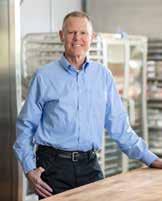


Ardent Mills CEO announces retirement
Daniel P. Dye, who has served as chief executive officer of Ardent Mills LLC since the business was established in May 2014, has announced he will retire later this year Ardent Mills has launched an internal and external search for a successor, and Dye will remain in his post until the next CEO is named and assumes the role.
“Ten years ago, we set out to build a people-first, values-based business and created Ardent Mills. It’s been a privilege to work with a great team to establish our mission, shape our vision, and see the impact we’ve made in nourishing communities across North America,” Dye said. “I am a firm believer that Ardent Mills’ continued, shared success is the result of our team members who live by our values of trust, serving, simplicity and safety, and who have a commitment to serving our customers with excellence. These pillars of Ardent Mills’ culture will continue to drive the business forward and fulfil the company’s commitment to nourish what’s next.”
SFR welcomes new consultant poultry nutritionist
SFR has announced the addition of Eric Le Gall to their team as a Consultant Poultry Nutrition, starting on May 21. With a rich background in animal nutrition and extensive experience in the feed industry, Eric brings a wealth of knowledge and expertise to the company.
Eric, aged 40, hails from Brittany, France, where he was born and raised. He pursued his studies in animal science at ENSAIA in Nancy, graduating in 2006 as an “Ingénieur agronome,” equivalent to an MSc degree.
Over the past 18 years, Eric has dedicated his career to the feed industry, beginning as a feed formulator at ADM in St Nolff, France. He then spent nine years at Metex Animal Nutrition in Paris, promoting amino acid usage to feed producers and premixers. Most recently, Eric served as a nutritionist at Altilis Nutrition Animale in Muzillac, France.
Eric’s commitment to the industry and his collaborative spirit are evident in his previous work with some of our team members. He is eager to reconnect with familiar faces and meet the entire SFR team.
Eric will join the SFR poultry nutrition consultant team to serve ad help Advanced Feed Package customers implementing the SFR feedstuff tables and nutrient recommendations, consult on nutritional challenges in local circumstances and improve the quality/price ratio of produced feeds. SFR say they look forward to the innovative contributions Eric will bring to their team and the advancements in poultry nutrition that they will achieve together
Malteries Soufflet appoints new CEO
Jorge Solis was recently appointed Chief Executive Officer of Malteries Soufflet, the world’s largest malting company following the acquisition of Australia-based United Malt Group in November 2023. Reporting directly to Thierry Blandinières, he will join the InVivo group Executive Committee.
“ I am delighted to be able to welcome Jorge Solis as CEO of Malteries Soufflet today. The breadth and diversity of his career in France and abroad are assets that will contribute to the future success of Malteries Soufflet “, says Thierry Blandinières, CEO of InVivo.
Jorge Solis brings with him 30 years of experience in large international industrial companies, where he has held management positions, first in Mexico and then in the United States, France and Belgium.
Malteries Soufflet, world’s leading maltster since the acquisition of UMG, is now present in key markets in Europe, North America, Latin America, Africa and Asia, with 41 plants across 20 countries, and an annual production capacity of 3.7 million tonnes of malt, serving industrial and artisanal brewers and distillers.
Jorge Solis’ main objective will be to develop both the offer and the target markets, while amplifying the CSR policy enabling Malteries Soufflet to become a leader in the ecological transition on the malt market. He will develop a common culture between the two recently reunited entities, through the implementation of synergies and the deployment of operational excellence.
114 | June 2024 - Milling and Grain

Efficient grinding without compromises

Bühler roller mills continuously redefine grinding performance. Whether it’s wheat, durum, rye, corn or barley, our diverse grinding portfolio is ready to meet all your needs. Explore options like Arrius, Diorit, Dolomit or the brand new Arrakis –Bühler has the answer to your grinding challenges.
Choose the perfect solution that suits your needs.
Contact our grinding specialists at milling@buhlergroup.com or scan the QR-code to know more.

Innovations for a better world.











































 The purifier floor
The purifier floor




 Barron’s D type impact grinder
Mr Edward’s new mill
Barron’s D type impact grinder
Mr Edward’s new mill


































 by Dr Mahmoud Riyad, Secretary-General, Egyptian Milling Association, Egypt
by Dr Mahmoud Riyad, Secretary-General, Egyptian Milling Association, Egypt

















































 Figure 1: Schematic overview of bread wheat composition and components that may be involved in health complaints.
Figure 1: Schematic overview of bread wheat composition and components that may be involved in health complaints.







 characteristics of the wheat-related disorders. CD-celiac disease, WA-wheat allergy, NCWS/NCGS-self-reported wheat/ gluten sensitivity in the absence of celiac disease. In a Dutch study this figure was 6.2 percent. *Based on testing after a period of
characteristics of the wheat-related disorders. CD-celiac disease, WA-wheat allergy, NCWS/NCGS-self-reported wheat/ gluten sensitivity in the absence of celiac disease. In a Dutch study this figure was 6.2 percent. *Based on testing after a period of












































 by Jade Wouters, Product Manager & Kurt Van de Mierop, Director, Nutrex, Belgium
by Jade Wouters, Product Manager & Kurt Van de Mierop, Director, Nutrex, Belgium















































































































































































 Andy Wang, Michael Hao, Gordon Guo of Famsun, China
The Alapala team. Alapala Machine, of Türkiye, builds turnkey plants of any desired capacity and is one of the top 1000 exporters in Turkey, exporting 95 percent of its production. It has a considerable number of turnkey references in over 100 countries including developed countries such as Germany, France and the USA
Lee Deon, Agah Yegin, Ali Goktas, Muhammet Bozkurt, Zekai Kivrim, Gokcen Goktas, Mesut Yegin, Sani Kandemir, Sefa Yegin from Yenar of Türkiye. Yenar has been operating in the sector for more than 25 years, with its state-of-the-art modern production facilities built on a total area of 40,000 square metres
Emre Ereren of Imas, Türkiye
The Milltec team. Milltec manufacture and supplies a complete range of rice milling machines including cleaning, husking, whitening, polishing, grading, sorting and packaging machines to meet rice processing requirements
Andy Wang, Michael Hao, Gordon Guo of Famsun, China
The Alapala team. Alapala Machine, of Türkiye, builds turnkey plants of any desired capacity and is one of the top 1000 exporters in Turkey, exporting 95 percent of its production. It has a considerable number of turnkey references in over 100 countries including developed countries such as Germany, France and the USA
Lee Deon, Agah Yegin, Ali Goktas, Muhammet Bozkurt, Zekai Kivrim, Gokcen Goktas, Mesut Yegin, Sani Kandemir, Sefa Yegin from Yenar of Türkiye. Yenar has been operating in the sector for more than 25 years, with its state-of-the-art modern production facilities built on a total area of 40,000 square metres
Emre Ereren of Imas, Türkiye
The Milltec team. Milltec manufacture and supplies a complete range of rice milling machines including cleaning, husking, whitening, polishing, grading, sorting and packaging machines to meet rice processing requirements










 The Çukurova Silo team. Çukurova Silo specialises in the production of silos and equipment in its facilities equipped with the most advanced technology. This Turkish company has established turnkey grain storage facilities in more than 90 countries
Sedat Demirbas, Ridha Kaaniche of Altinbilek of Türkiye
The Tanis team. Tanis has been leading organisations in Türkiye of the agriculture-based industry since 1956. It produces flour, semolina, corn flour, bulgur and lentil processing equipment. Its factory is established on an area of 25.000 square metres in Gaziantep, using the most advanced technologies in capacities, building and construction required on a turnkey basis
The Çukurova Silo team. Çukurova Silo specialises in the production of silos and equipment in its facilities equipped with the most advanced technology. This Turkish company has established turnkey grain storage facilities in more than 90 countries
Sedat Demirbas, Ridha Kaaniche of Altinbilek of Türkiye
The Tanis team. Tanis has been leading organisations in Türkiye of the agriculture-based industry since 1956. It produces flour, semolina, corn flour, bulgur and lentil processing equipment. Its factory is established on an area of 25.000 square metres in Gaziantep, using the most advanced technologies in capacities, building and construction required on a turnkey basis




















 Zeki Demirtaşoğlu, Bastak of Türkiye
Bora Mehmet Sağbili, General Manager, Sagbil Packaging Machines
Bahadir Arcan, Sales Coordinator, My Silo with Mehmet Uğur Gürkaynak, Milling and Grain
Ismail Kunduraci of Selis, Türkiye
Filiz Aybakar, Aybakar of Türkiye
Zeki Demirtaşoğlu, Bastak of Türkiye
Bora Mehmet Sağbili, General Manager, Sagbil Packaging Machines
Bahadir Arcan, Sales Coordinator, My Silo with Mehmet Uğur Gürkaynak, Milling and Grain
Ismail Kunduraci of Selis, Türkiye
Filiz Aybakar, Aybakar of Türkiye















































